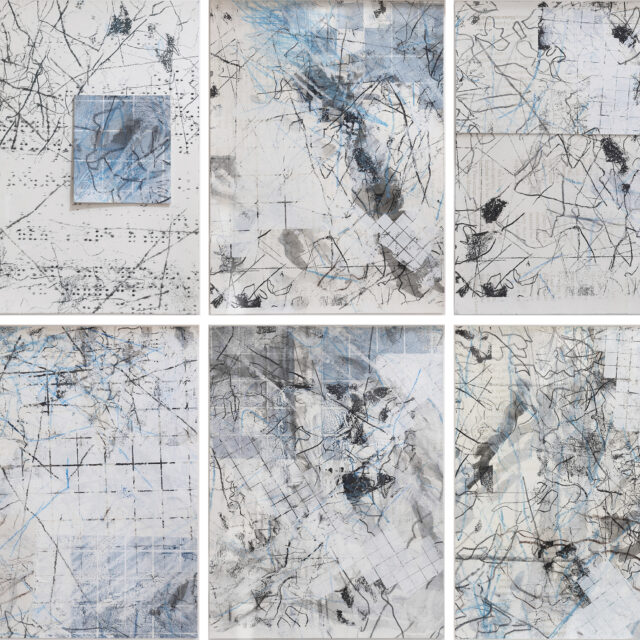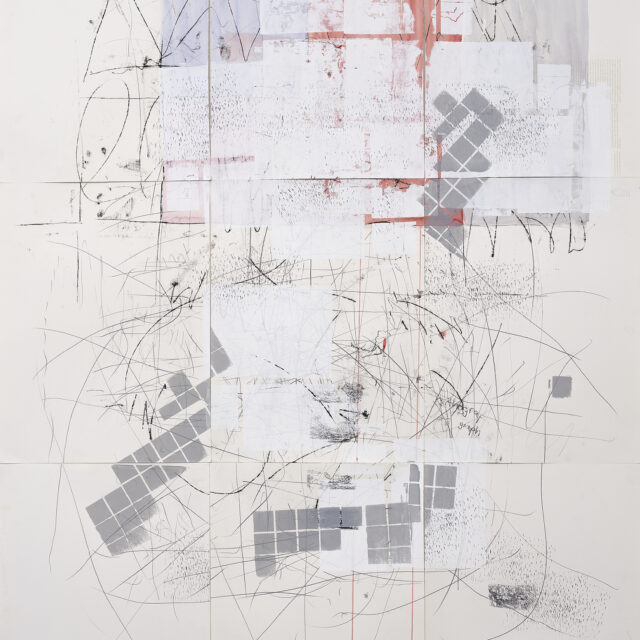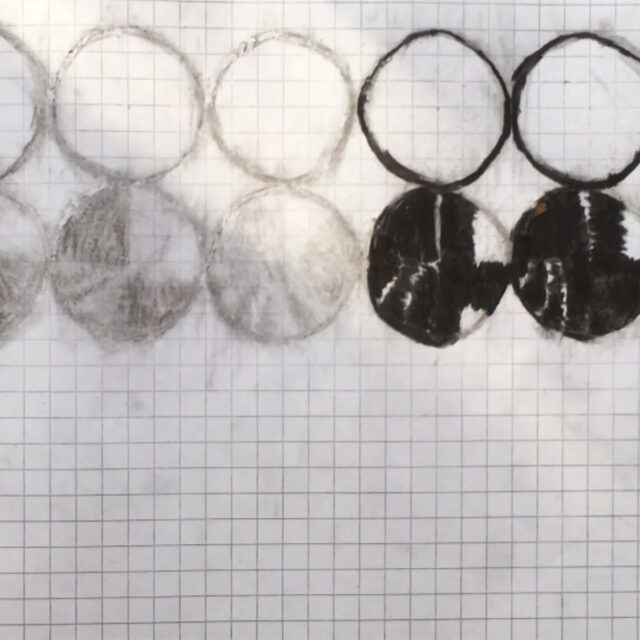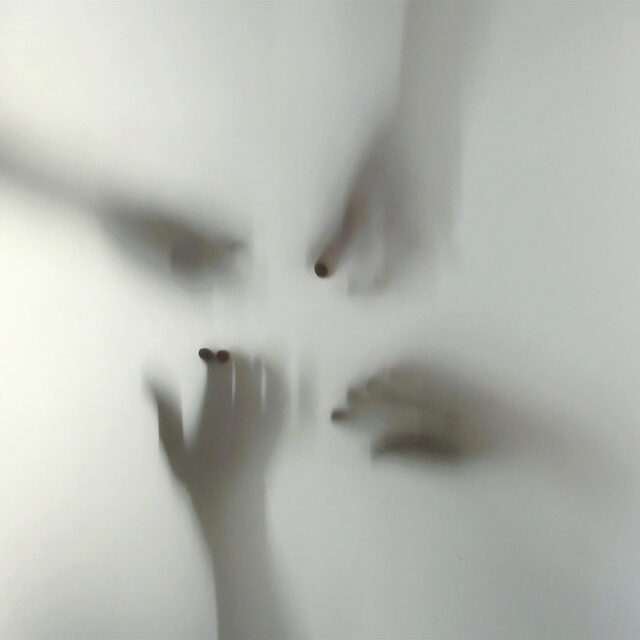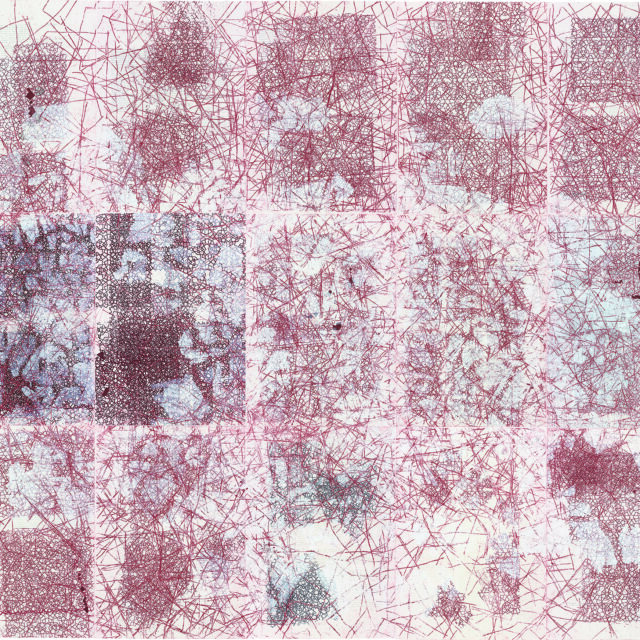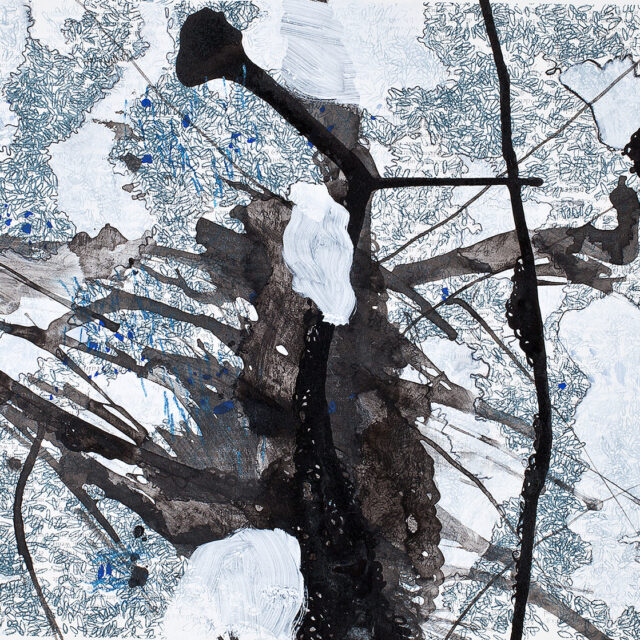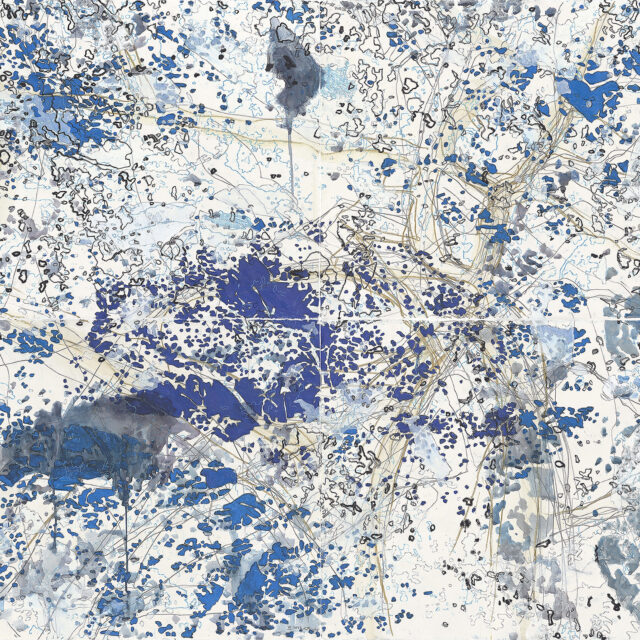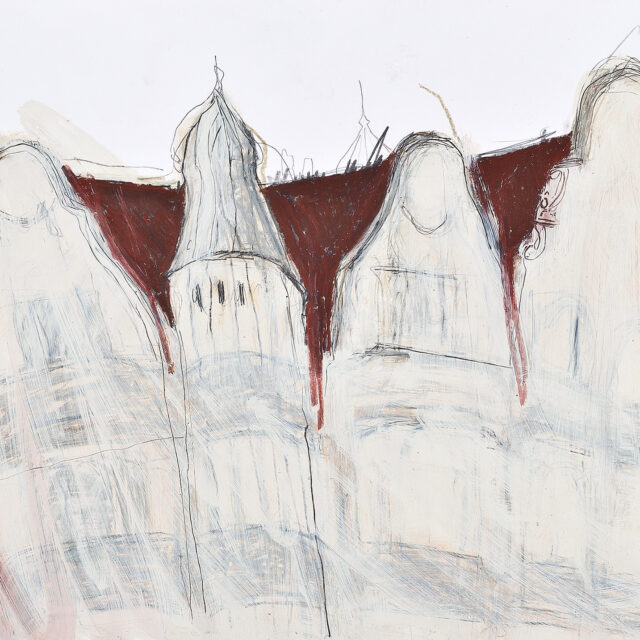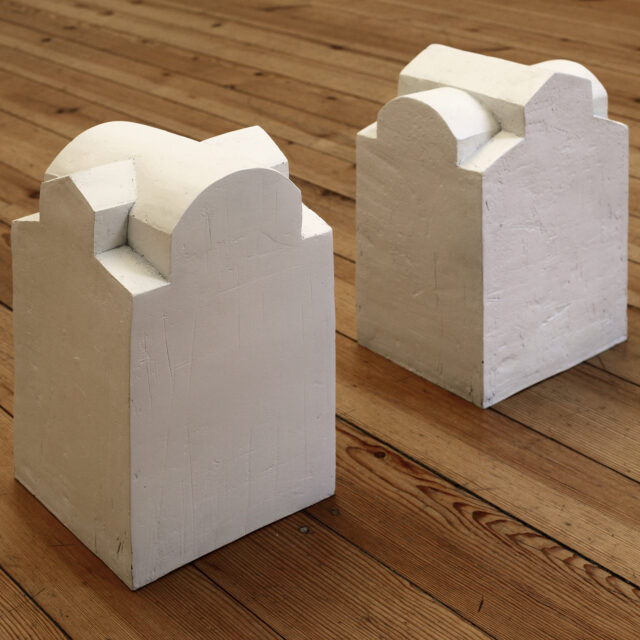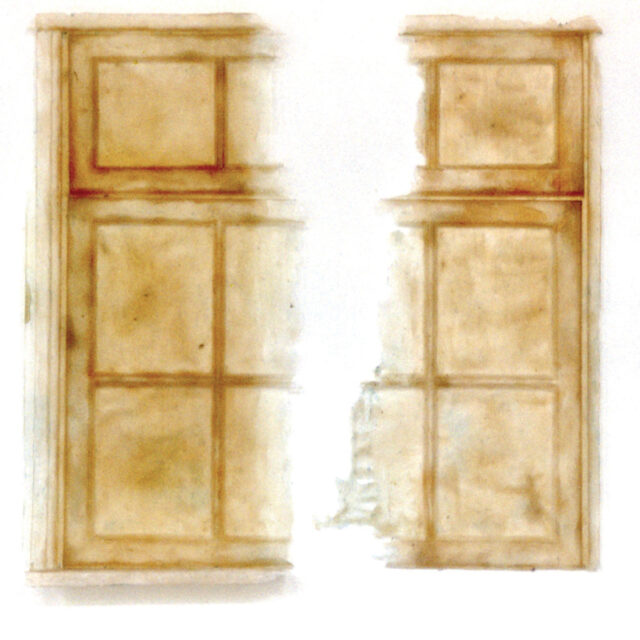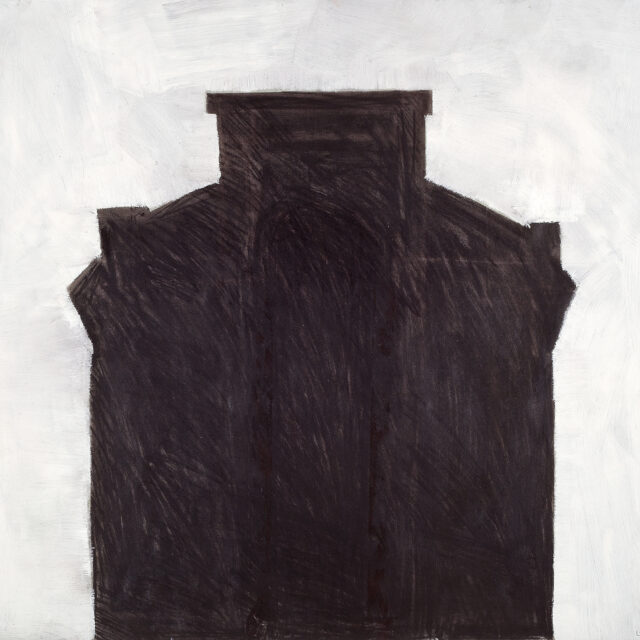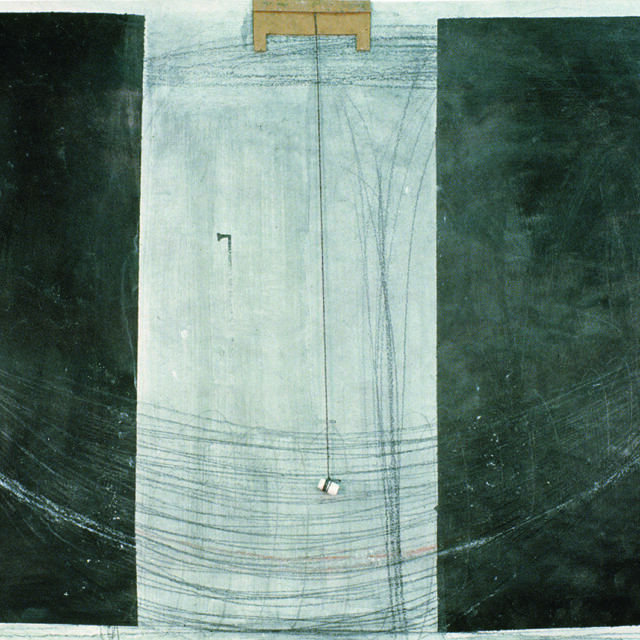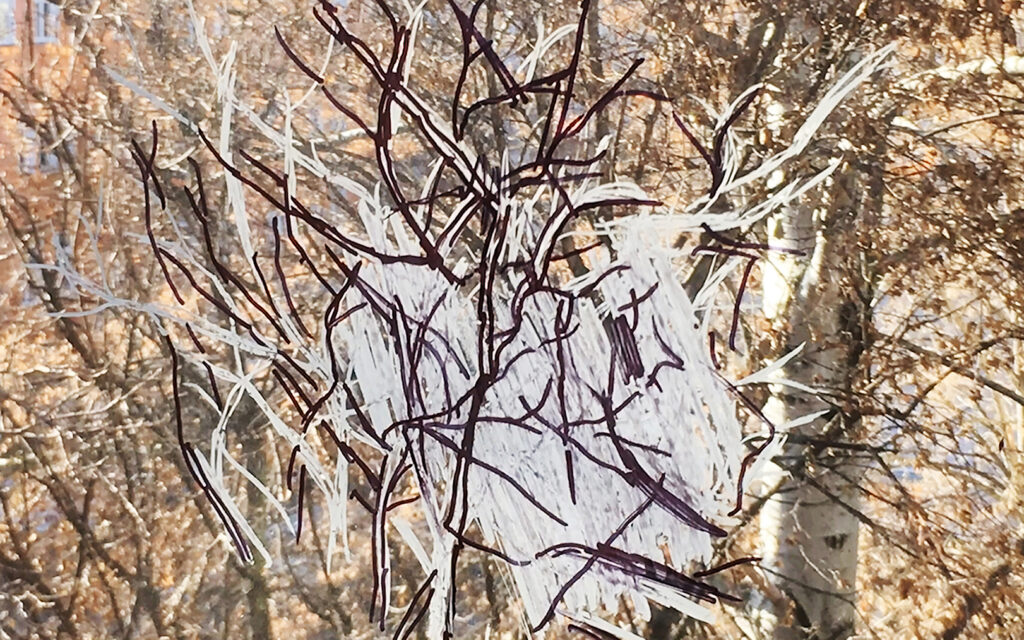
Four Steps still / 01 2020 / video HD / colour, sound / 08:42 min.
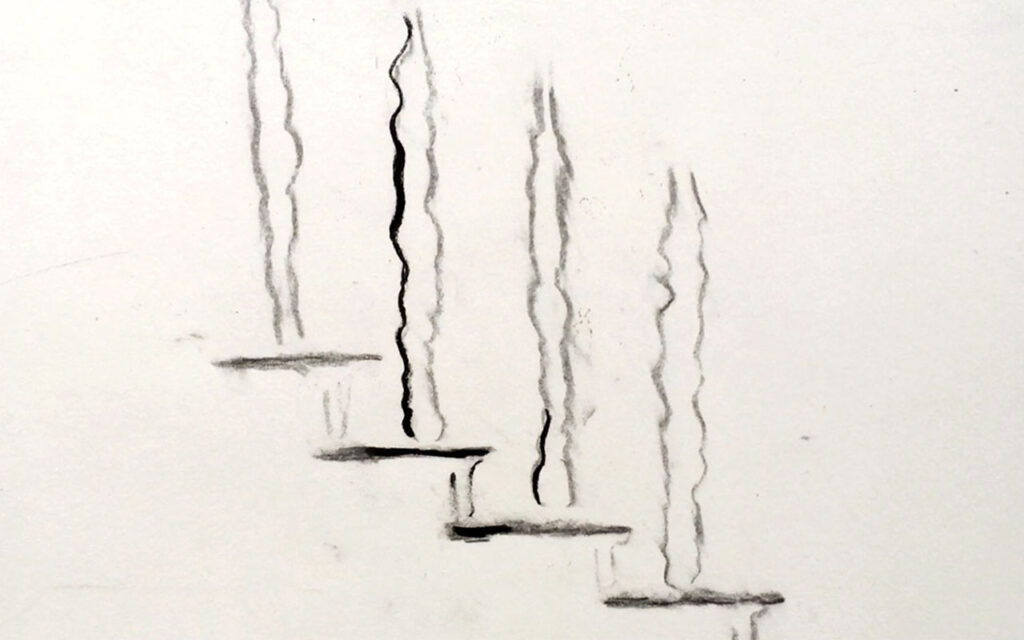
Four Steps still / 01 2020 / video HD / colour, sound / 08:42 min.
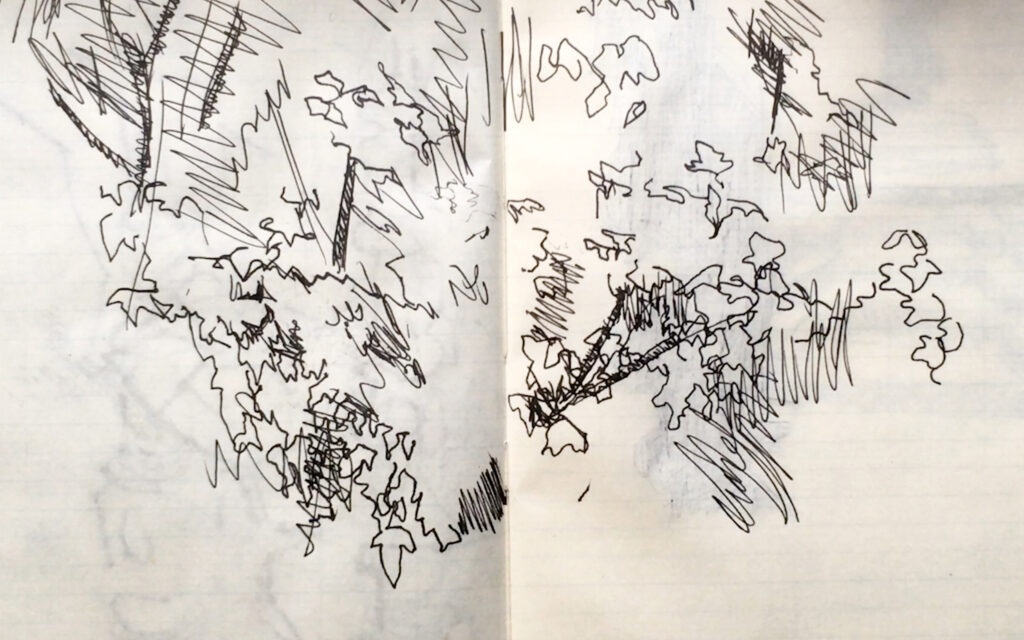
Four Steps still / 01 2020 / video HD / colour, sound / 08:42 min.
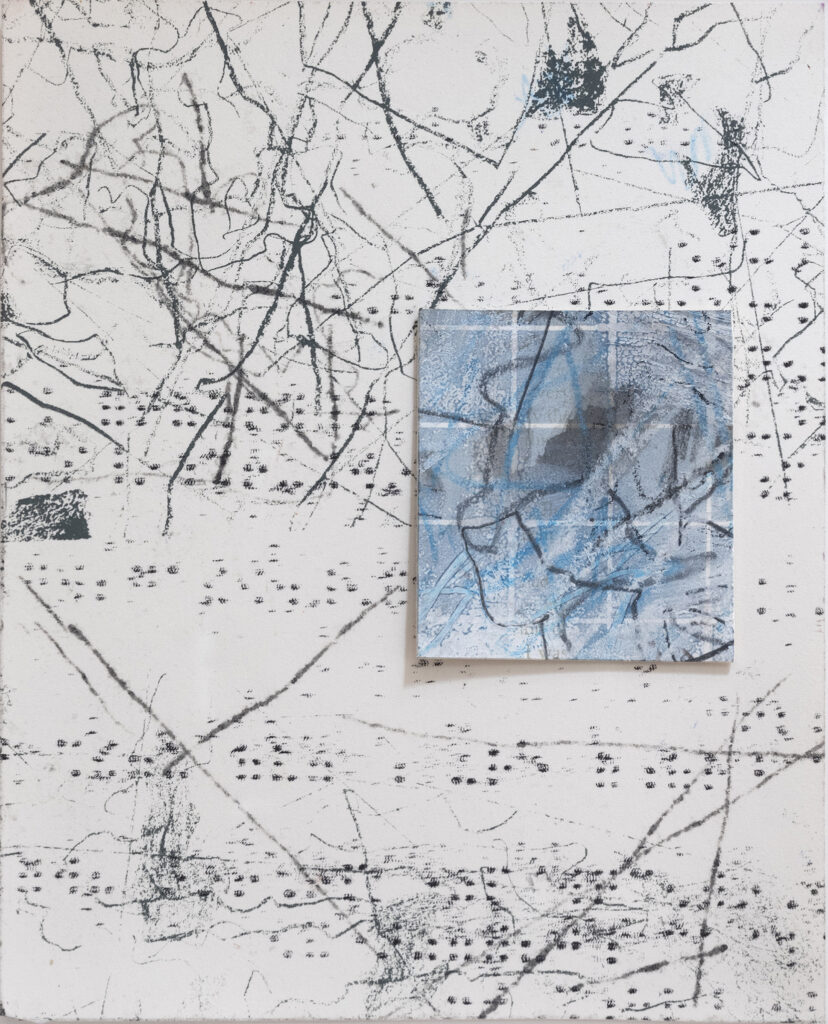
Backyard No.1 02 2020 / 14,5 x 18,5 cm / gouache, oil, colored pencil, wax crayon tracing on paper
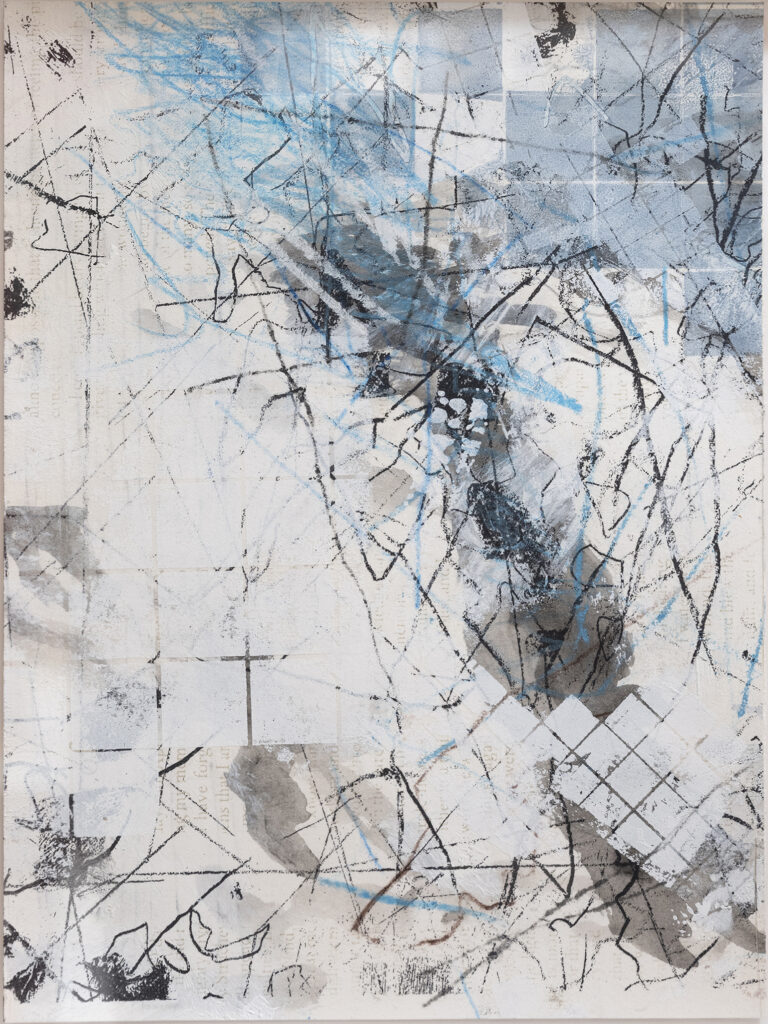
Backyard No.2 02 2020 / 14,5 x 18,5 cm / gouache, oil, colored pencil, wax crayon tracing on paper
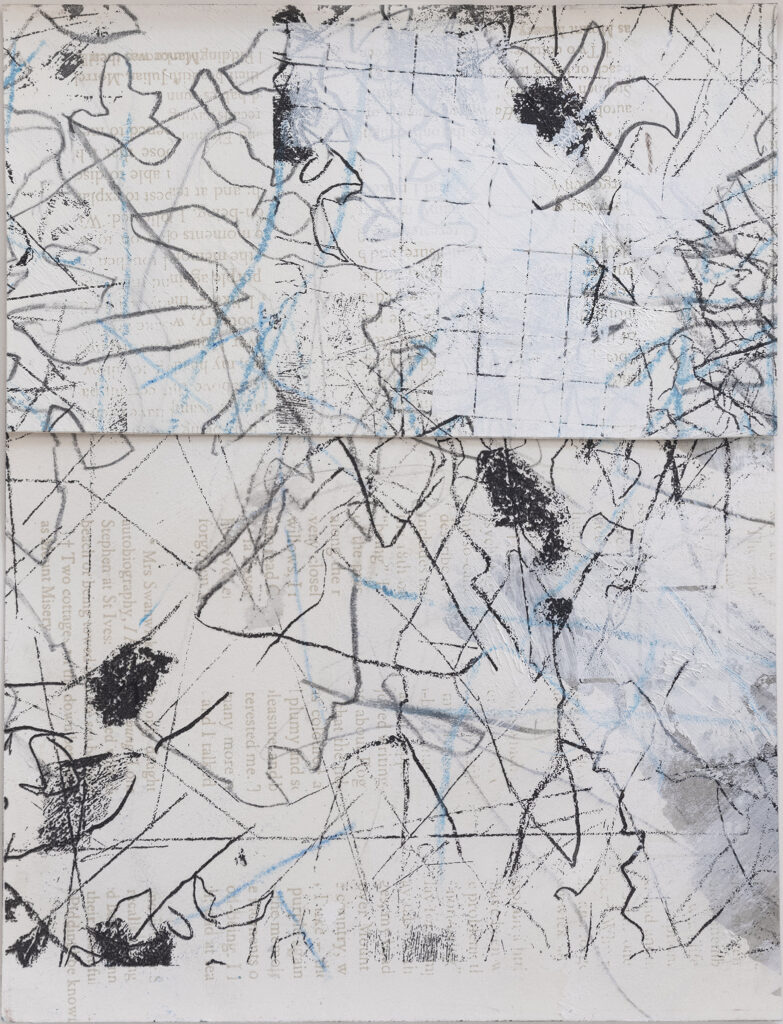
Backyard No.3 02 2020 / 14,5 x 18,5 cm / gouache, oil, colored pencil, wax crayon tracing on paper
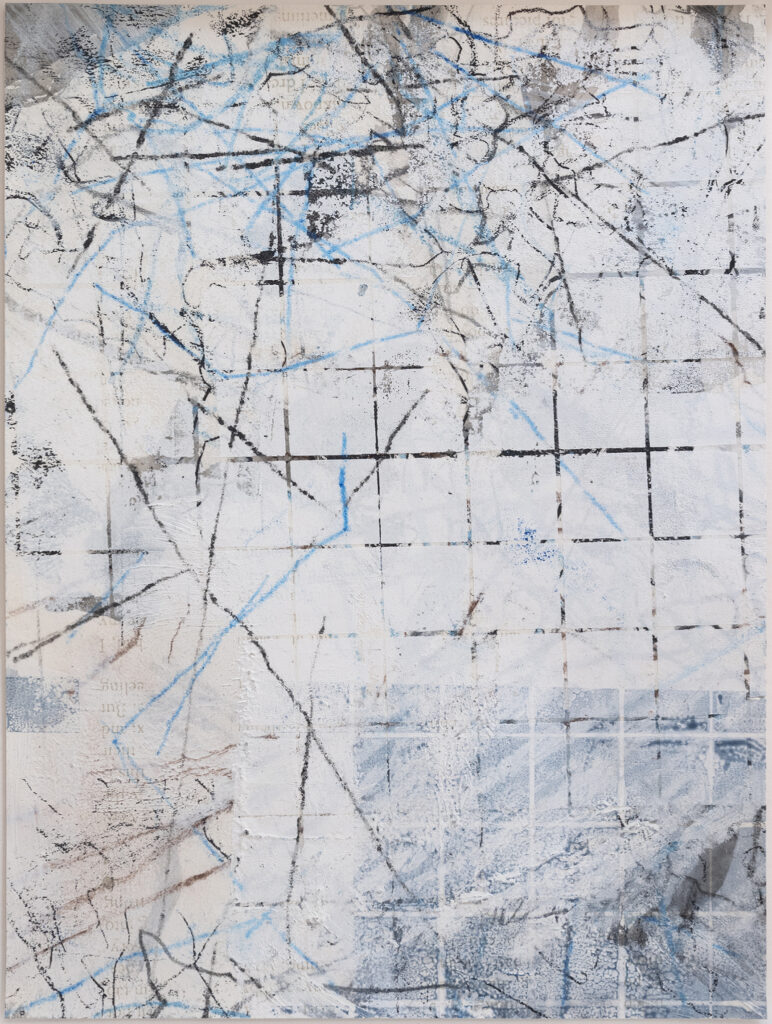
Backyard No.4 02 2020 / 14,5 x 18,5 cm / gouache, oil, colored pencil, wax crayon tracing on paper

Backyard No.5 02 2020 / 14,5 x 18,5 cm / gouache, oil, colored pencil, wax crayon tracing on paper

Backyard No.6 02 2020 / 14,5 x 18,5 cm / gouache, oil, colored pencil, wax crayon tracing on paper
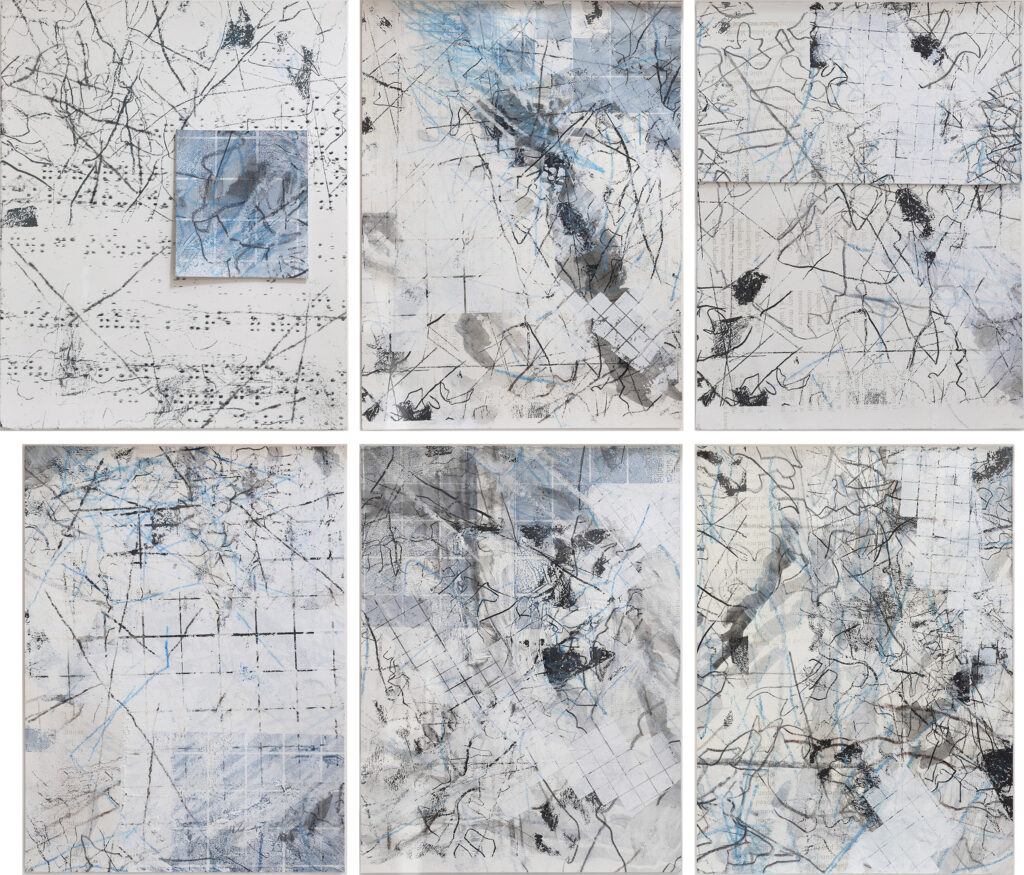
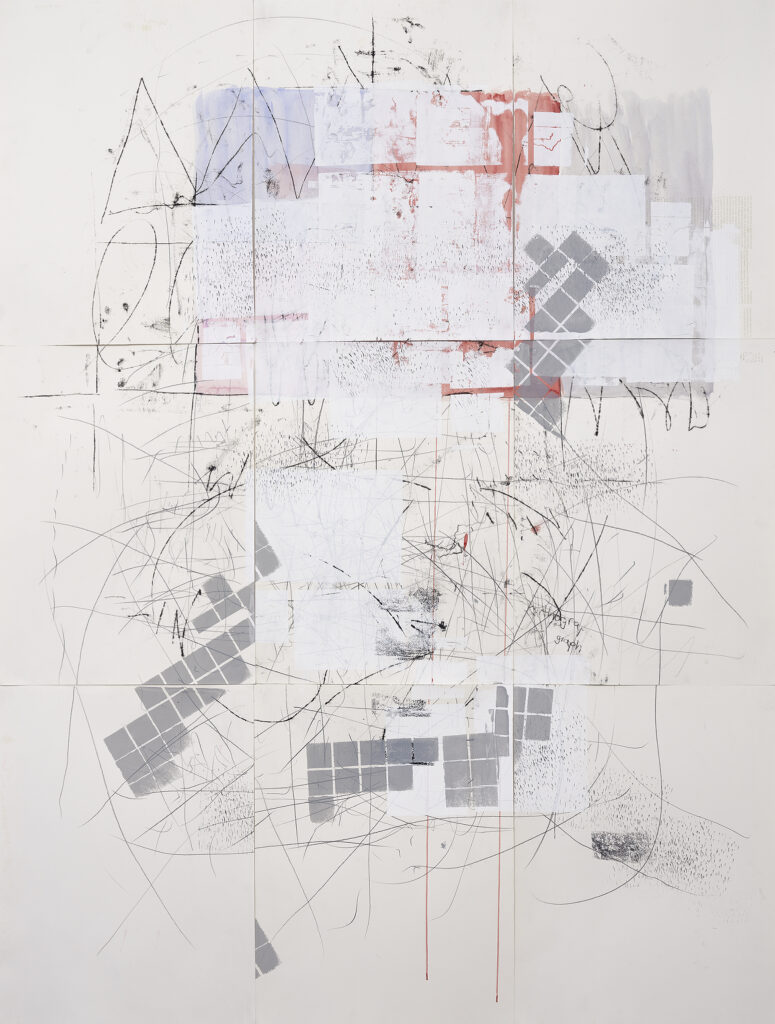
Quartett No.1 08 2019 / 138 x 183 cm / gouache, oil, water colour, pencil on paper
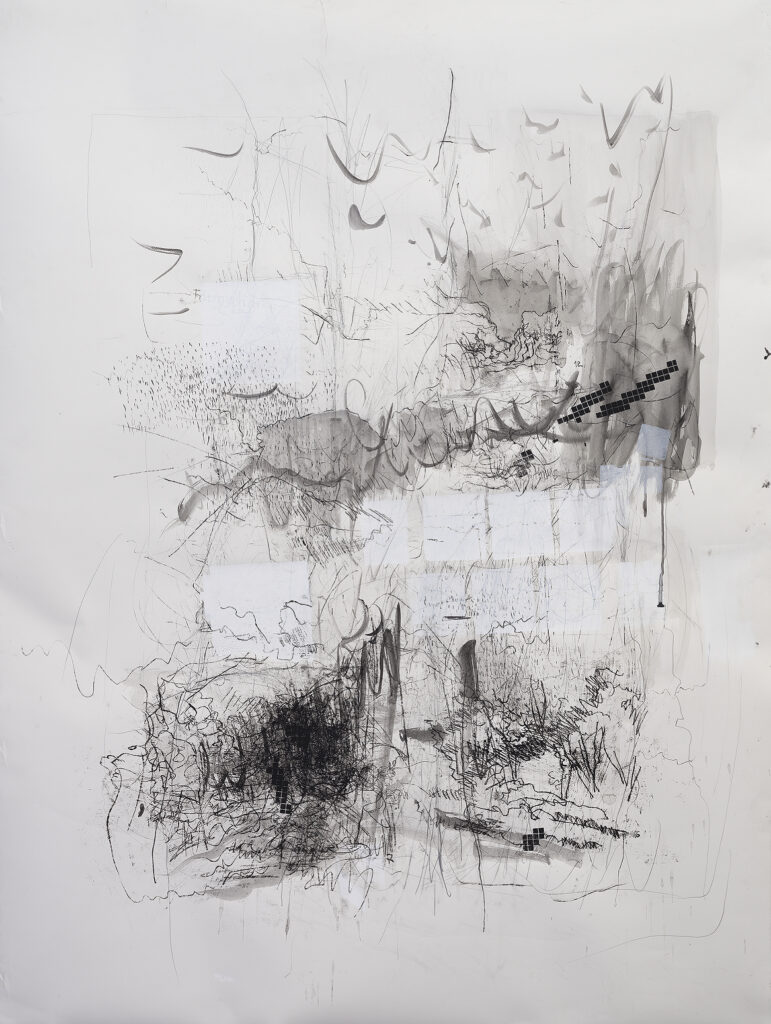
Quartett No.2 09 2019 / 110 x 150 cm / gouache, oil, water colour, pencil on paper
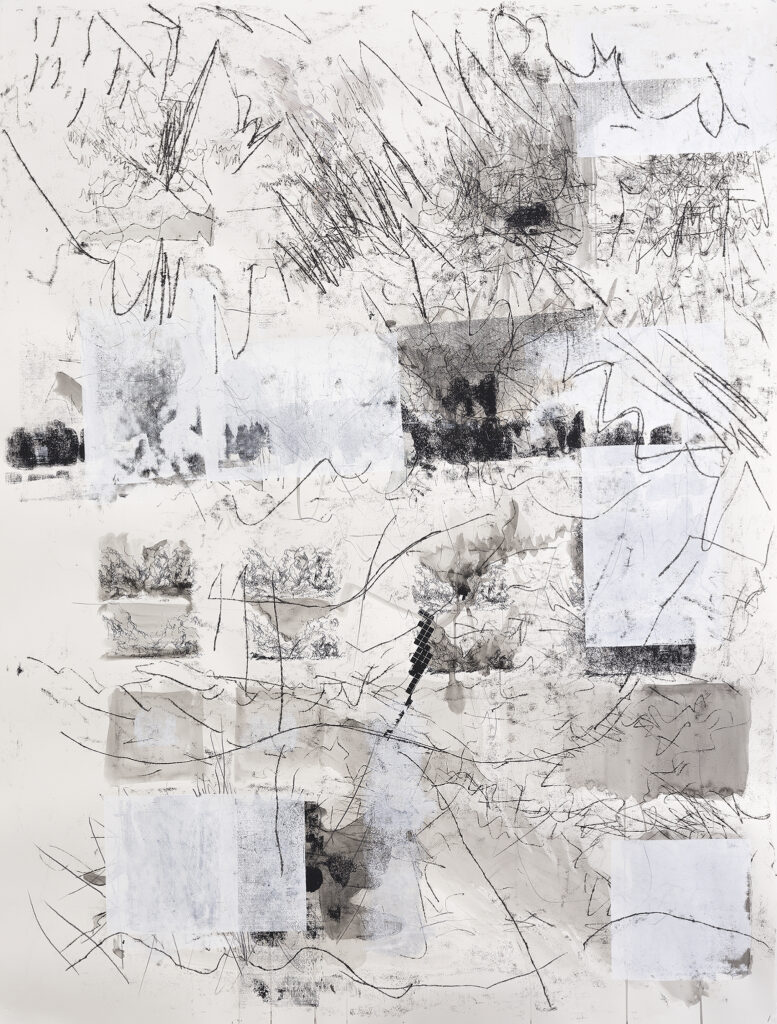
Quartett No.3 10 2019 / 110 x 150 cm / gouache, oil, water colour, pencil on paper
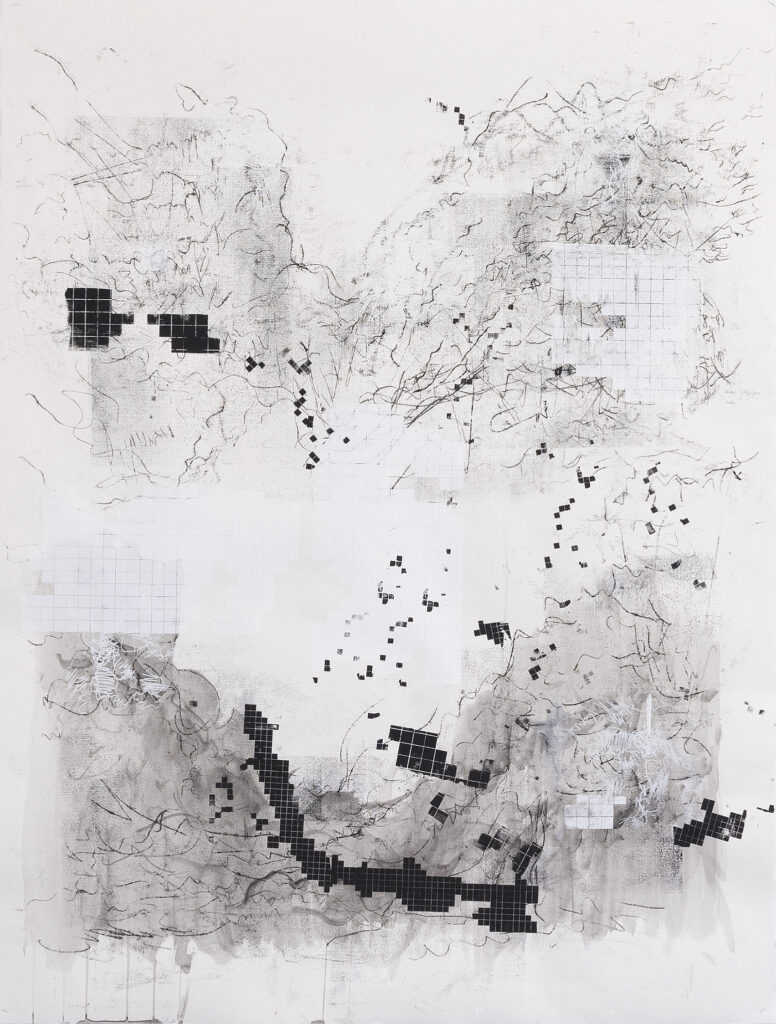
Quartett No.4 12 2019 / 110 x 150 cm / gouache, oil, water colour, pencil on paper
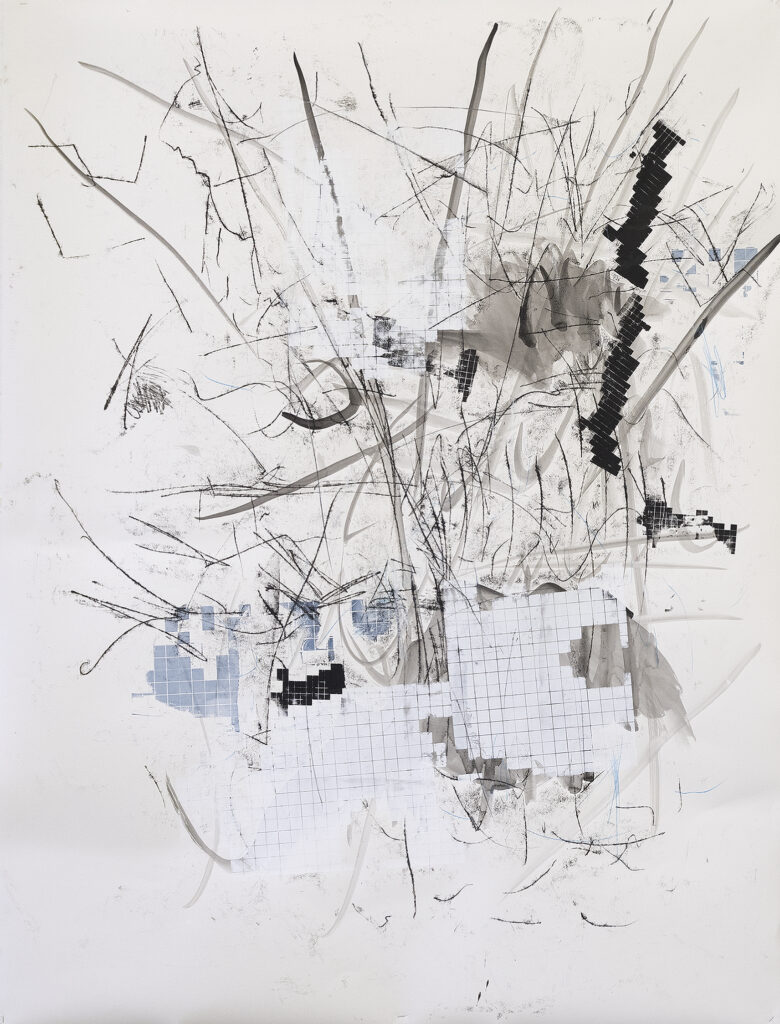
Quartett No.5 01 2020 / 110 x 150 cm / gouache, oil, water colour, pencil on paper
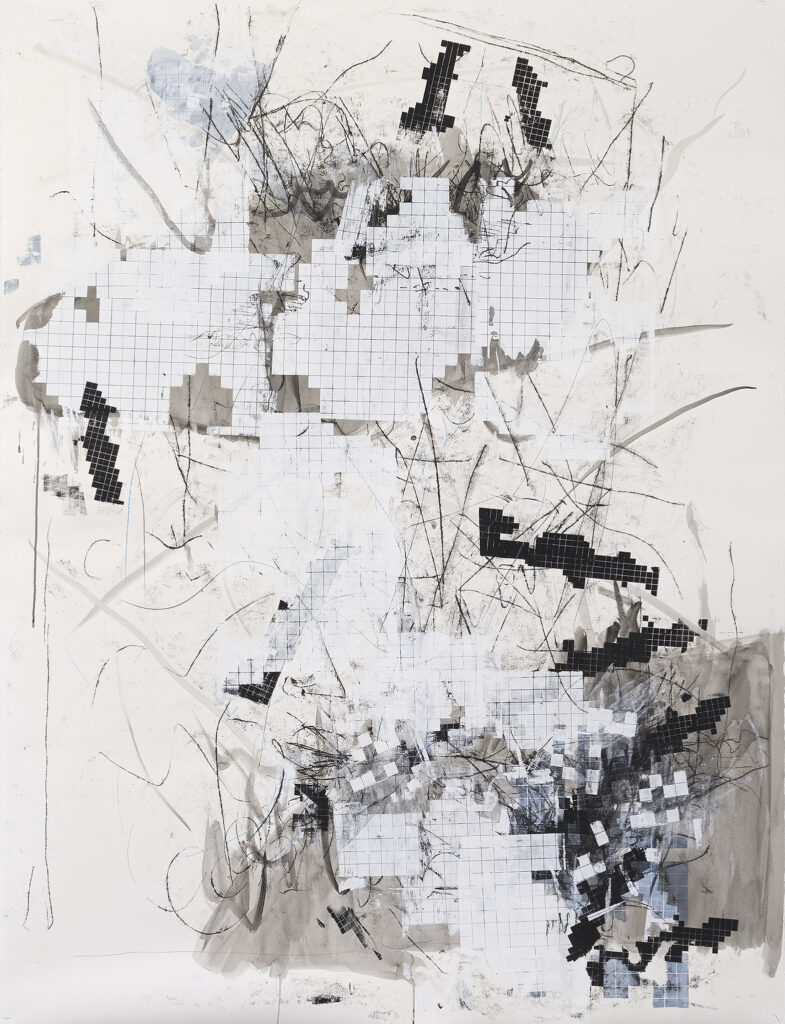
Quartett No.6 01 2020 / 110 x 150 cm / gouache, oil, water colour, pencil on paper
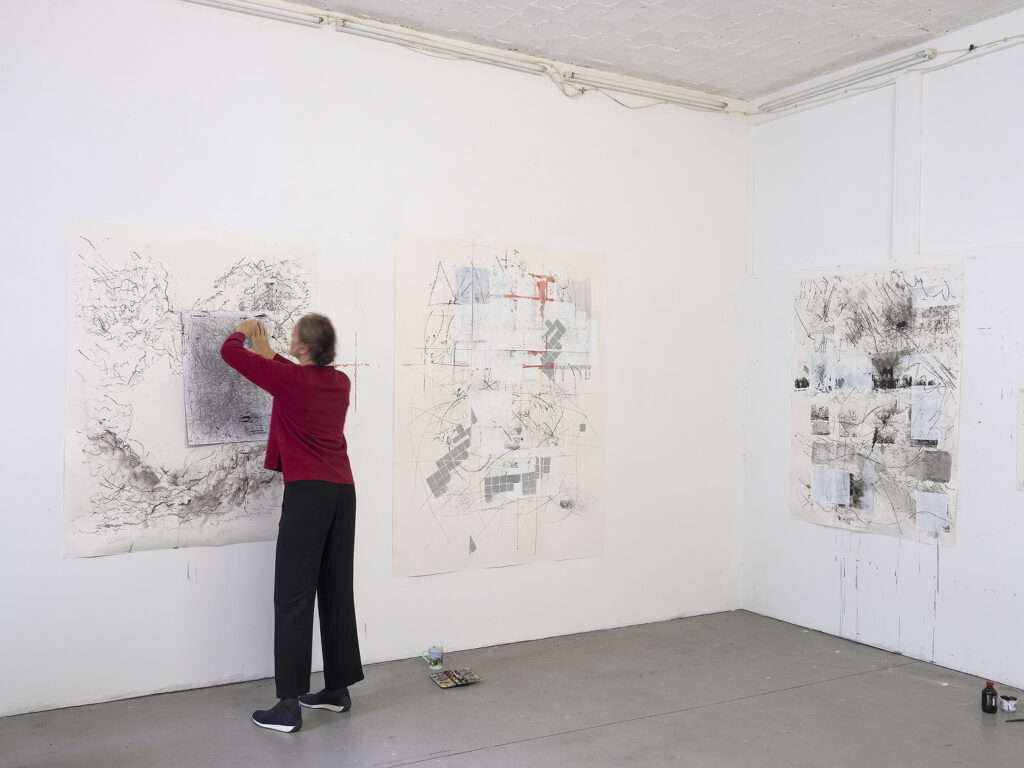
studio view / 01 2020

studio view / 01 2020
A Conversation with Uniformity
about the film Circle Phases
In the Minimal Arts of the 1960s, the circle is a recurring form. When listening to Steve Reich´s composition Violin Phase (1967) I associated the regular, harmonious shape to the repetative musical one-bar motif he uses.
With my hand I draw the circle again and again, dividing it into 12 parts in which the animated circle is reestablished again and again, following the time of the music. By sheer chance, the time-consuming animation film also shows the change of season and the continuous change of light (it was shot between October until December 2017).The play of harsh light and deep blue shadow on the paper inscribe themselves into the image like the charcoal line on the paper. Eventually, the paper tears open from persistant usage. Behind the tear, the working surface becomes visable.
The animation is consciously relinquishing a synchrony with the music. The resulting postponements between music and image emphazise the claim this complex music makes: the technical brilliance of the violinist is opposed by specifically composed spaces for free choice of time. The musician, usually bound to follow a given time, is to realize his very own time. When this is individualized time-keeping is played out, the musical space seems to whirr around with uncertainty. The tention is held until the musicians reach the next motif and their voices find together again.
In the way that the musicians always find each other again musically, in the same way the images follow the music. It is this tention that makes this music so potent. It is determined by the pendular movement of the four violin voices which are sometimes individually set apart, then come together again.
Reich´s music seems like a struggle for positioning himself between technology and human action. Like his composition, this film is like a conversation with the uniformity of technical perfection.
Lara Faroqhi, January 2018
Credits
Circle Phases by Lara Faroqhi
Germany / 2018 / Video HD, format: 1:1,66, solution: 1920 x 1080 / colour, sound / duration: 10,12 Min., images per second: 7
Titles
Circle Phases by Lara Faroqhi
Inspired by “Violin Phase” (1967) by Steve Reich
This film was developed and first presented at the Former Silent Movie Theatre Delphi, Berlin, on 25. January 2018.
Recording: sound recording of the performance night
Performance: scholarship holders of the Orchestra Academy and members of the Radio Symphony Orchestra Berlin
Conductor: Steffen Tast
© Lara Faroqhi
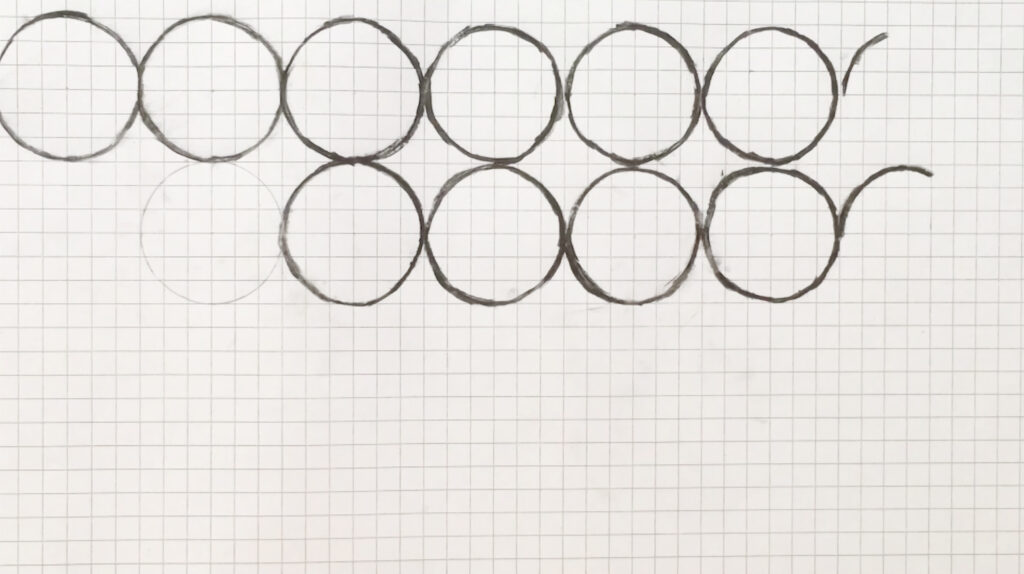
Circle Phases still / 2018 / video HD / format: 1:1,66 / solution: 1920 x 1080 / colour, sound / 10,12 min.
A Conversation with Uniformity
about the film Circle Phases
In the Minimal Arts of the 1960s, the circle is a recurring form. When listening to Steve Reich´s composition Violin Phase (1967) I associated the regular, harmonious shape to the repetative musical one-bar motif he uses.
With my hand I draw the circle again and again, dividing it into 12 parts in which the animated circle is reestablished again and again, following the time of the music. By sheer chance, the time-consuming animation film also shows the change of season and the continuous change of light (it was shot between October until December 2017).The play of harsh light and deep blue shadow on the paper inscribe themselves into the image like the charcoal line on the paper. Eventually, the paper tears open from persistant usage. Behind the tear, the working surface becomes visable.
The animation is consciously relinquishing a synchrony with the music. The resulting postponements between music and image emphazise the claim this complex music makes: the technical brilliance of the violinist is opposed by specifically composed spaces for free choice of time. The musician, usually bound to follow a given time, is to realize his very own time. When this is individualized time-keeping is played out, the musical space seems to whirr around with uncertainty. The tention is held until the musicians reach the next motif and their voices find together again.
In the way that the musicians always find each other again musically, in the same way the images follow the music. It is this tention that makes this music so potent. It is determined by the pendular movement of the four violin voices which are sometimes individually set apart, then come together again.
Reich´s music seems like a struggle for positioning himself between technology and human action. Like his composition, this film is like a conversation with the uniformity of technical perfection.
Lara Faroqhi, January 2018
Credits
Circle Phases by Lara Faroqhi
Germany / 2018 / Video HD, format: 1:1,66, solution: 1920 x 1080 / colour, sound / duration: 10,12 Min., images per second: 7
Titles
Circle Phases by Lara Faroqhi
Inspired by “Violin Phase” (1967) by Steve Reich
This film was developed and first presented at the Former Silent Movie Theatre Delphi, Berlin, on 25. January 2018.
Recording: sound recording of the performance night
Performance: scholarship holders of the Orchestra Academy and members of the Radio Symphony Orchestra Berlin
Conductor: Steffen Tast
© Lara Faroqhi
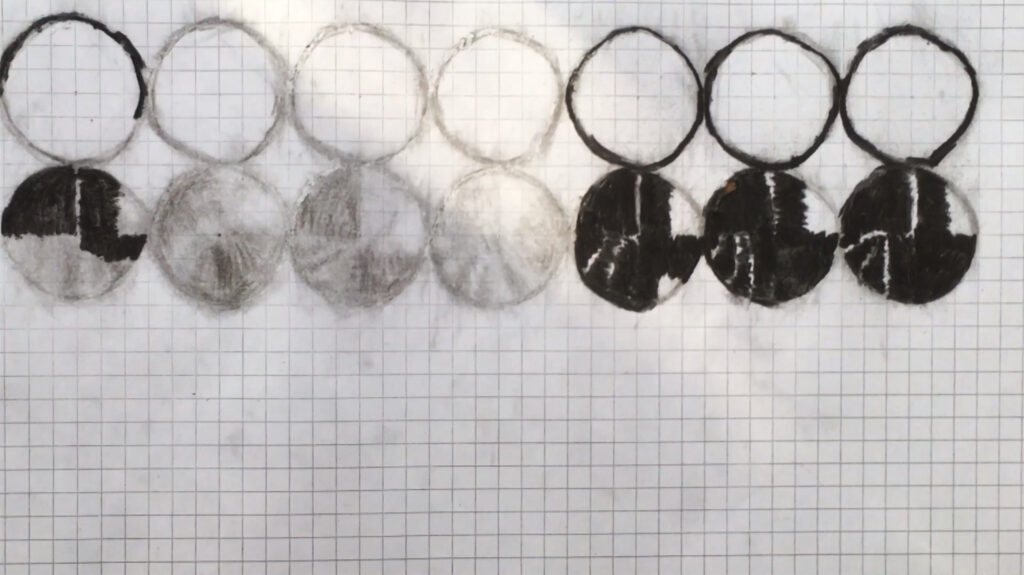
Circle Phases still
A Conversation with Uniformity
about the film Circle Phases
In the Minimal Arts of the 1960s, the circle is a recurring form. When listening to Steve Reich´s composition Violin Phase (1967) I associated the regular, harmonious shape to the repetative musical one-bar motif he uses.
With my hand I draw the circle again and again, dividing it into 12 parts in which the animated circle is reestablished again and again, following the time of the music. By sheer chance, the time-consuming animation film also shows the change of season and the continuous change of light (it was shot between October until December 2017).The play of harsh light and deep blue shadow on the paper inscribe themselves into the image like the charcoal line on the paper. Eventually, the paper tears open from persistant usage. Behind the tear, the working surface becomes visable.
The animation is consciously relinquishing a synchrony with the music. The resulting postponements between music and image emphazise the claim this complex music makes: the technical brilliance of the violinist is opposed by specifically composed spaces for free choice of time. The musician, usually bound to follow a given time, is to realize his very own time. When this is individualized time-keeping is played out, the musical space seems to whirr around with uncertainty. The tention is held until the musicians reach the next motif and their voices find together again.
In the way that the musicians always find each other again musically, in the same way the images follow the music. It is this tention that makes this music so potent. It is determined by the pendular movement of the four violin voices which are sometimes individually set apart, then come together again.
Reich´s music seems like a struggle for positioning himself between technology and human action. Like his composition, this film is like a conversation with the uniformity of technical perfection.
Lara Faroqhi, January 2018
Credits
Circle Phases by Lara Faroqhi
Germany / 2018 / Video HD, format: 1:1,66, solution: 1920 x 1080 / colour, sound / duration: 10,12 Min., images per second: 7
Titles
Circle Phases by Lara Faroqhi
Inspired by “Violin Phase” (1967) by Steve Reich
This film was developed and first presented at the Former Silent Movie Theatre Delphi, Berlin, on 25. January 2018.
Recording: sound recording of the performance night
Performance: scholarship holders of the Orchestra Academy and members of the Radio Symphony Orchestra Berlin
Conductor: Steffen Tast
© Lara Faroqhi
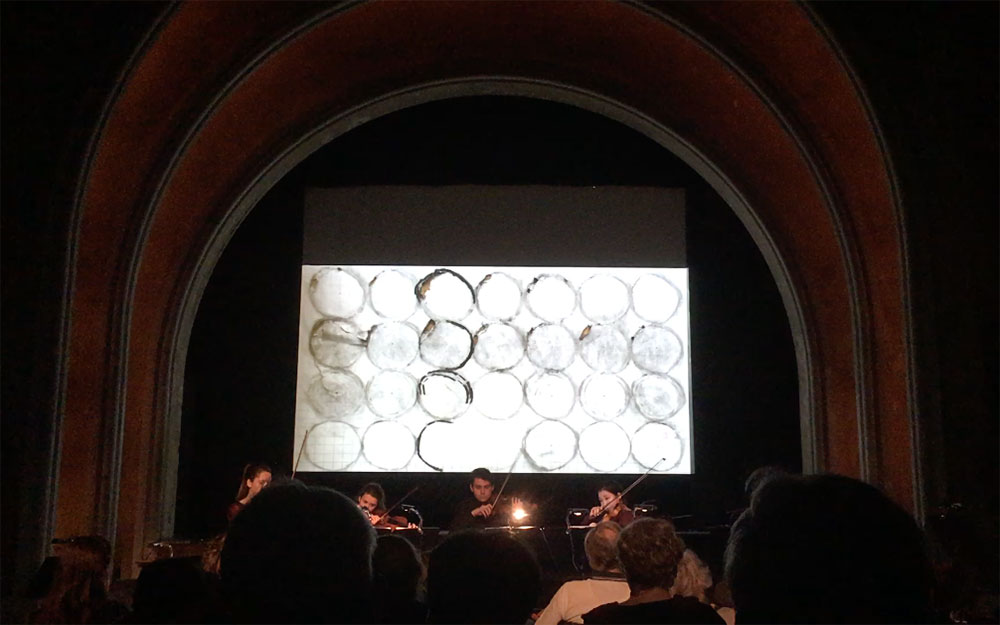
Concert at the Former Silent Cinema Delphi with scholarship holders of the Orchestra Academy and members of the Rundfunk-Sinfonieorchester Berlin conducted by Steffen Tast, on 25th January 2018.
Measuring Space
About the film Contrapunctus XI
“The Art of the Fugue” is J. S. Bach´s last composition, written in the 1740ies. He was not able to complete the piece. It remained a fragment. However, it´s form is extremely refined even in its incomplete form which surely enhances the attraction of this music.
In the piece, Bach invents fugues, introducing coherent musical patterns and segments which are being correlated to other voices. Furthermore, Bach plays with his musical ideas, by mirroring them, expanding or compressing them, cutting them up or using elements of the theme to develop them in new directions or returning to the beginning motif while simultaneously inventing new ones.
The films Contrapunctus I and Contrapunctus IX don´t show the musicians playing this complex music. On the contrary: they only play theoretically, their hands act physically removed from their instruments. Thus, the action of performing this fugue is at the foreground.
Lara Faroqhi, April 2019
Text published in the catalogue “Zum Zufall – Schriftenreihe Band 6”, 2019, Wills Neuhaus Stiftung – Zufall und Gestaltung on the occasion of the exhibition Fragment at Guardini Galerie
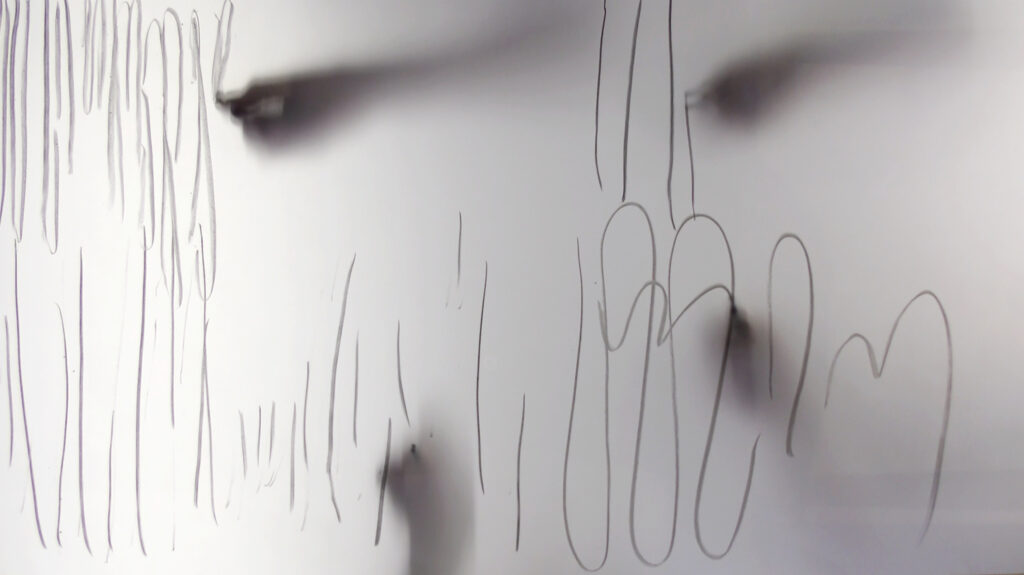
Contrapunctus I still / 2017 / video HD / solution: 1920 x 1080 / colour, sound / 5,08 min.
Measuring Space
About the film Contrapunctus XI
“The Art of the Fugue” is J. S. Bach´s last composition, written in the 1740ies. He was not able to complete the piece. It remained a fragment. However, it´s form is extremely refined even in its incomplete form which surely enhances the attraction of this music.
In the piece, Bach invents fugues, introducing coherent musical patterns and segments which are being correlated to other voices. Furthermore, Bach plays with his musical ideas, by mirroring them, expanding or compressing them, cutting them up or using elements of the theme to develop them in new directions or returning to the beginning motif while simultaneously inventing new ones.
The films Contrapunctus I and Contrapunctus IX don´t show the musicians playing this complex music. On the contrary: they only play theoretically, their hands act physically removed from their instruments. Thus, the action of performing this fugue is at the foreground.
Lara Faroqhi, April 2019
Text published in the catalogue “Zum Zufall – Schriftenreihe Band 6”, 2019, Wills Neuhaus Stiftung – Zufall und Gestaltung on the occasion of the exhibition Fragment at Guardini Galerie
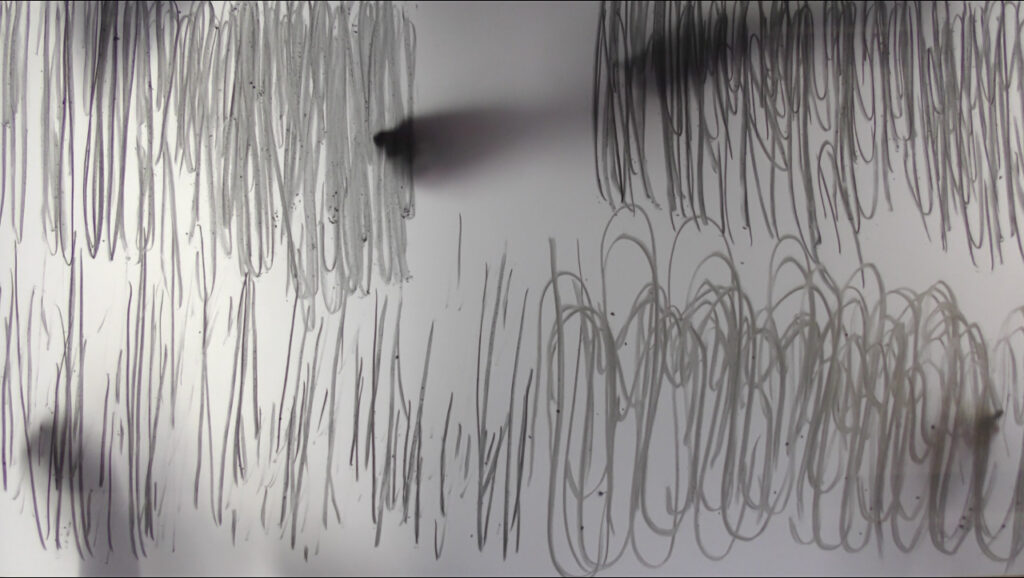
Contrapunctus I still / 01 2017 / video HD / colour, sound / 5:15 min.
Measuring Space
About the film Contrapunctus XI
“The Art of the Fugue” is J. S. Bach´s last composition, written in the 1740ies. He was not able to complete the piece. It remained a fragment. However, it´s form is extremely refined even in its incomplete form which surely enhances the attraction of this music.
In the piece, Bach invents fugues, introducing coherent musical patterns and segments which are being correlated to other voices. Furthermore, Bach plays with his musical ideas, by mirroring them, expanding or compressing them, cutting them up or using elements of the theme to develop them in new directions or returning to the beginning motif while simultaneously inventing new ones.
The films Contrapunctus I and Contrapunctus IX don´t show the musicians playing this complex music. On the contrary: they only play theoretically, their hands act physically removed from their instruments. Thus, the action of performing this fugue is at the foreground.
Lara Faroqhi, April 2019
Text published in the catalogue “Zum Zufall – Schriftenreihe Band 6”, 2019, Wills Neuhaus Stiftung – Zufall und Gestaltung on the occasion of the exhibition Fragment at Guardini Galerie

Contrapunctus XI still / 2017 / video HD / solution: 1920 x 1080 / colour, sound / 5,33 min.
Alignment 1, Alignment 2
The geometric endless patterns of Islamic art are variably interwoven, mathematical and ornamental groups. They are repetitive, rotating, mirrored geometric patterns that can be continued into infinity; depending on their scale, they sometimes appear detailed, sometimes monumental. In the works Alignment 1 + 2 they stand for a perfect, divine whole. This principle, however, is disturbed by overlapping and overprinting, by repeated overdrawing of the “faulty” fragments until a dense cluster of lines is created and restlessness is condensed. Underneath the drawing, like a continuous monologue, are passages from Susan Sunday’s book “On Illness as Methaphor”, in which she tries to demystify two deadly diseases, cancer and tuberculosis. This text also is a close examination of a disturbed whole. Paradoxically, by naming the fear thus, a hope to banish destruction appears.
Lara Faroqhi, November 2015
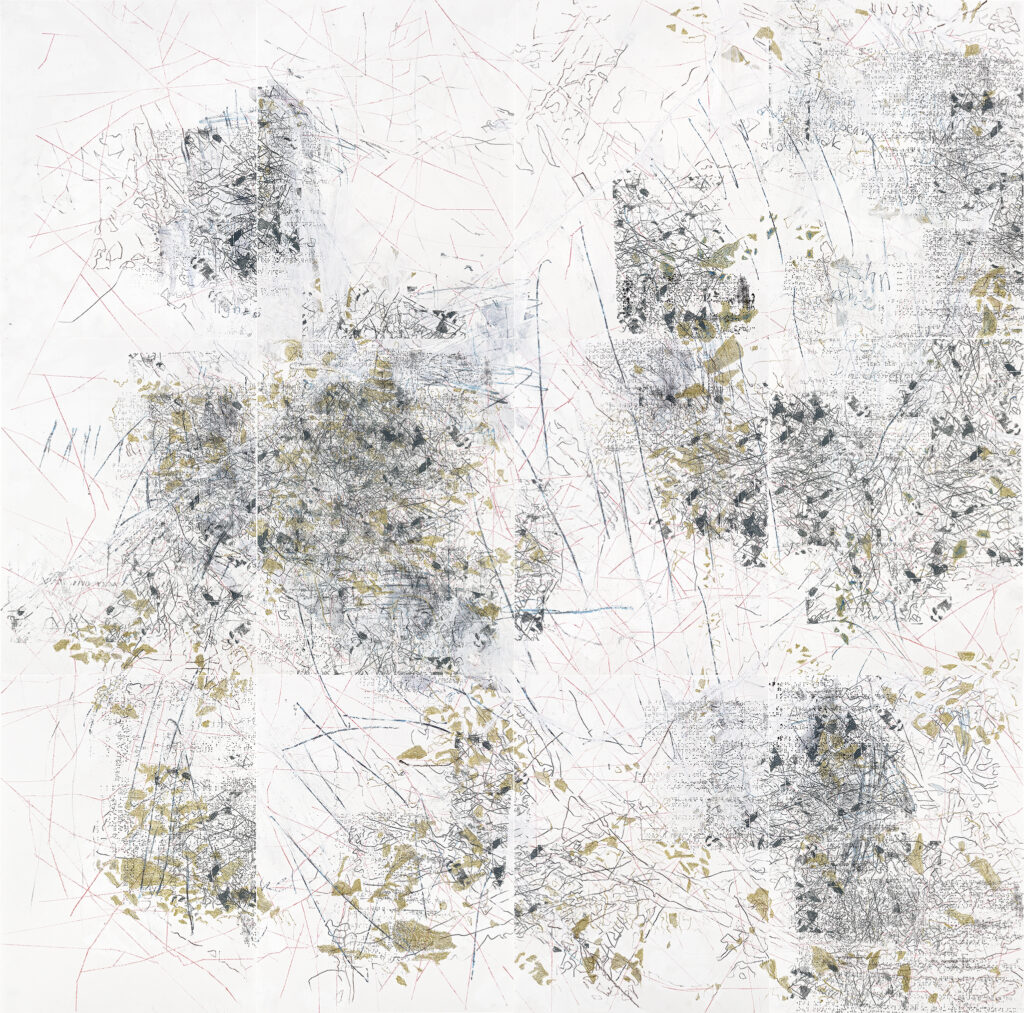
Türkel 05 2015 / 183 x 184 cm (12 parts, each 46 x 61 cm) / gouache, oil, coloured, wax crayon tracing on paper
Alignment 1, Alignment 2
The geometric endless patterns of Islamic art are variably interwoven, mathematical and ornamental groups. They are repetitive, rotating, mirrored geometric patterns that can be continued into infinity; depending on their scale, they sometimes appear detailed, sometimes monumental. In the works Alignment 1 + 2 they stand for a perfect, divine whole. This principle, however, is disturbed by overlapping and overprinting, by repeated overdrawing of the “faulty” fragments until a dense cluster of lines is created and restlessness is condensed. Underneath the drawing, like a continuous monologue, are passages from Susan Sunday’s book “On Illness as Methaphor”, in which she tries to demystify two deadly diseases, cancer and tuberculosis. This text also is a close examination of a disturbed whole. Paradoxically, by naming the fear thus, a hope to banish destruction appears.
Lara Faroqhi, November 2015
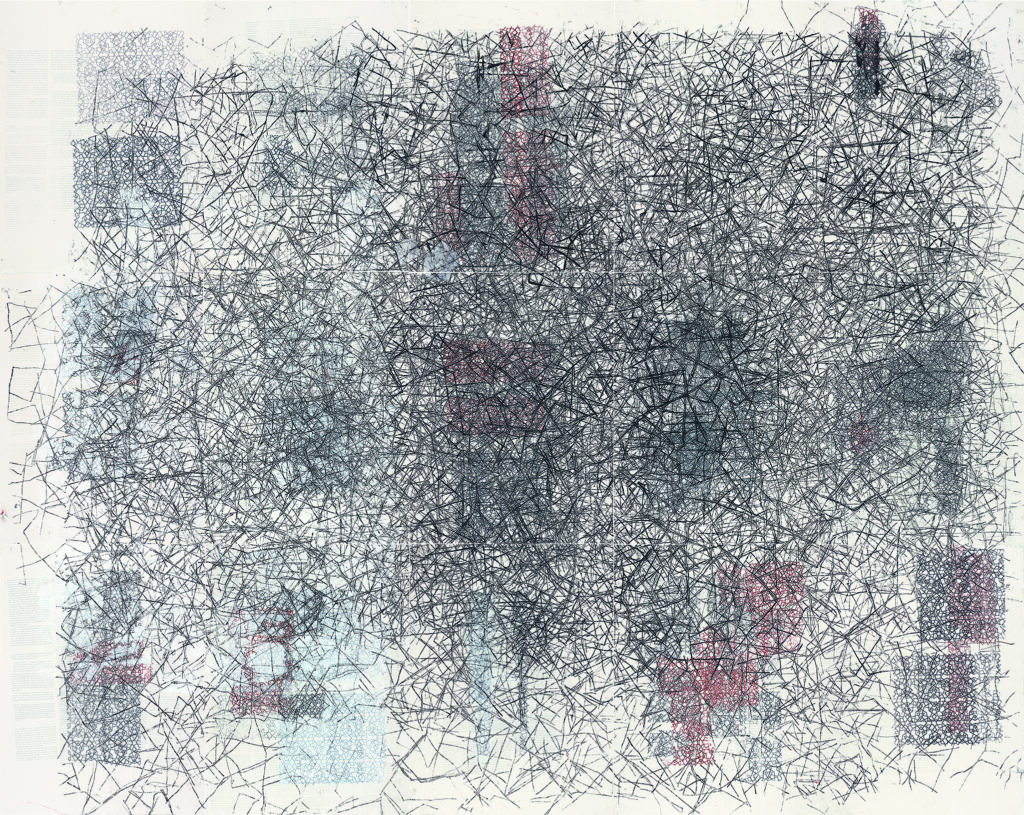
Alignment No.2 10 2014 / 183 x 230 cm (15 parts, each 46 x 61 cm) / gouache, oil, wax crayon tracing on paper
Alignment 1, Alignment 2
The geometric endless patterns of Islamic art are variably interwoven, mathematical and ornamental groups. They are repetitive, rotating, mirrored geometric patterns that can be continued into infinity; depending on their scale, they sometimes appear detailed, sometimes monumental. In the works Alignment 1 + 2 they stand for a perfect, divine whole. This principle, however, is disturbed by overlapping and overprinting, by repeated overdrawing of the “faulty” fragments until a dense cluster of lines is created and restlessness is condensed. Underneath the drawing, like a continuous monologue, are passages from Susan Sunday’s book “On Illness as Methaphor”, in which she tries to demystify two deadly diseases, cancer and tuberculosis. This text also is a close examination of a disturbed whole. Paradoxically, by naming the fear thus, a hope to banish destruction appears.
Lara Faroqhi, November 2015
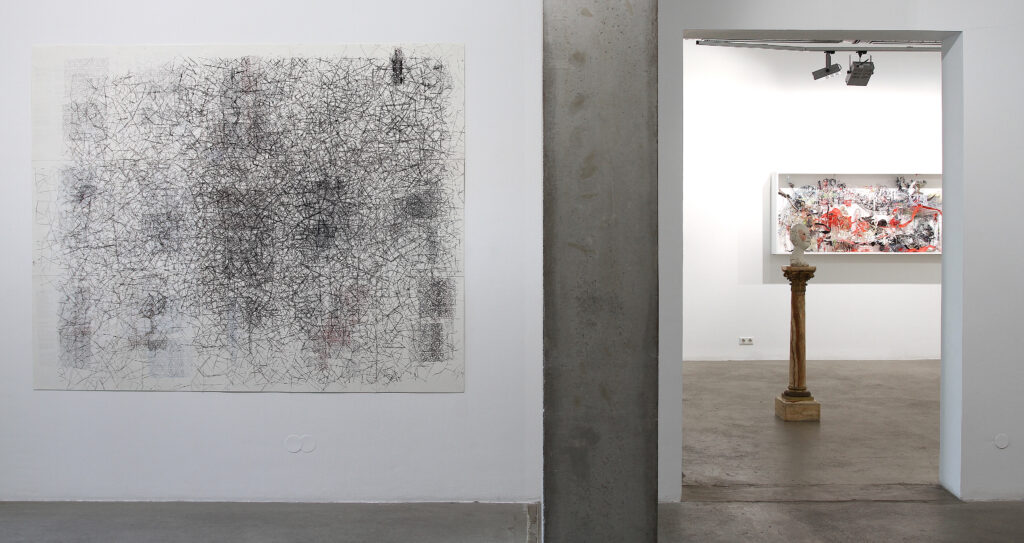
2019_Guardini_Alignment2_2050pxl Installation view at the exhibition Fragment at Guardini Galerie from 13. May to 9. August 2019
Alignment 1, Alignment 2
The geometric endless patterns of Islamic art are variably interwoven, mathematical and ornamental groups. They are repetitive, rotating, mirrored geometric patterns that can be continued into infinity; depending on their scale, they sometimes appear detailed, sometimes monumental. In the works Alignment 1 + 2 they stand for a perfect, divine whole. This principle, however, is disturbed by overlapping and overprinting, by repeated overdrawing of the “faulty” fragments until a dense cluster of lines is created and restlessness is condensed. Underneath the drawing, like a continuous monologue, are passages from Susan Sunday’s book “On Illness as Methaphor”, in which she tries to demystify two deadly diseases, cancer and tuberculosis. This text also is a close examination of a disturbed whole. Paradoxically, by naming the fear thus, a hope to banish destruction appears.
Lara Faroqhi, November 2015
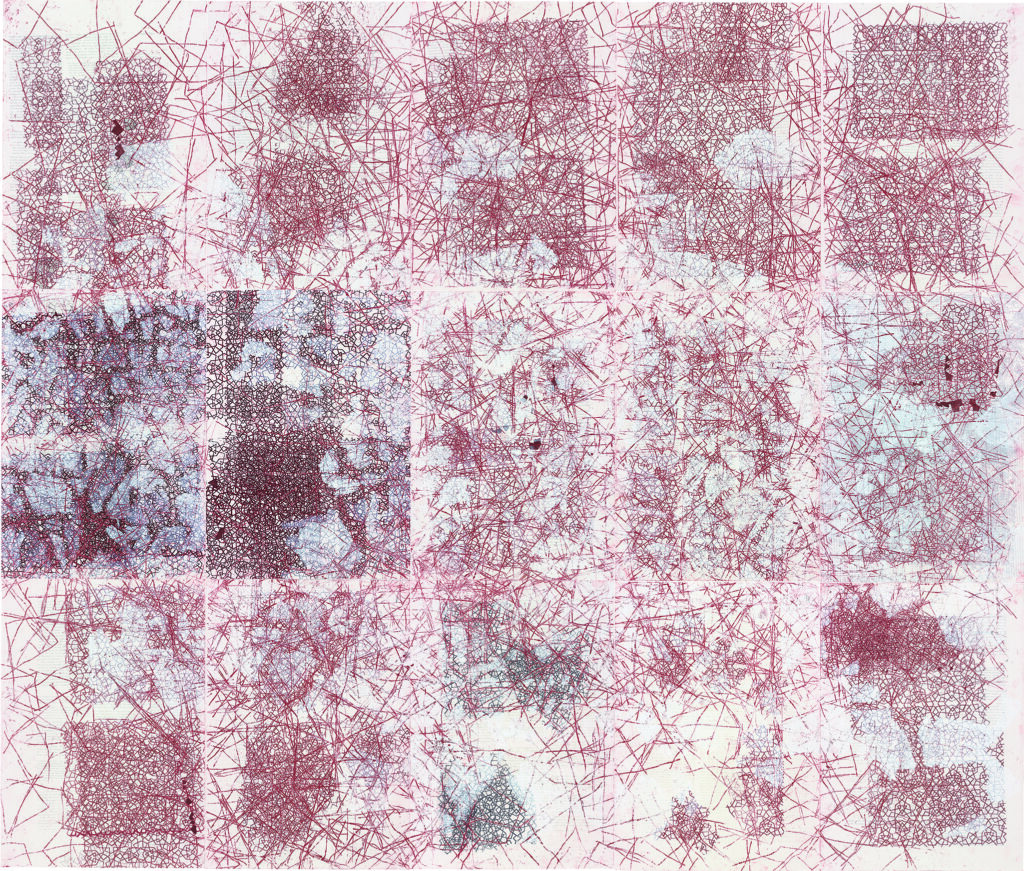
Alignment No.1 07 2014 / 168 x 180 cm (15 parts, each 36 x 56 cm ) / gouache, oil, wax crayon tracing on paper
Alignment 1, Alignment 2
The geometric endless patterns of Islamic art are variably interwoven, mathematical and ornamental groups. They are repetitive, rotating, mirrored geometric patterns that can be continued into infinity; depending on their scale, they sometimes appear detailed, sometimes monumental. In the works Alignment 1 + 2 they stand for a perfect, divine whole. This principle, however, is disturbed by overlapping and overprinting, by repeated overdrawing of the “faulty” fragments until a dense cluster of lines is created and restlessness is condensed. Underneath the drawing, like a continuous monologue, are passages from Susan Sunday’s book “On Illness as Methaphor”, in which she tries to demystify two deadly diseases, cancer and tuberculosis. This text also is a close examination of a disturbed whole. Paradoxically, by naming the fear thus, a hope to banish destruction appears.
Lara Faroqhi, November 2015

Moments of Being 07 2013 / 152 x 169,5 cm (6 parts, each 56,5 x 76 cm) / pencil, oil,charcoal, wax crayon tracing, water color on paper
Alignment 1, Alignment 2
The geometric endless patterns of Islamic art are variably interwoven, mathematical and ornamental groups. They are repetitive, rotating, mirrored geometric patterns that can be continued into infinity; depending on their scale, they sometimes appear detailed, sometimes monumental. In the works Alignment 1 + 2 they stand for a perfect, divine whole. This principle, however, is disturbed by overlapping and overprinting, by repeated overdrawing of the “faulty” fragments until a dense cluster of lines is created and restlessness is condensed. Underneath the drawing, like a continuous monologue, are passages from Susan Sunday’s book “On Illness as Methaphor”, in which she tries to demystify two deadly diseases, cancer and tuberculosis. This text also is a close examination of a disturbed whole. Paradoxically, by naming the fear thus, a hope to banish destruction appears.
Lara Faroqhi, November 2015
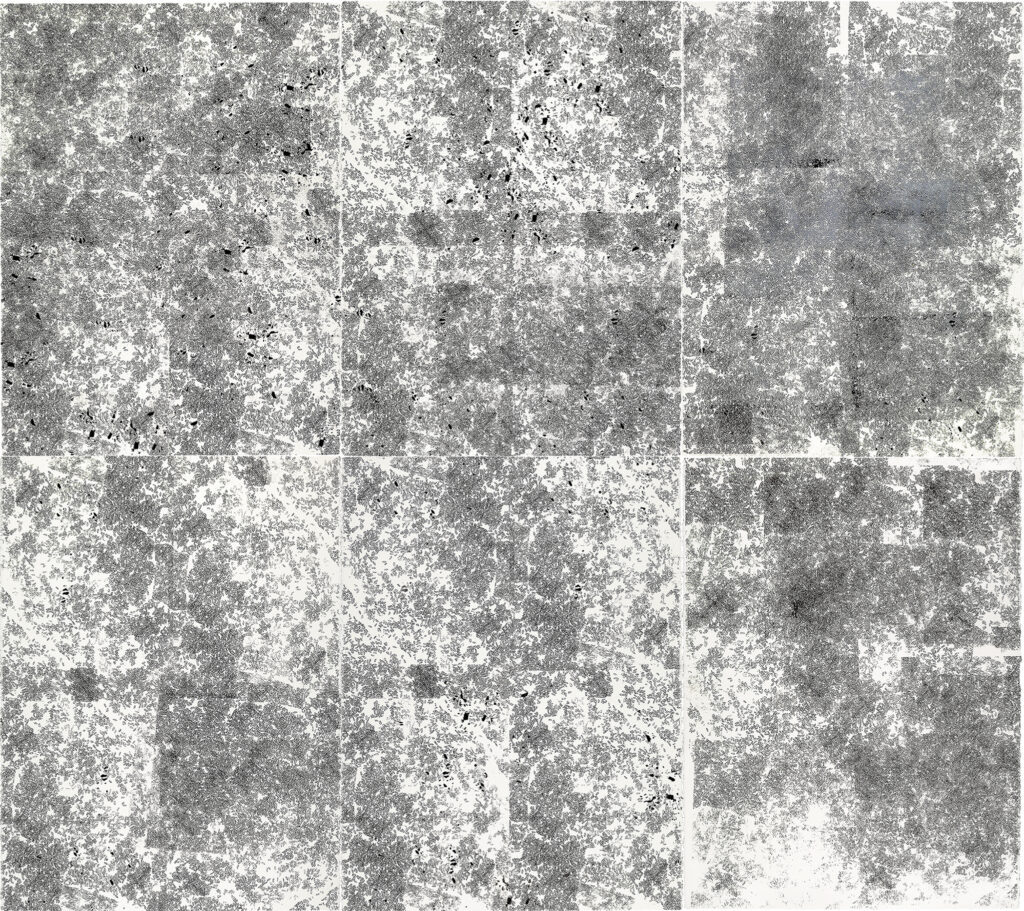
Rice 06 2013 / je 152 x 169,5 cm (6 parts, each 56,5 x 76 cm) / Two-colour-silkscreen on paper
Alignment 1, Alignment 2
The geometric endless patterns of Islamic art are variably interwoven, mathematical and ornamental groups. They are repetitive, rotating, mirrored geometric patterns that can be continued into infinity; depending on their scale, they sometimes appear detailed, sometimes monumental. In the works Alignment 1 + 2 they stand for a perfect, divine whole. This principle, however, is disturbed by overlapping and overprinting, by repeated overdrawing of the “faulty” fragments until a dense cluster of lines is created and restlessness is condensed. Underneath the drawing, like a continuous monologue, are passages from Susan Sunday’s book “On Illness as Methaphor”, in which she tries to demystify two deadly diseases, cancer and tuberculosis. This text also is a close examination of a disturbed whole. Paradoxically, by naming the fear thus, a hope to banish destruction appears.
Lara Faroqhi, November 2015
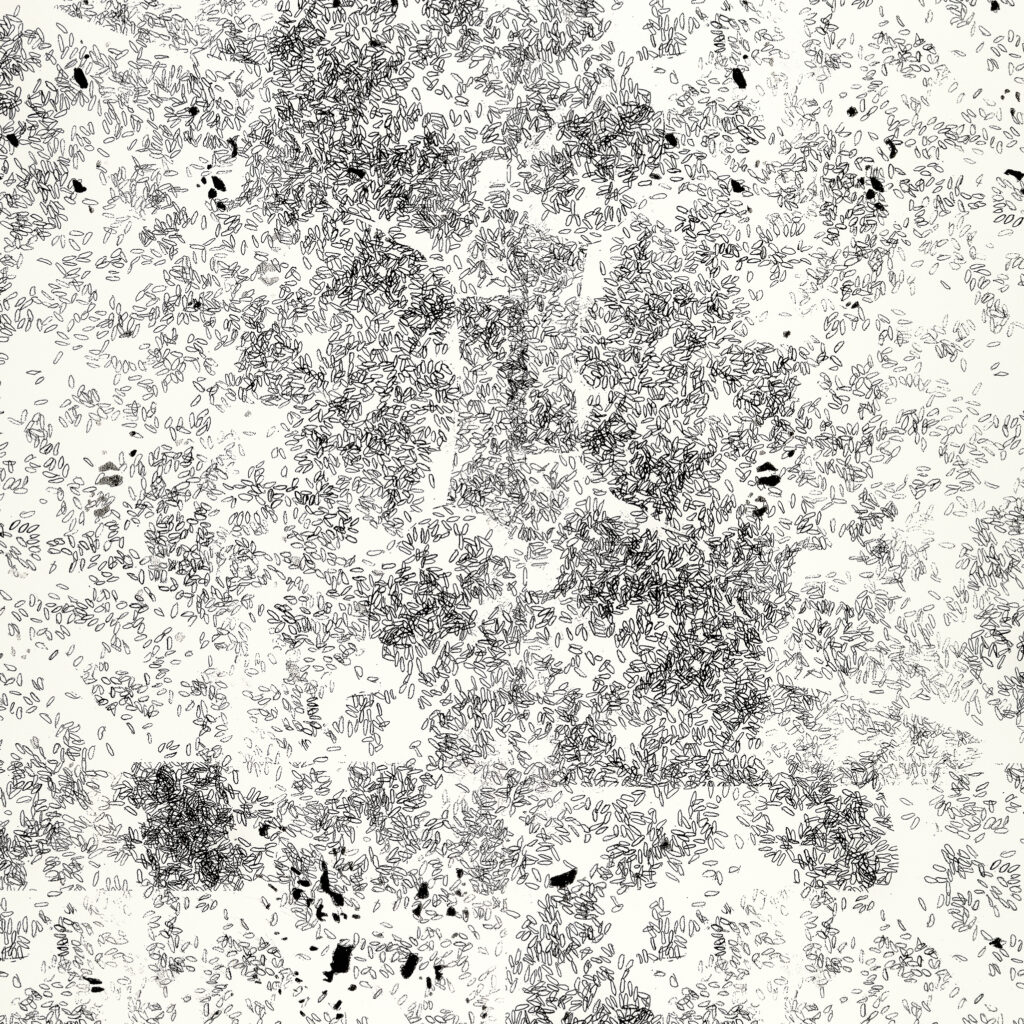
Rice Detail
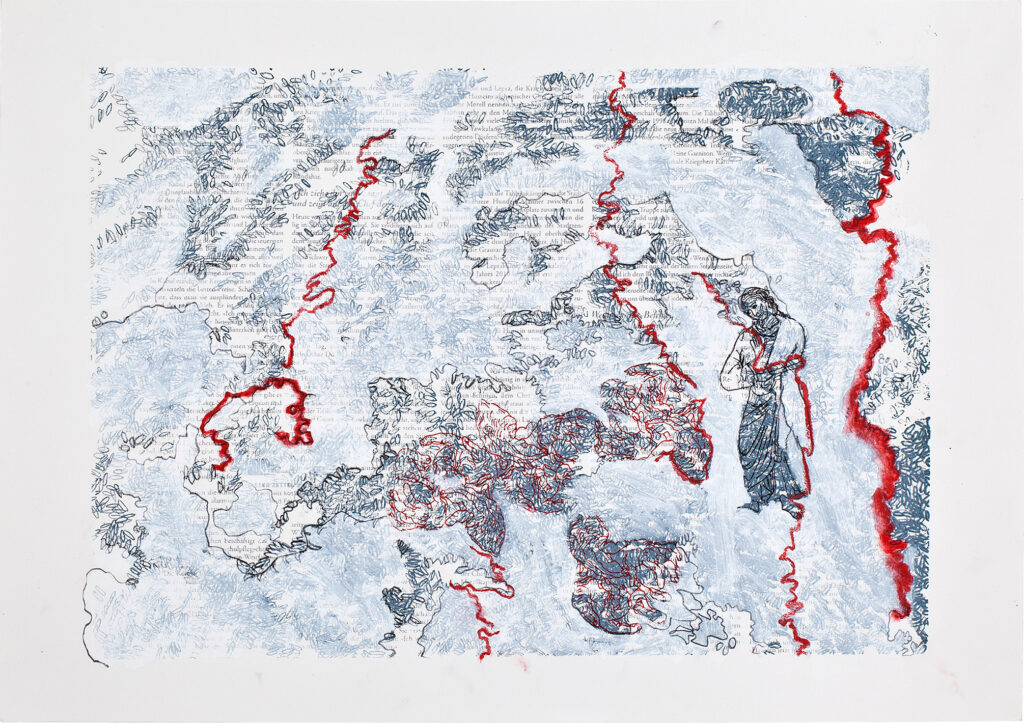
Wave No.4 06 2013 / 36 x 56 cm / gouache, oil, pencil, water colour pencil on paper

Wave No.5 06 2013 / 36 x 56 cm / gouache, oil, pencil, water colour pencil, wax crayon tracing, ink on paper

Wave No.3 06 2013 / 36 x 56 cm / gouache,oil, pencil, wax crayon tracinge, ink on paper
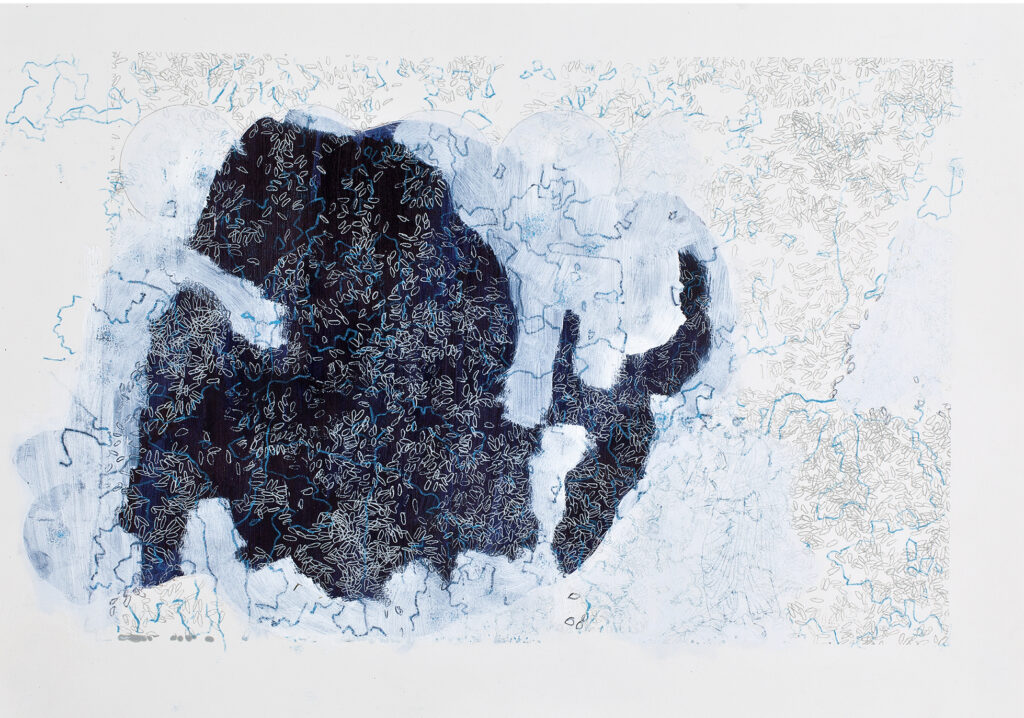
Wave No.6 06 2013 / 36 x 56 cm / gouache, oil, pencil, wax crayon tracing, ink on paper
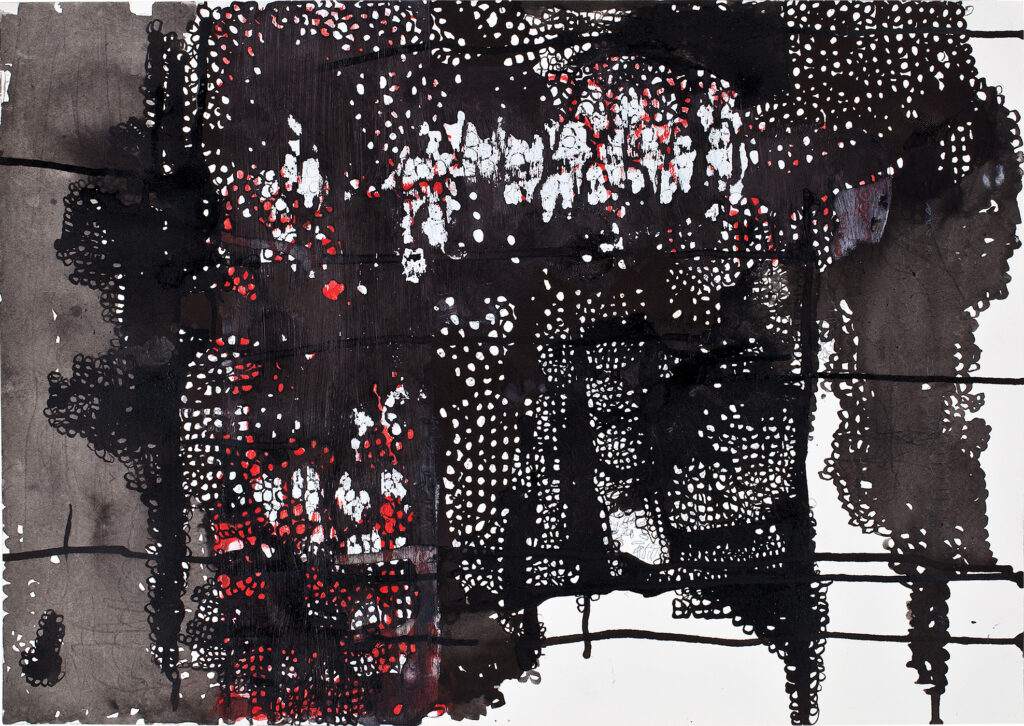
Wave No.14 07 2013 / 36 x 56 cm / gouache, oil, ink on paper
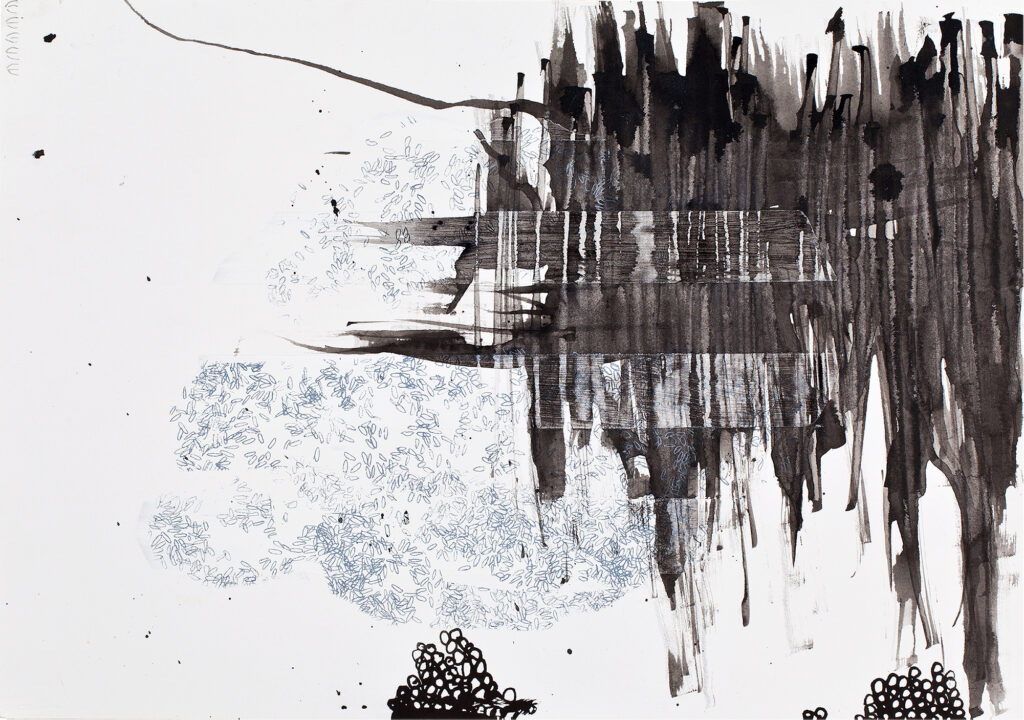
Wave No.7 07 2013 / 36 x 56 cm / gouache, oil, pencil, wax crayon tracing, ink on paper
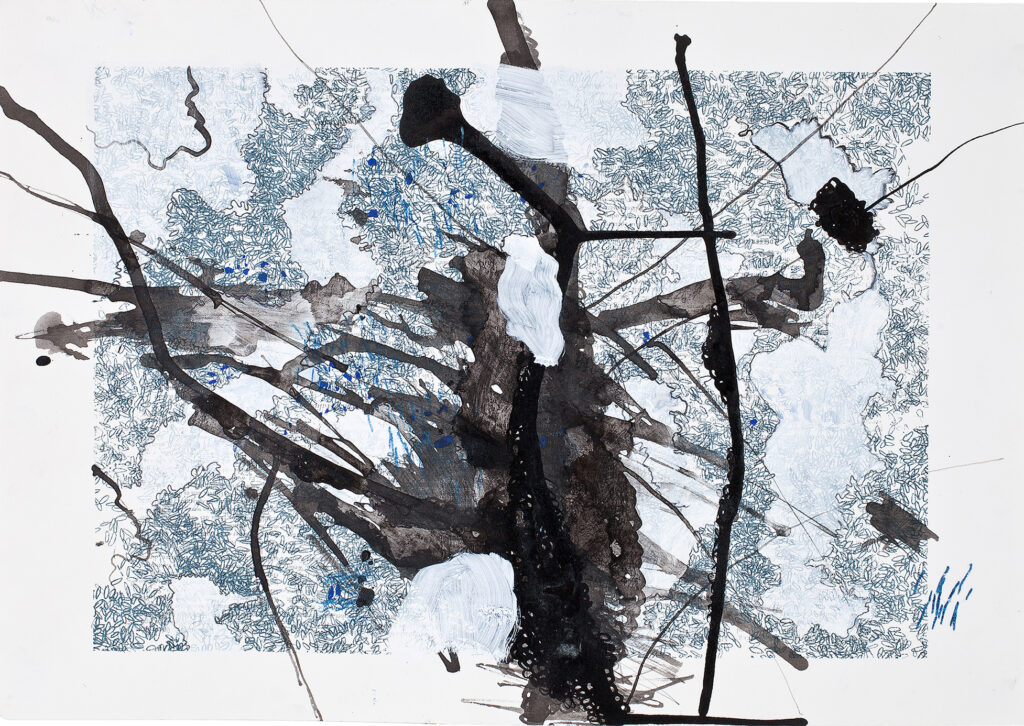
Wave No.8 07 2013 / 36 x 56 cm / gouache, oil, pencil, water colour pencil, wax crayon tracing, ink on paper

Wave No.9 07 2013 / 56 x 36 cm / gouache, oil, ink on paper

Wave No.10 06 2014 / 2 parts, each 56 x 36 cm / gouache, oil, water colour pencil on paper
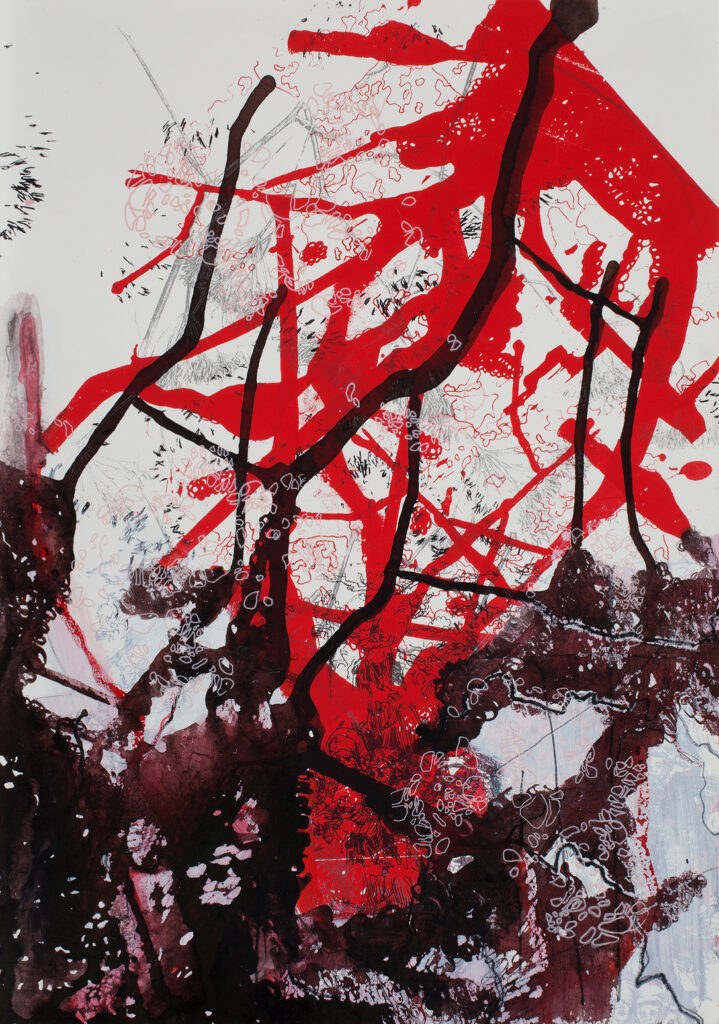
Wave No.13 06 2014 / 56 x 36 cm / gouache, oil, ink on paper

Wave No.15 06 2014 / 56 x 36 cm / gouache, water colour pencil on paper
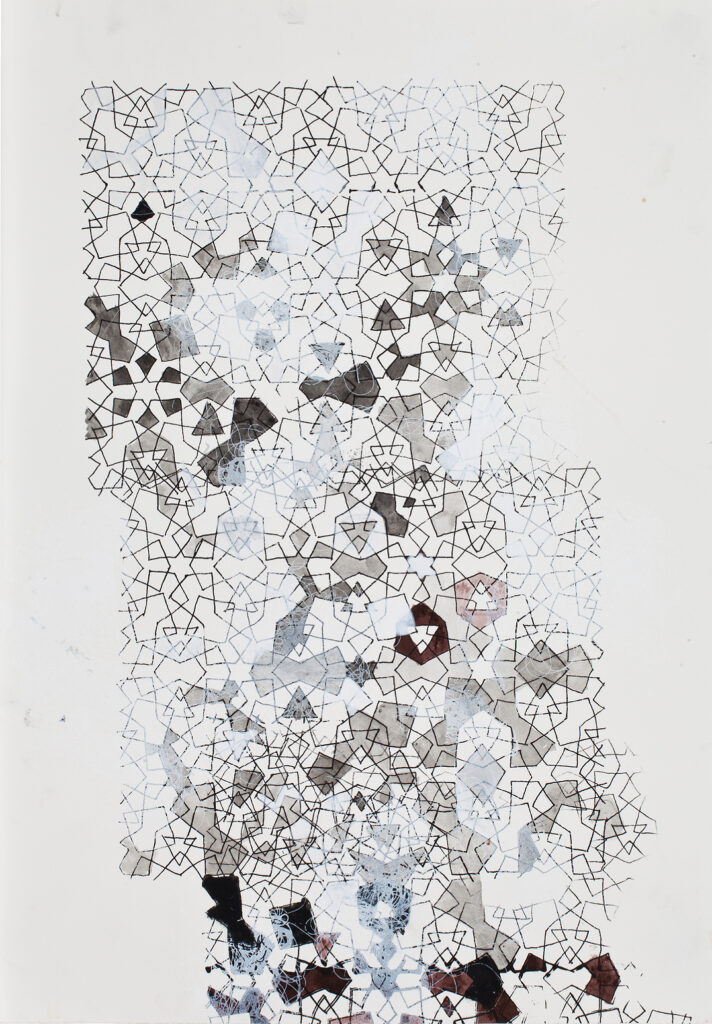
Wave No.17 06 2014 / 56 x 36 cm / gouache, oil, water colour on paper
aus der Eigenpublikation Lara Faroqhi, 2015
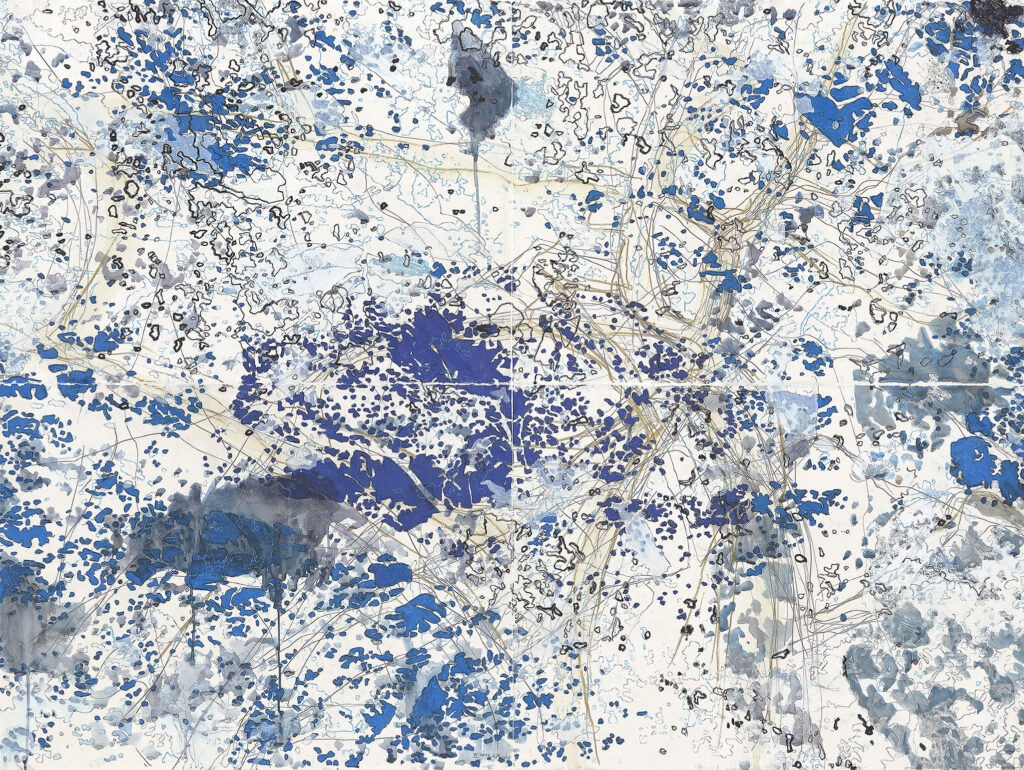
Immersion 07 2012 / 110 x 150 cm / pencil, pastel tracing, ink, oil, water colour pen, gouache on paper
aus der Eigenpublikation Lara Faroqhi, 2015

fervent 07 2012 / 110 x 150 cm (4 parts) / pencil, ink, oil, water colour pencil, gouache on paper
Drawing Against Forgetting
by Frizzi Krella
A subtle wall drawing, white on white, the vinyl foil barely a millimeter thick. The shadow cast by an ornament becomes space.
My first encounter with Lara Faroqhi’s work Trace: The scissor-cut contour line impresses itself deeply into the mind, pulling one into the multilayered and complex work of this artist. Conceptual ideas and inner thoughts are combined into images. Faroqhi draws her concentrated thought landscapes in pen and ink, watercolour pen and oil. Filigree and strong, light and dense. Observed from nature, these encounters are remembered, searched for, worked over, condensed, corrected and then written over yet again. Landscapes of drawing grow in parallel with the biography of the artist herself.
Do they reveal or conceal the unknown from us that accumulates hidden within?
Traces of discourse, conscious and unconscious, of intention and accident, traced in focus or blurred. The drawings have great honesty and openness, which is very moving.
With a delicate pencil line Faroqhi spins a fine net of silhouettes across several sheets of paper. Alternating contour lines of positive and negative space, different points of view from various perspectives are superimposed, followed by energetic staccato abbreviations, traced through pastel covered paper – overlapping of inner landscapes, seismographic drawings of what is intrinsic. Every drawing is generated through the analysis of seen, reflected, experienced information into a realisation. Lines and marks become gestures, forming, or being formed into a relationship with Truth itself (not a finite but a lasting one – at least for this moment and in this constellation.)
This momentary focus on disruption already started in 1993, when Faroqhi, (who has a background in both painting and sculpture) combined spatial thinking and procedural movements, began to build a drawing machine which was partially inspired by Jean Tinguely’s apparatus: a drawing pen on a rod attached to a wheel is set into motion by a motor, writing aleatory marks onto a piece of paper, while charcoal dust is ground through a sieve. Faroqhi was interested to make the work process itself visible, thereby showing the flexibility of drawings in the making and the fact that a drawing is neither anything fixed, nor anything obvious. She calls this the “non-finite”.
In the 1960’s and 70’s, when drawing became appreciated as an independent medium, it started to be used for exploring the areas between artistic disciplines which had previously been separated from each other.
When Faroqhi studied in the 1990’s, she was thus able to declare the drawing sheet as a stage for her artistic thinking and actions in a spontaneous manner.
2009 she began making the first contour drawings. First, she took branches into her studio to draw the contour lines of the shadows they cast. Today she works with the projection of digital images, with the conscious shattering of image information.
Each drawing inscribes the artistic process – one layer superimposing on the next like a palimpsest. Faroqhi constructs patterns of a micro cosmos covering the whole surface like a grid. In the drawings on Ash or Dispersion, for example, this is found in the light-flooded negative spaces of the apparently dense foliage of the treetops, showing those areas where the light of the sky comes through the gaps. Negative spaces become positive ones, blanks are made visible and alternate with the white surface of the paper itself. In chronological sequences, Faroqhi notes the consecutive stages from opening buds to the unfolding of lush foliage. The gaps, the “in-between-spaces”, become ever smaller until they almost disappear, while remaining present. It is as if Faroqhi wants to control time or to stop the moving image – in order to make things visible which otherwise would not reveal themselves. She draws against forgetting.
In painting, it is the light which produces form, light as the beginning of every coming into form. Opposite the light is the shadow, a reduction into silhouettes. The outline that divides shadow from light dividing form from non-form.
Drawings are created in the sense of securing evidence on paper, freed from the function of representation outside of their existing and recognizable object.
Faroqhi’s drawing game configures a system of its own kind, both conceptual in structure and existing as a free gestural drawing, thereby testing the possibilities and borders of drawing as a medium. System and sensibility become form.
August 2015
from the self-publication Lara Faroqhi in 2015
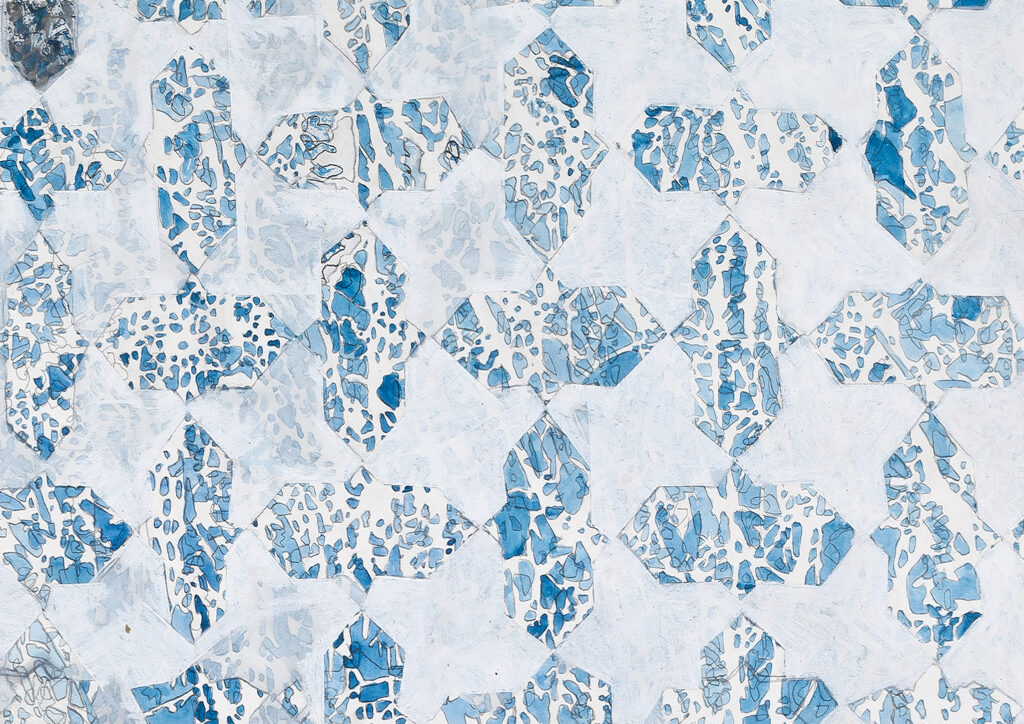
The Ins and Outs 06 2009 / 42 x 56 cm / pencil, water colour, oil on paper
Drawing Against Forgetting
by Frizzi Krella
A subtle wall drawing, white on white, the vinyl foil barely a millimeter thick. The shadow cast by an ornament becomes space.
My first encounter with Lara Faroqhi’s work Trace: The scissor-cut contour line impresses itself deeply into the mind, pulling one into the multilayered and complex work of this artist. Conceptual ideas and inner thoughts are combined into images. Faroqhi draws her concentrated thought landscapes in pen and ink, watercolour pen and oil. Filigree and strong, light and dense. Observed from nature, these encounters are remembered, searched for, worked over, condensed, corrected and then written over yet again. Landscapes of drawing grow in parallel with the biography of the artist herself.
Do they reveal or conceal the unknown from us that accumulates hidden within?
Traces of discourse, conscious and unconscious, of intention and accident, traced in focus or blurred. The drawings have great honesty and openness, which is very moving.
With a delicate pencil line Faroqhi spins a fine net of silhouettes across several sheets of paper. Alternating contour lines of positive and negative space, different points of view from various perspectives are superimposed, followed by energetic staccato abbreviations, traced through pastel covered paper – overlapping of inner landscapes, seismographic drawings of what is intrinsic. Every drawing is generated through the analysis of seen, reflected, experienced information into a realisation. Lines and marks become gestures, forming, or being formed into a relationship with Truth itself (not a finite but a lasting one – at least for this moment and in this constellation.)
This momentary focus on disruption already started in 1993, when Faroqhi, (who has a background in both painting and sculpture) combined spatial thinking and procedural movements, began to build a drawing machine which was partially inspired by Jean Tinguely’s apparatus: a drawing pen on a rod attached to a wheel is set into motion by a motor, writing aleatory marks onto a piece of paper, while charcoal dust is ground through a sieve. Faroqhi was interested to make the work process itself visible, thereby showing the flexibility of drawings in the making and the fact that a drawing is neither anything fixed, nor anything obvious. She calls this the “non-finite”.
In the 1960’s and 70’s, when drawing became appreciated as an independent medium, it started to be used for exploring the areas between artistic disciplines which had previously been separated from each other.
When Faroqhi studied in the 1990’s, she was thus able to declare the drawing sheet as a stage for her artistic thinking and actions in a spontaneous manner.
2009 she began making the first contour drawings. First, she took branches into her studio to draw the contour lines of the shadows they cast. Today she works with the projection of digital images, with the conscious shattering of image information.
Each drawing inscribes the artistic process – one layer superimposing on the next like a palimpsest. Faroqhi constructs patterns of a micro cosmos covering the whole surface like a grid. In the drawings on Ash or Dispersion, for example, this is found in the light-flooded negative spaces of the apparently dense foliage of the treetops, showing those areas where the light of the sky comes through the gaps. Negative spaces become positive ones, blanks are made visible and alternate with the white surface of the paper itself. In chronological sequences, Faroqhi notes the consecutive stages from opening buds to the unfolding of lush foliage. The gaps, the “in-between-spaces”, become ever smaller until they almost disappear, while remaining present. It is as if Faroqhi wants to control time or to stop the moving image – in order to make things visible which otherwise would not reveal themselves. She draws against forgetting.
In painting, it is the light which produces form, light as the beginning of every coming into form. Opposite the light is the shadow, a reduction into silhouettes. The outline that divides shadow from light dividing form from non-form.
Drawings are created in the sense of securing evidence on paper, freed from the function of representation outside of their existing and recognizable object.
Faroqhi’s drawing game configures a system of its own kind, both conceptual in structure and existing as a free gestural drawing, thereby testing the possibilities and borders of drawing as a medium. System and sensibility become form.
August 2015
from the self-publication Lara Faroqhi in 2015
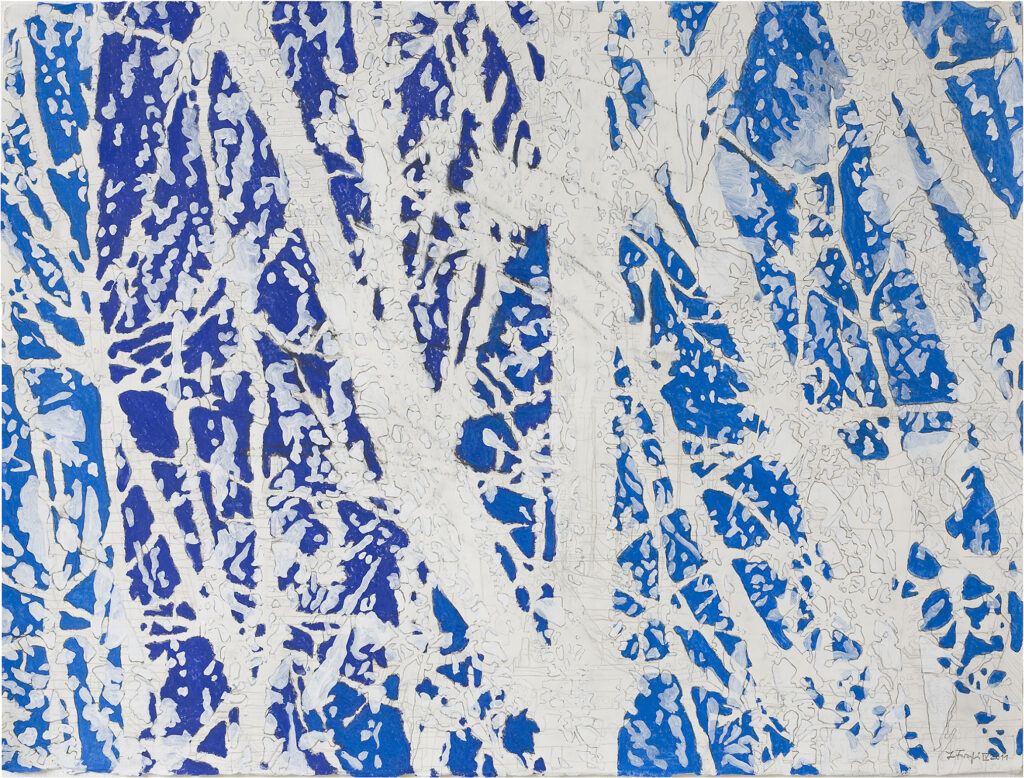
Blue Ash 04 2011 / pencil, water colour pencil, oil on paper
Drawing Against Forgetting
by Frizzi Krella
A subtle wall drawing, white on white, the vinyl foil barely a millimeter thick. The shadow cast by an ornament becomes space.
My first encounter with Lara Faroqhi’s work Trace: The scissor-cut contour line impresses itself deeply into the mind, pulling one into the multilayered and complex work of this artist. Conceptual ideas and inner thoughts are combined into images. Faroqhi draws her concentrated thought landscapes in pen and ink, watercolour pen and oil. Filigree and strong, light and dense. Observed from nature, these encounters are remembered, searched for, worked over, condensed, corrected and then written over yet again. Landscapes of drawing grow in parallel with the biography of the artist herself.
Do they reveal or conceal the unknown from us that accumulates hidden within?
Traces of discourse, conscious and unconscious, of intention and accident, traced in focus or blurred. The drawings have great honesty and openness, which is very moving.
With a delicate pencil line Faroqhi spins a fine net of silhouettes across several sheets of paper. Alternating contour lines of positive and negative space, different points of view from various perspectives are superimposed, followed by energetic staccato abbreviations, traced through pastel covered paper – overlapping of inner landscapes, seismographic drawings of what is intrinsic. Every drawing is generated through the analysis of seen, reflected, experienced information into a realisation. Lines and marks become gestures, forming, or being formed into a relationship with Truth itself (not a finite but a lasting one – at least for this moment and in this constellation.)
This momentary focus on disruption already started in 1993, when Faroqhi, (who has a background in both painting and sculpture) combined spatial thinking and procedural movements, began to build a drawing machine which was partially inspired by Jean Tinguely’s apparatus: a drawing pen on a rod attached to a wheel is set into motion by a motor, writing aleatory marks onto a piece of paper, while charcoal dust is ground through a sieve. Faroqhi was interested to make the work process itself visible, thereby showing the flexibility of drawings in the making and the fact that a drawing is neither anything fixed, nor anything obvious. She calls this the “non-finite”.
In the 1960’s and 70’s, when drawing became appreciated as an independent medium, it started to be used for exploring the areas between artistic disciplines which had previously been separated from each other.
When Faroqhi studied in the 1990’s, she was thus able to declare the drawing sheet as a stage for her artistic thinking and actions in a spontaneous manner.
2009 she began making the first contour drawings. First, she took branches into her studio to draw the contour lines of the shadows they cast. Today she works with the projection of digital images, with the conscious shattering of image information.
Each drawing inscribes the artistic process – one layer superimposing on the next like a palimpsest. Faroqhi constructs patterns of a micro cosmos covering the whole surface like a grid. In the drawings on Ash or Dispersion, for example, this is found in the light-flooded negative spaces of the apparently dense foliage of the treetops, showing those areas where the light of the sky comes through the gaps. Negative spaces become positive ones, blanks are made visible and alternate with the white surface of the paper itself. In chronological sequences, Faroqhi notes the consecutive stages from opening buds to the unfolding of lush foliage. The gaps, the “in-between-spaces”, become ever smaller until they almost disappear, while remaining present. It is as if Faroqhi wants to control time or to stop the moving image – in order to make things visible which otherwise would not reveal themselves. She draws against forgetting.
In painting, it is the light which produces form, light as the beginning of every coming into form. Opposite the light is the shadow, a reduction into silhouettes. The outline that divides shadow from light dividing form from non-form.
Drawings are created in the sense of securing evidence on paper, freed from the function of representation outside of their existing and recognizable object.
Faroqhi’s drawing game configures a system of its own kind, both conceptual in structure and existing as a free gestural drawing, thereby testing the possibilities and borders of drawing as a medium. System and sensibility become form.
August 2015
from the self-publication Lara Faroqhi in 2015

Ash 03 2011 / 56 x 76 cm pencil, water color pencil, oil on paper
Drawing Against Forgetting
by Frizzi Krella
A subtle wall drawing, white on white, the vinyl foil barely a millimeter thick. The shadow cast by an ornament becomes space.
My first encounter with Lara Faroqhi’s work Trace: The scissor-cut contour line impresses itself deeply into the mind, pulling one into the multilayered and complex work of this artist. Conceptual ideas and inner thoughts are combined into images. Faroqhi draws her concentrated thought landscapes in pen and ink, watercolour pen and oil. Filigree and strong, light and dense. Observed from nature, these encounters are remembered, searched for, worked over, condensed, corrected and then written over yet again. Landscapes of drawing grow in parallel with the biography of the artist herself.
Do they reveal or conceal the unknown from us that accumulates hidden within?
Traces of discourse, conscious and unconscious, of intention and accident, traced in focus or blurred. The drawings have great honesty and openness, which is very moving.
With a delicate pencil line Faroqhi spins a fine net of silhouettes across several sheets of paper. Alternating contour lines of positive and negative space, different points of view from various perspectives are superimposed, followed by energetic staccato abbreviations, traced through pastel covered paper – overlapping of inner landscapes, seismographic drawings of what is intrinsic. Every drawing is generated through the analysis of seen, reflected, experienced information into a realisation. Lines and marks become gestures, forming, or being formed into a relationship with Truth itself (not a finite but a lasting one – at least for this moment and in this constellation.)
This momentary focus on disruption already started in 1993, when Faroqhi, (who has a background in both painting and sculpture) combined spatial thinking and procedural movements, began to build a drawing machine which was partially inspired by Jean Tinguely’s apparatus: a drawing pen on a rod attached to a wheel is set into motion by a motor, writing aleatory marks onto a piece of paper, while charcoal dust is ground through a sieve. Faroqhi was interested to make the work process itself visible, thereby showing the flexibility of drawings in the making and the fact that a drawing is neither anything fixed, nor anything obvious. She calls this the “non-finite”.
In the 1960’s and 70’s, when drawing became appreciated as an independent medium, it started to be used for exploring the areas between artistic disciplines which had previously been separated from each other.
When Faroqhi studied in the 1990’s, she was thus able to declare the drawing sheet as a stage for her artistic thinking and actions in a spontaneous manner.
2009 she began making the first contour drawings. First, she took branches into her studio to draw the contour lines of the shadows they cast. Today she works with the projection of digital images, with the conscious shattering of image information.
Each drawing inscribes the artistic process – one layer superimposing on the next like a palimpsest. Faroqhi constructs patterns of a micro cosmos covering the whole surface like a grid. In the drawings on Ash or Dispersion, for example, this is found in the light-flooded negative spaces of the apparently dense foliage of the treetops, showing those areas where the light of the sky comes through the gaps. Negative spaces become positive ones, blanks are made visible and alternate with the white surface of the paper itself. In chronological sequences, Faroqhi notes the consecutive stages from opening buds to the unfolding of lush foliage. The gaps, the “in-between-spaces”, become ever smaller until they almost disappear, while remaining present. It is as if Faroqhi wants to control time or to stop the moving image – in order to make things visible which otherwise would not reveal themselves. She draws against forgetting.
In painting, it is the light which produces form, light as the beginning of every coming into form. Opposite the light is the shadow, a reduction into silhouettes. The outline that divides shadow from light dividing form from non-form.
Drawings are created in the sense of securing evidence on paper, freed from the function of representation outside of their existing and recognizable object.
Faroqhi’s drawing game configures a system of its own kind, both conceptual in structure and existing as a free gestural drawing, thereby testing the possibilities and borders of drawing as a medium. System and sensibility become form.
August 2015
from the self-publication Lara Faroqhi in 2015

Kudamm meets Ikea 10 2010 / 56 x 76 cm / pencil, water color pencil, oil on paper
Drawing Against Forgetting
by Frizzi Krella
A subtle wall drawing, white on white, the vinyl foil barely a millimeter thick. The shadow cast by an ornament becomes space.
My first encounter with Lara Faroqhi’s work Trace: The scissor-cut contour line impresses itself deeply into the mind, pulling one into the multilayered and complex work of this artist. Conceptual ideas and inner thoughts are combined into images. Faroqhi draws her concentrated thought landscapes in pen and ink, watercolour pen and oil. Filigree and strong, light and dense. Observed from nature, these encounters are remembered, searched for, worked over, condensed, corrected and then written over yet again. Landscapes of drawing grow in parallel with the biography of the artist herself.
Do they reveal or conceal the unknown from us that accumulates hidden within?
Traces of discourse, conscious and unconscious, of intention and accident, traced in focus or blurred. The drawings have great honesty and openness, which is very moving.
With a delicate pencil line Faroqhi spins a fine net of silhouettes across several sheets of paper. Alternating contour lines of positive and negative space, different points of view from various perspectives are superimposed, followed by energetic staccato abbreviations, traced through pastel covered paper – overlapping of inner landscapes, seismographic drawings of what is intrinsic. Every drawing is generated through the analysis of seen, reflected, experienced information into a realisation. Lines and marks become gestures, forming, or being formed into a relationship with Truth itself (not a finite but a lasting one – at least for this moment and in this constellation.)
This momentary focus on disruption already started in 1993, when Faroqhi, (who has a background in both painting and sculpture) combined spatial thinking and procedural movements, began to build a drawing machine which was partially inspired by Jean Tinguely’s apparatus: a drawing pen on a rod attached to a wheel is set into motion by a motor, writing aleatory marks onto a piece of paper, while charcoal dust is ground through a sieve. Faroqhi was interested to make the work process itself visible, thereby showing the flexibility of drawings in the making and the fact that a drawing is neither anything fixed, nor anything obvious. She calls this the “non-finite”.
In the 1960’s and 70’s, when drawing became appreciated as an independent medium, it started to be used for exploring the areas between artistic disciplines which had previously been separated from each other.
When Faroqhi studied in the 1990’s, she was thus able to declare the drawing sheet as a stage for her artistic thinking and actions in a spontaneous manner.
2009 she began making the first contour drawings. First, she took branches into her studio to draw the contour lines of the shadows they cast. Today she works with the projection of digital images, with the conscious shattering of image information.
Each drawing inscribes the artistic process – one layer superimposing on the next like a palimpsest. Faroqhi constructs patterns of a micro cosmos covering the whole surface like a grid. In the drawings on Ash or Dispersion, for example, this is found in the light-flooded negative spaces of the apparently dense foliage of the treetops, showing those areas where the light of the sky comes through the gaps. Negative spaces become positive ones, blanks are made visible and alternate with the white surface of the paper itself. In chronological sequences, Faroqhi notes the consecutive stages from opening buds to the unfolding of lush foliage. The gaps, the “in-between-spaces”, become ever smaller until they almost disappear, while remaining present. It is as if Faroqhi wants to control time or to stop the moving image – in order to make things visible which otherwise would not reveal themselves. She draws against forgetting.
In painting, it is the light which produces form, light as the beginning of every coming into form. Opposite the light is the shadow, a reduction into silhouettes. The outline that divides shadow from light dividing form from non-form.
Drawings are created in the sense of securing evidence on paper, freed from the function of representation outside of their existing and recognizable object.
Faroqhi’s drawing game configures a system of its own kind, both conceptual in structure and existing as a free gestural drawing, thereby testing the possibilities and borders of drawing as a medium. System and sensibility become form.
August 2015
from the self-publication Lara Faroqhi in 2015
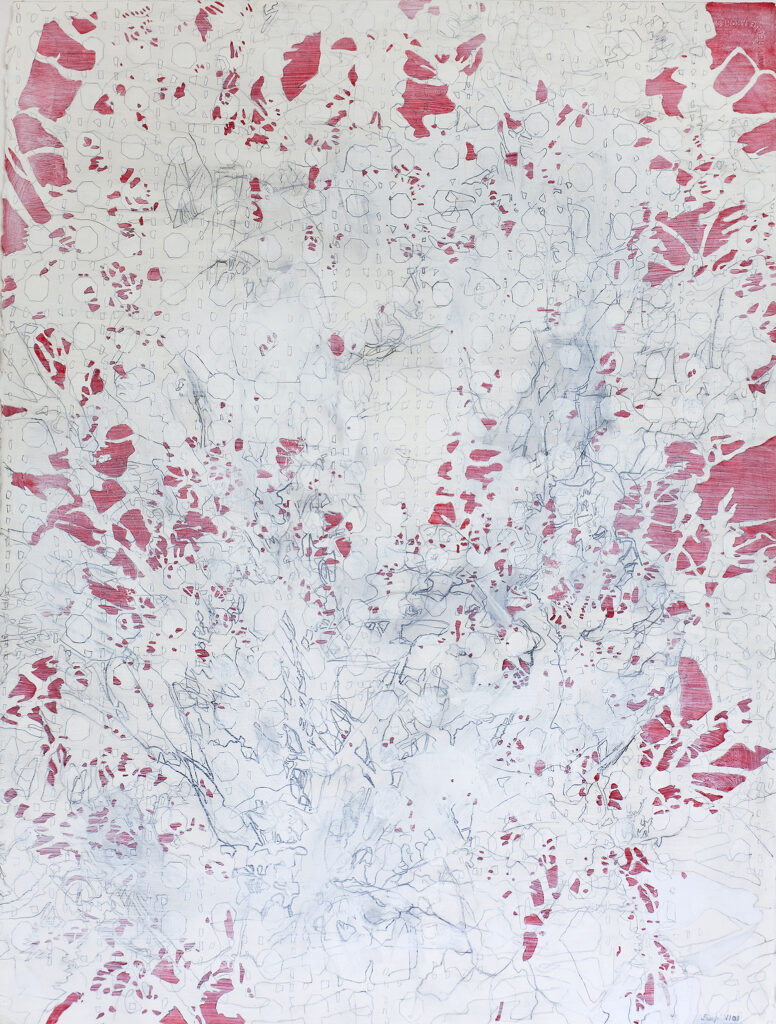
Red Drawing 09 2009 / 76 x 56 cm / pencil, acrylics, oil on paper
Drawing Against Forgetting
by Frizzi Krella
A subtle wall drawing, white on white, the vinyl foil barely a millimeter thick. The shadow cast by an ornament becomes space.
My first encounter with Lara Faroqhi’s work Trace: The scissor-cut contour line impresses itself deeply into the mind, pulling one into the multilayered and complex work of this artist. Conceptual ideas and inner thoughts are combined into images. Faroqhi draws her concentrated thought landscapes in pen and ink, watercolour pen and oil. Filigree and strong, light and dense. Observed from nature, these encounters are remembered, searched for, worked over, condensed, corrected and then written over yet again. Landscapes of drawing grow in parallel with the biography of the artist herself.
Do they reveal or conceal the unknown from us that accumulates hidden within?
Traces of discourse, conscious and unconscious, of intention and accident, traced in focus or blurred. The drawings have great honesty and openness, which is very moving.
With a delicate pencil line Faroqhi spins a fine net of silhouettes across several sheets of paper. Alternating contour lines of positive and negative space, different points of view from various perspectives are superimposed, followed by energetic staccato abbreviations, traced through pastel covered paper – overlapping of inner landscapes, seismographic drawings of what is intrinsic. Every drawing is generated through the analysis of seen, reflected, experienced information into a realisation. Lines and marks become gestures, forming, or being formed into a relationship with Truth itself (not a finite but a lasting one – at least for this moment and in this constellation.)
This momentary focus on disruption already started in 1993, when Faroqhi, (who has a background in both painting and sculpture) combined spatial thinking and procedural movements, began to build a drawing machine which was partially inspired by Jean Tinguely’s apparatus: a drawing pen on a rod attached to a wheel is set into motion by a motor, writing aleatory marks onto a piece of paper, while charcoal dust is ground through a sieve. Faroqhi was interested to make the work process itself visible, thereby showing the flexibility of drawings in the making and the fact that a drawing is neither anything fixed, nor anything obvious. She calls this the “non-finite”.
In the 1960’s and 70’s, when drawing became appreciated as an independent medium, it started to be used for exploring the areas between artistic disciplines which had previously been separated from each other.
When Faroqhi studied in the 1990’s, she was thus able to declare the drawing sheet as a stage for her artistic thinking and actions in a spontaneous manner.
2009 she began making the first contour drawings. First, she took branches into her studio to draw the contour lines of the shadows they cast. Today she works with the projection of digital images, with the conscious shattering of image information.
Each drawing inscribes the artistic process – one layer superimposing on the next like a palimpsest. Faroqhi constructs patterns of a micro cosmos covering the whole surface like a grid. In the drawings on Ash or Dispersion, for example, this is found in the light-flooded negative spaces of the apparently dense foliage of the treetops, showing those areas where the light of the sky comes through the gaps. Negative spaces become positive ones, blanks are made visible and alternate with the white surface of the paper itself. In chronological sequences, Faroqhi notes the consecutive stages from opening buds to the unfolding of lush foliage. The gaps, the “in-between-spaces”, become ever smaller until they almost disappear, while remaining present. It is as if Faroqhi wants to control time or to stop the moving image – in order to make things visible which otherwise would not reveal themselves. She draws against forgetting.
In painting, it is the light which produces form, light as the beginning of every coming into form. Opposite the light is the shadow, a reduction into silhouettes. The outline that divides shadow from light dividing form from non-form.
Drawings are created in the sense of securing evidence on paper, freed from the function of representation outside of their existing and recognizable object.
Faroqhi’s drawing game configures a system of its own kind, both conceptual in structure and existing as a free gestural drawing, thereby testing the possibilities and borders of drawing as a medium. System and sensibility become form.
August 2015
from the self-publication Lara Faroqhi in 2015
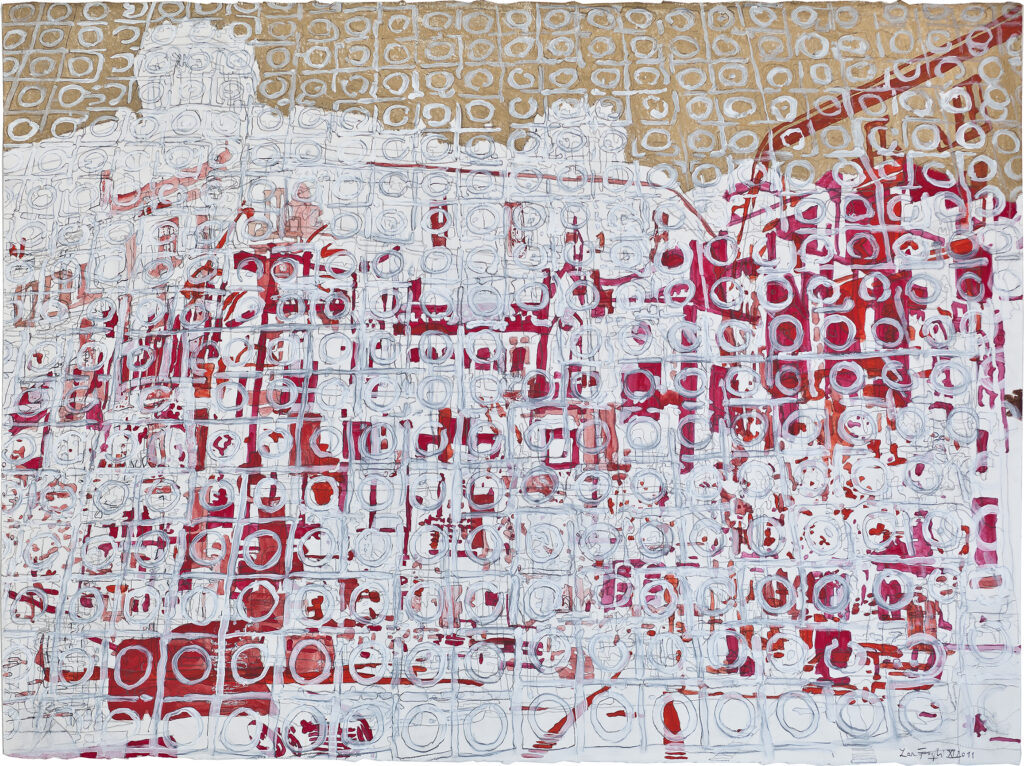
Calle de Consejo / Carrer de Girona, Barcelona 11 2011 / 56 x 76 cm / pencil, water colour pen, oil on paper

District Authority Neukölln 04 2006 / 50 x 70 cm / pencil, oil on paper
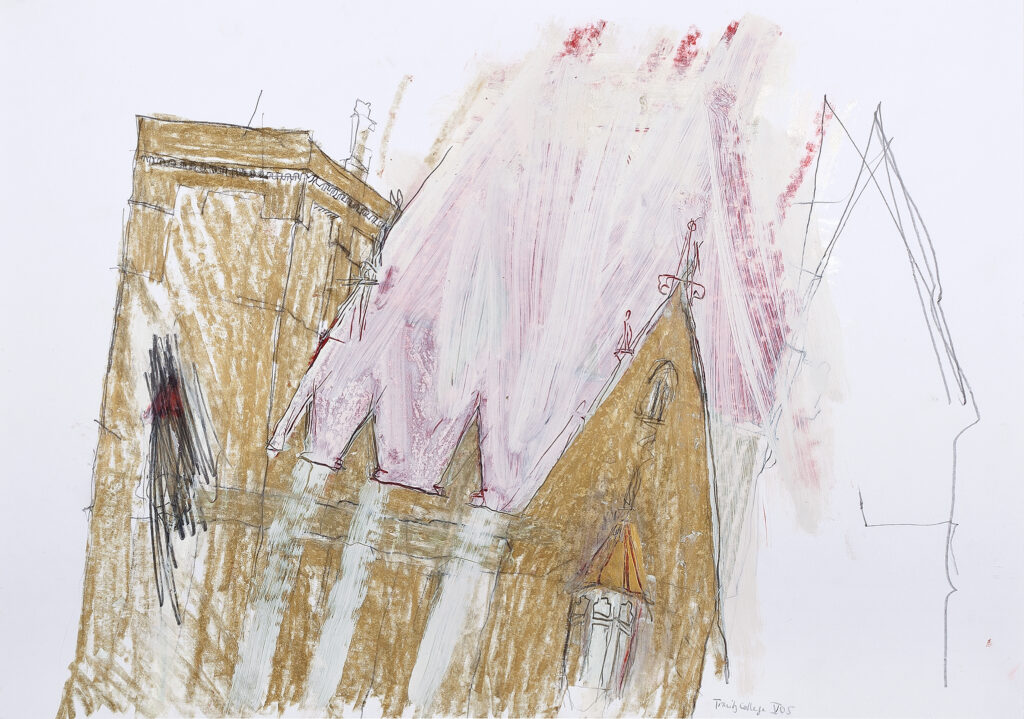
Trinity College Oxford 05 2005 / 50 x 70 cm / pencil, wax crayon, oil on paper
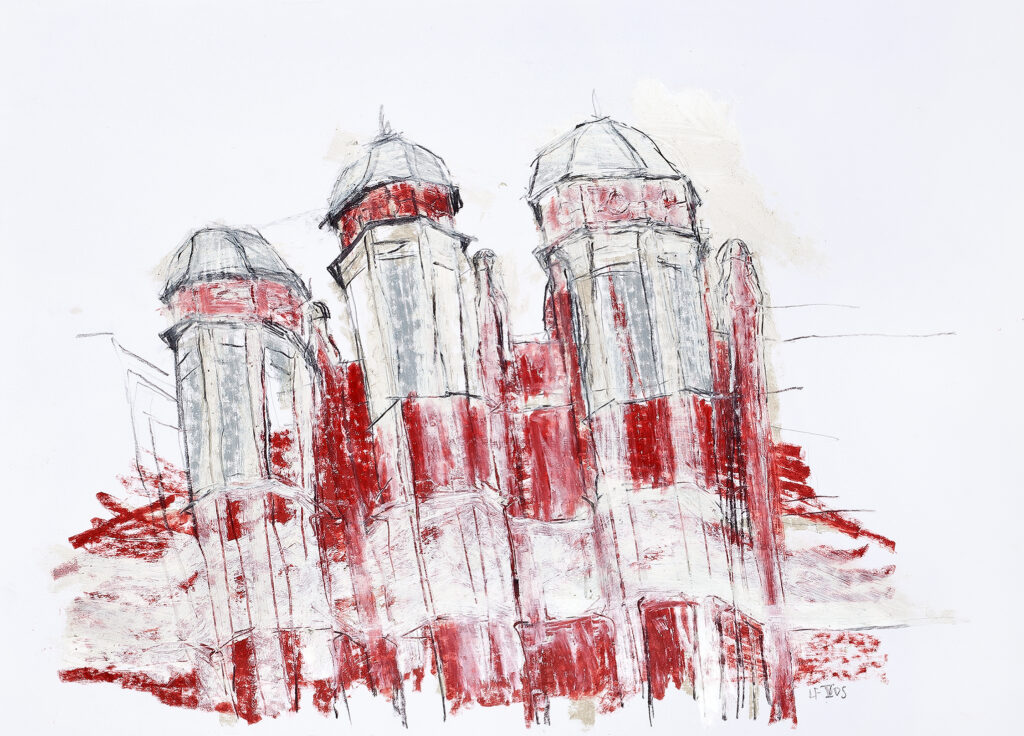
Job Centre Oxford 05 2005 / 50 x 70 cm / pencil, wax crayon, oil, oil stick on paper
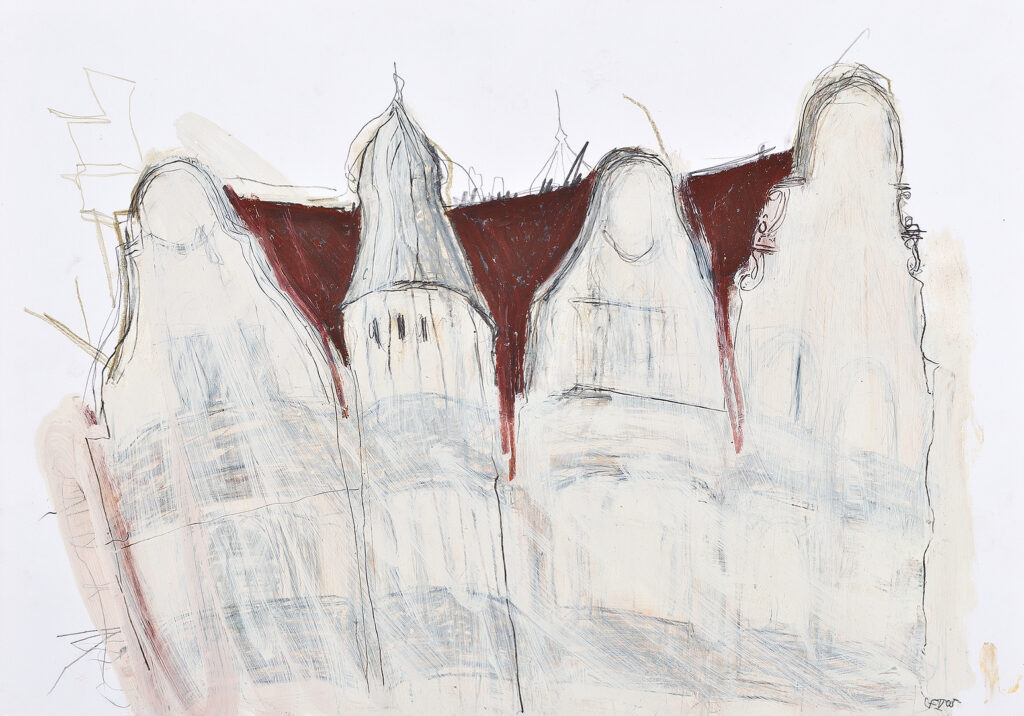
George Street 05 2005 / 50 x 70 cm / pencil, wax crayon, oil on paper
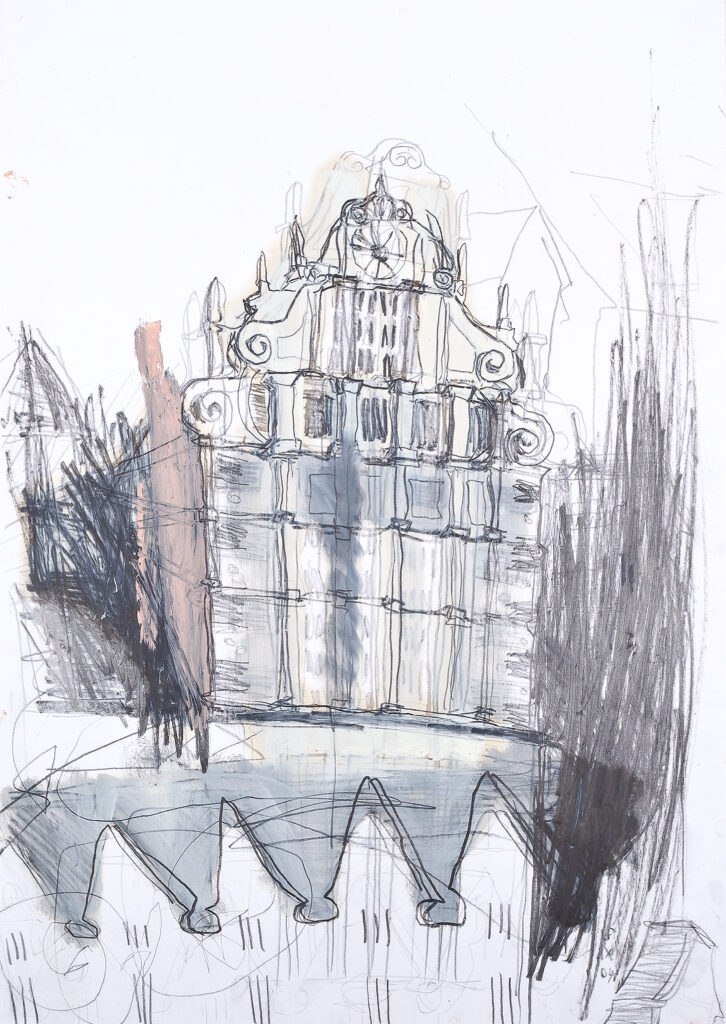
In Saalfeld 09 2004 / 70 x 50 cm / pencil, oil, oil stick on paper

Tempelhofer Ufer 04 2004 / 70 x 50 cm / pencil, oil, oil stick on paper

Dieffenbachstraße 04 2004 / pencil, oil, oil stick on paper
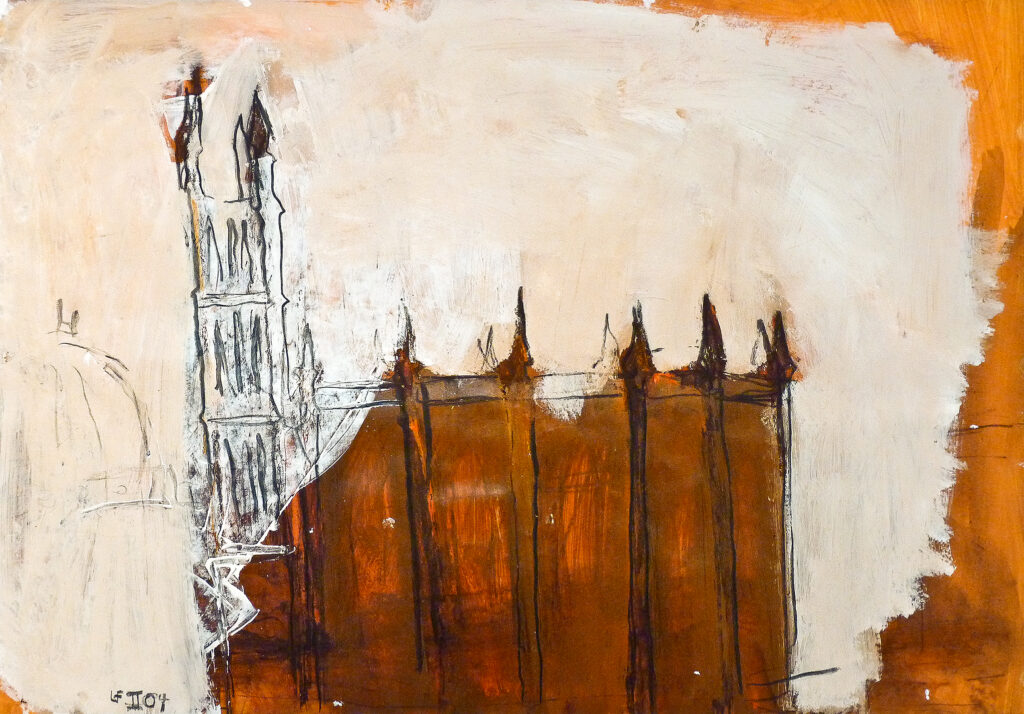
Friedrichswerdersche Kirche 04 2004 / pencil, oil, oil stick on paper
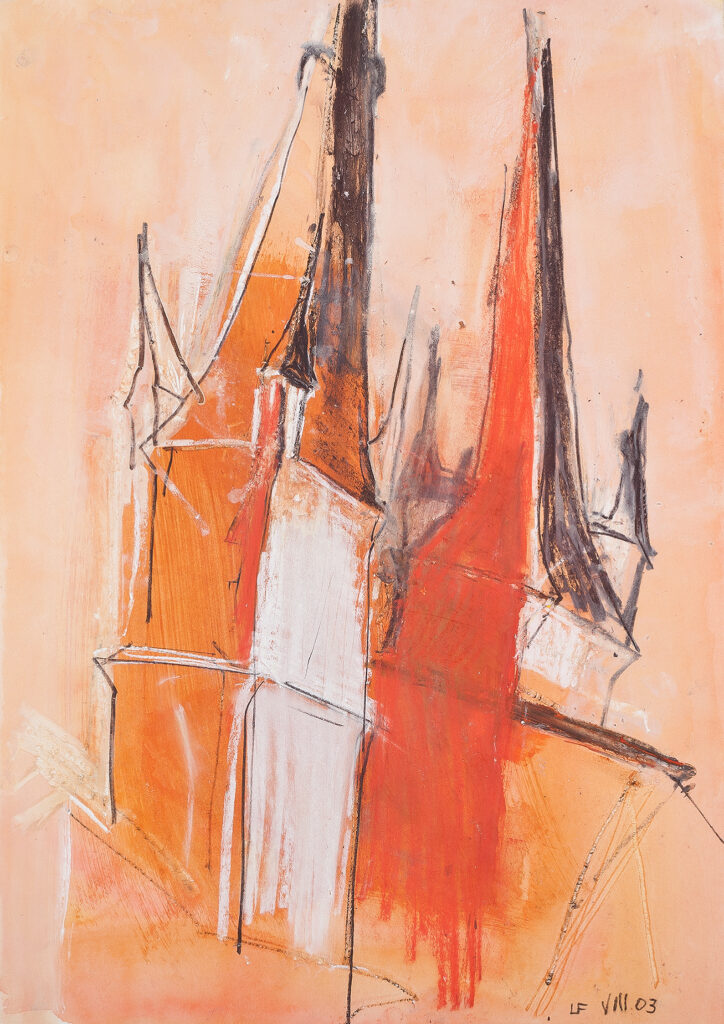
Towers in Saalfeld 03 2003 / 70 x 50 cm / charcoal, chalk, acrylics, oil on paper
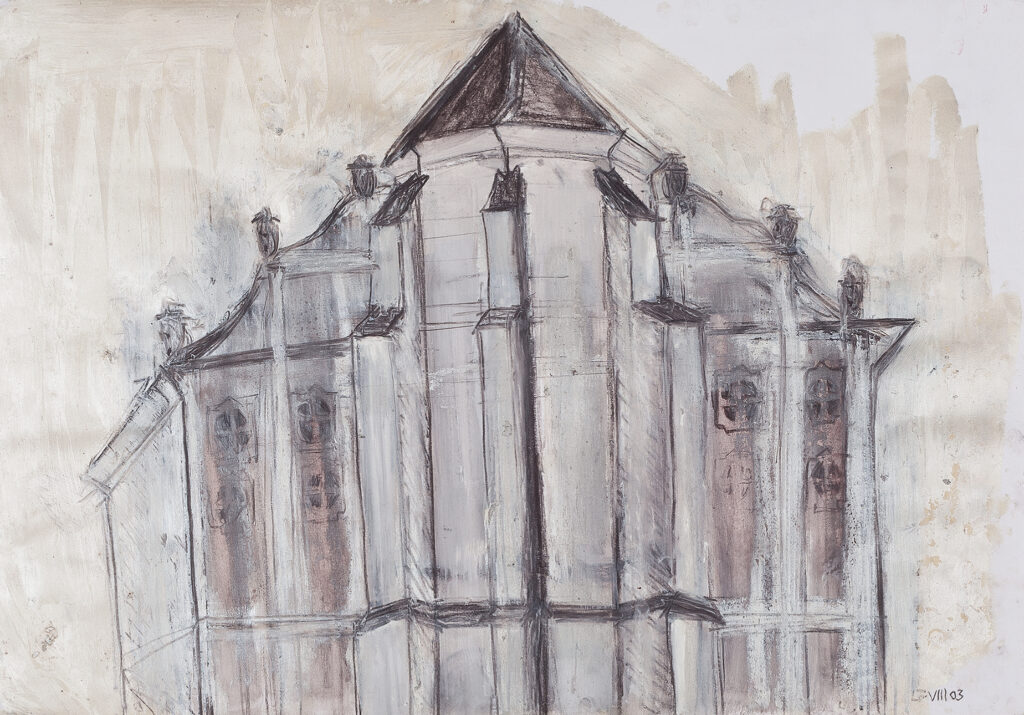
St. Michael in Bamberg 03 2003 / 50 x 70 cm / compressed charcoal, chalk, oil on paper

Trace 10 2009 / approx. 8 x 3,60 x 0,02 cm / vinyl

Detail
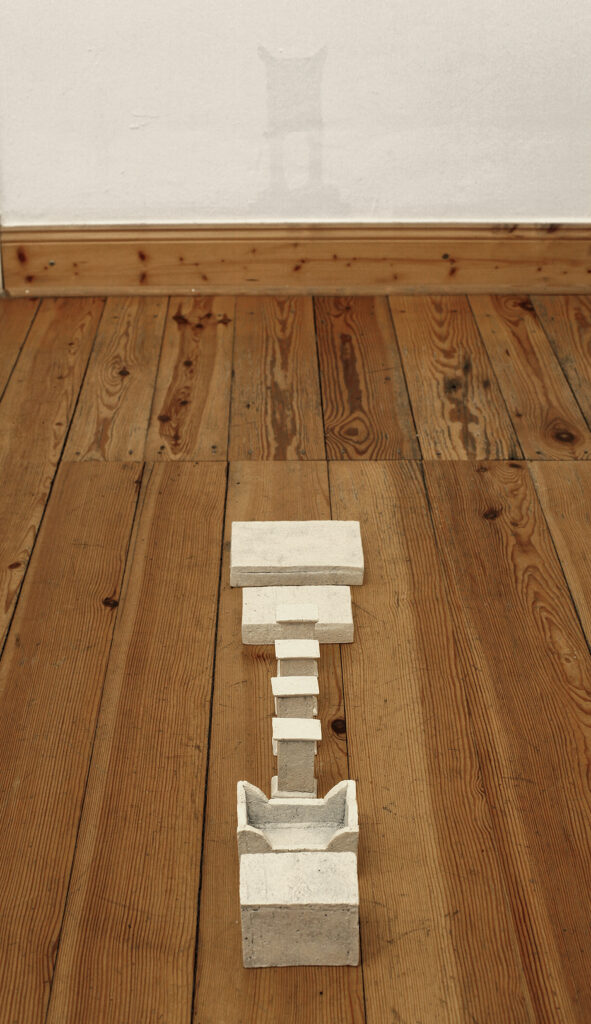
After Thought 06 2009 / variable measurements, approx. 24 x 10 x 4 cm / painted bronze, vinyl

Gable Cross 05 2009 / each 22 x 40 x 20 cm / painted polyester resin

installation view
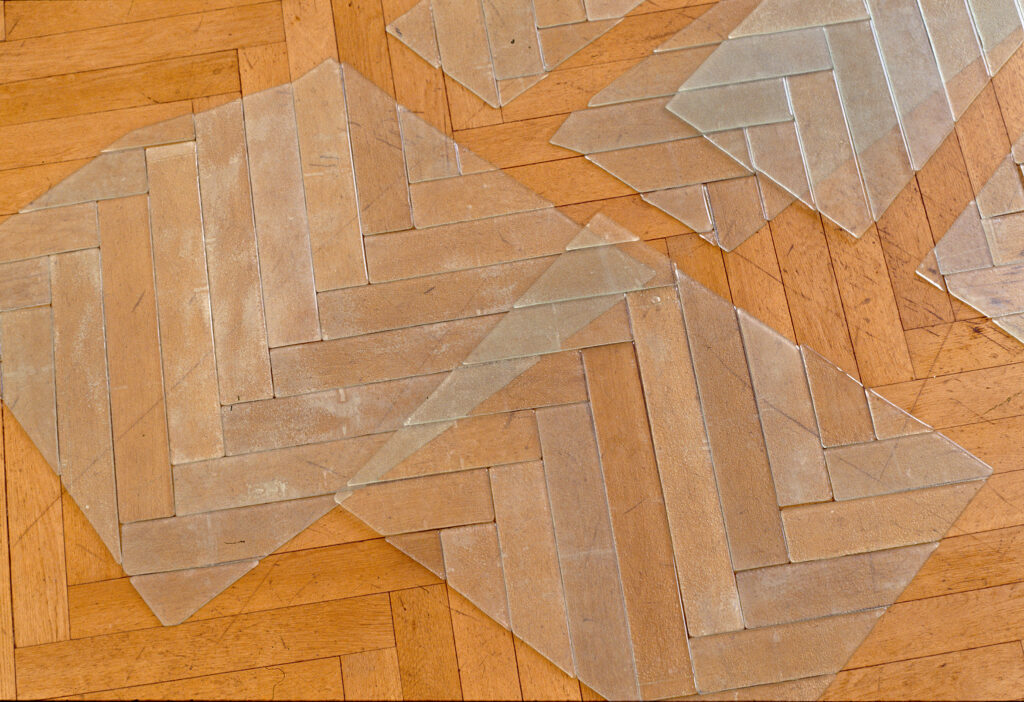
Parkett Detail / 07 2001 / variable size / approx. 350 x 210 x 4 cm / fired glass
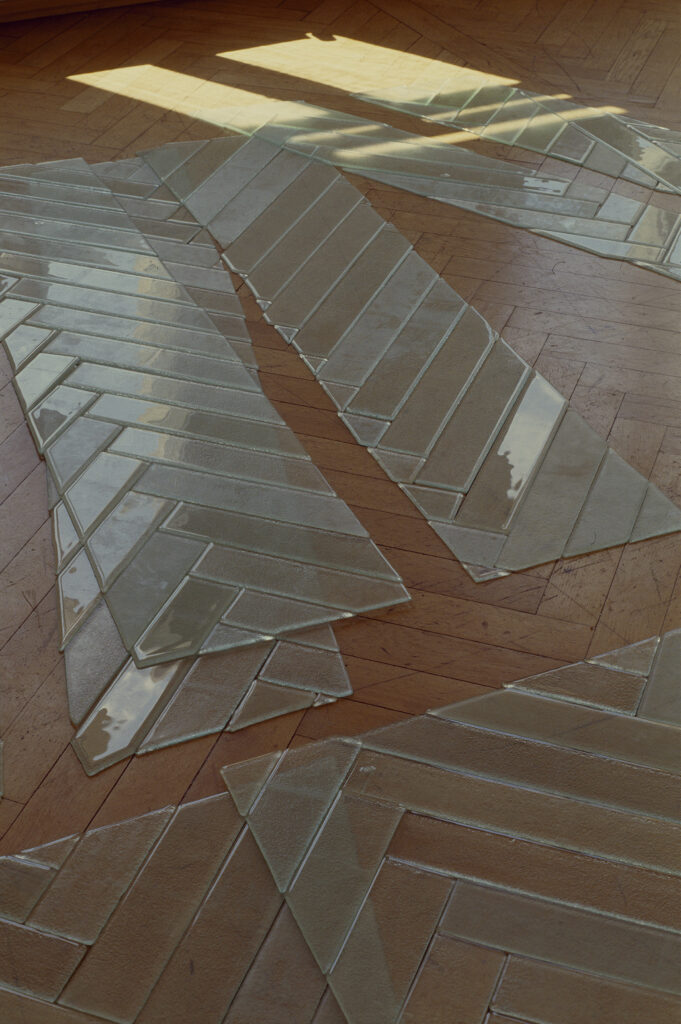
Parkett Installation view with sun / 07 2001 / variable size / approx. 350 x 210 x 4 cm / fired glass
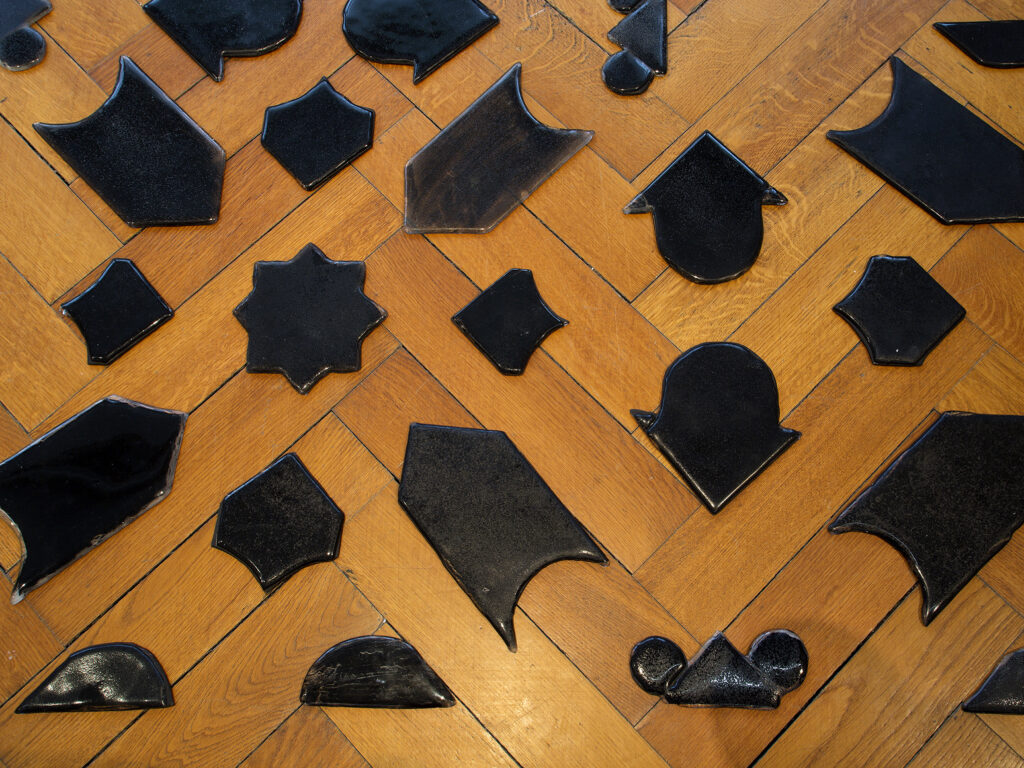
fenestral black 07 2000 / variable size / approx. 200 x 80 x 4 cm / fired glass, stained
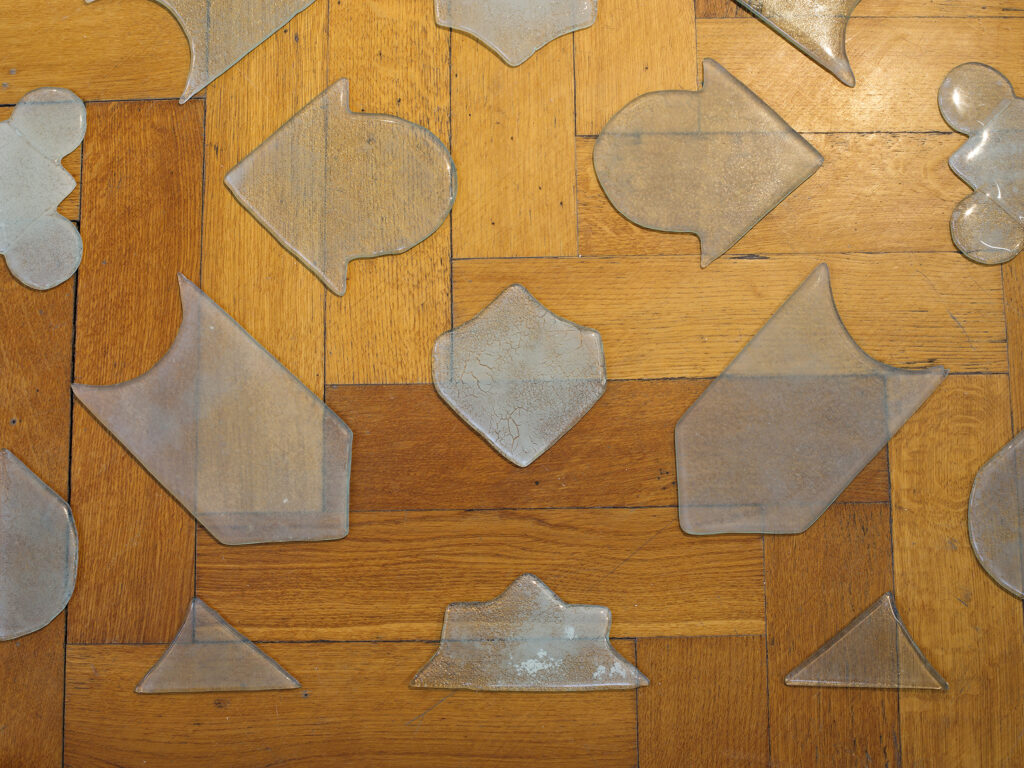
fenestral white 07 2000 / variable size / approx. 200 x 80 x 4 cm / fired glass
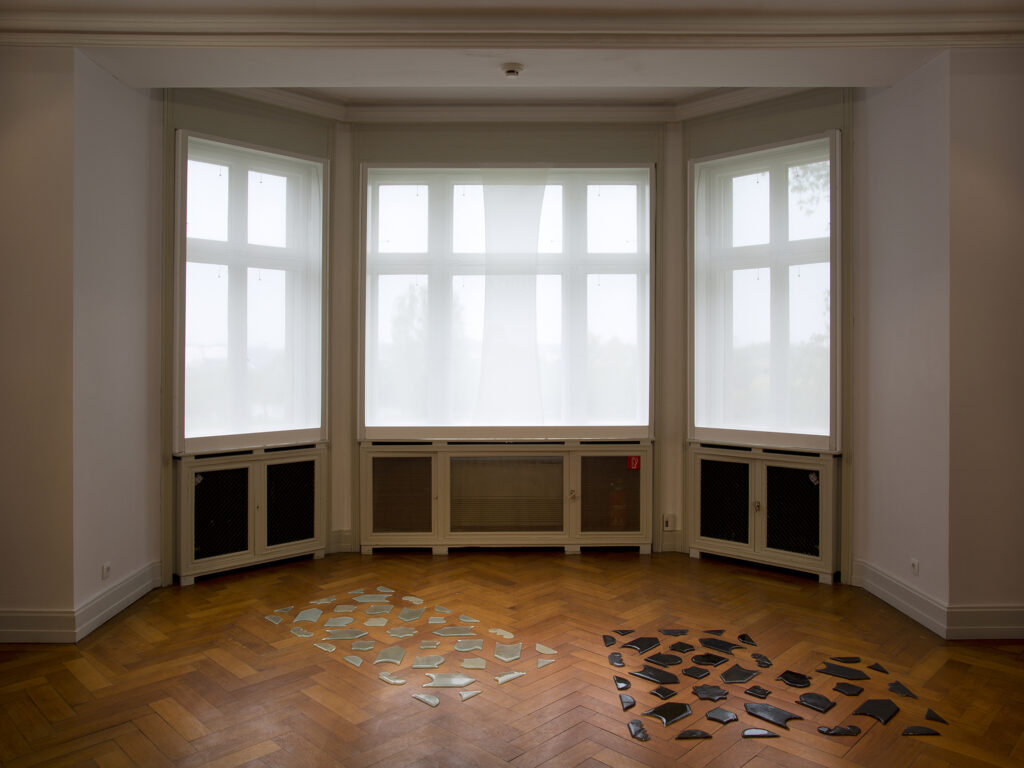
fenestral Installation view at Opelvillen, Rüsselsheim, 2014
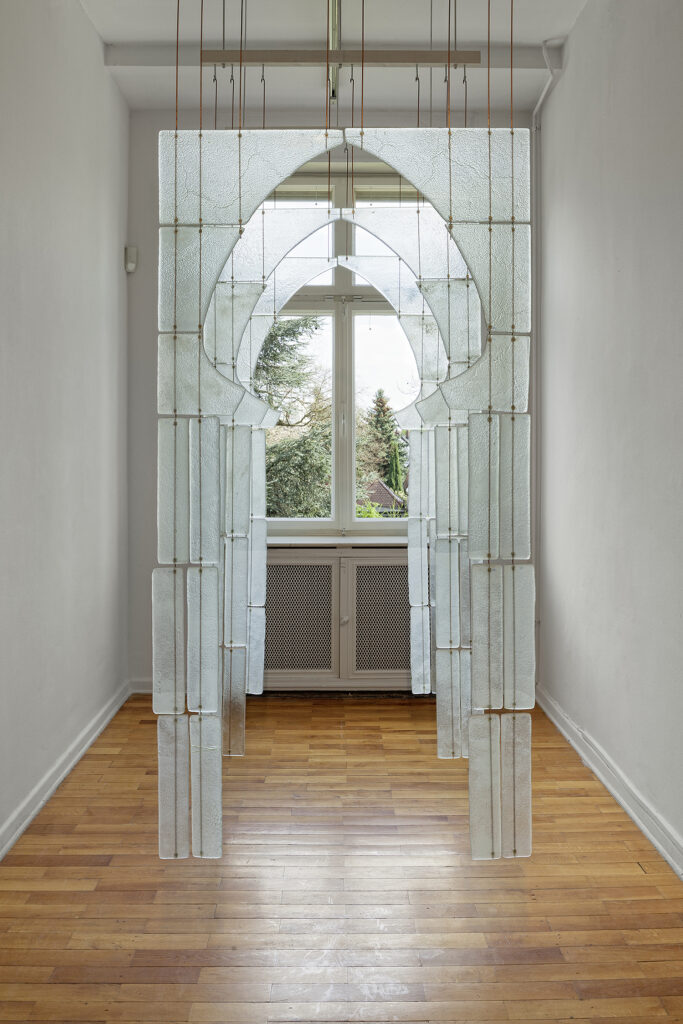
Glass Arches 07 2000 / 210 x 90 x 4 cm / fired window glass, copper rods, screws / Installation view at the Opelvillen, Rüsselsheim
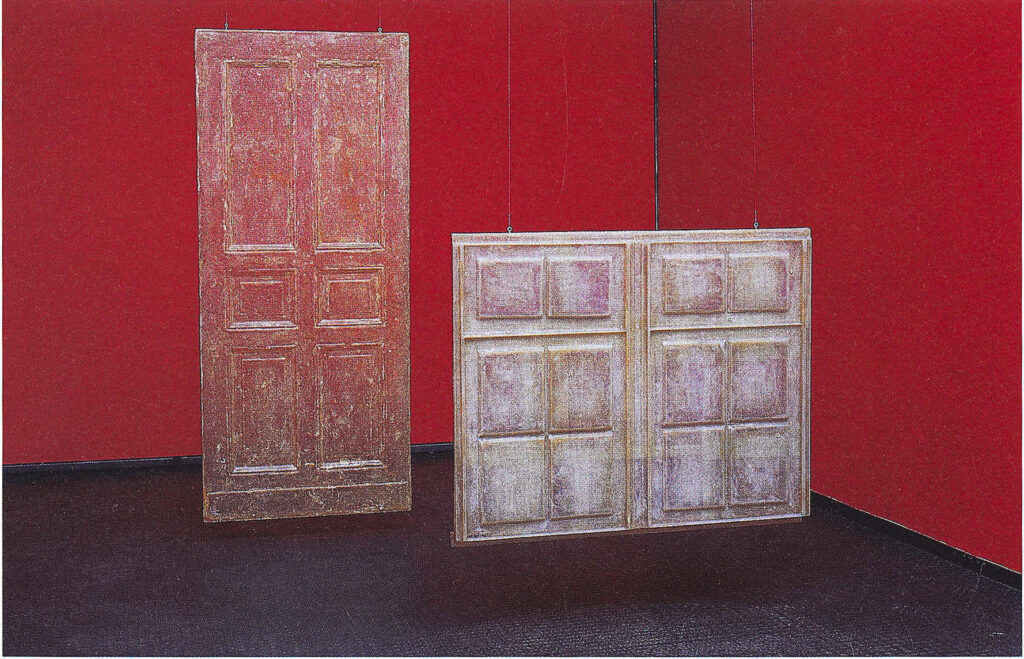
Door, English Window 02 1998, 01 2001 / 230 cm x 80 x 8 cm / polyester resin

broken up 07 2000 / 160 cm x 20 x 6 cm / polyester resin

Variationen an einer Ecke 10 1997 / je 14 x 24 x 5 cm / epoxy resin
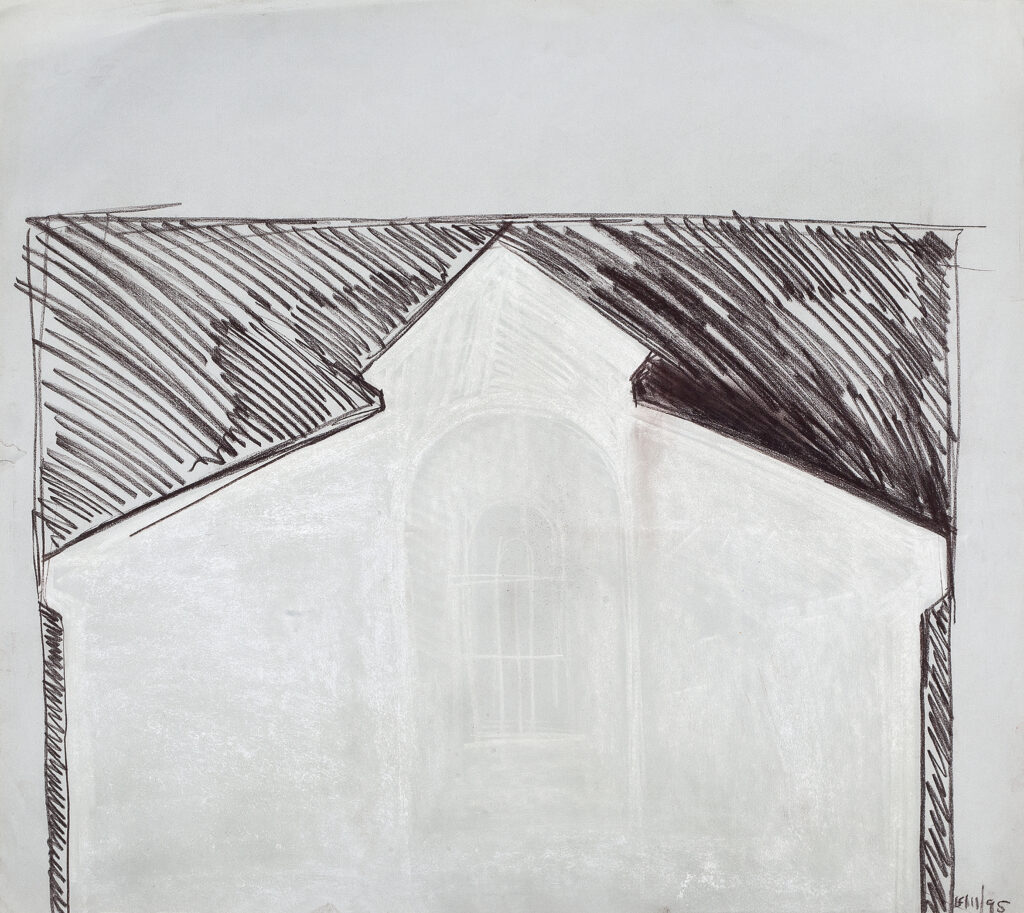
Ohne Titel 03 1995 / Condensed charcoal, chalk on paper
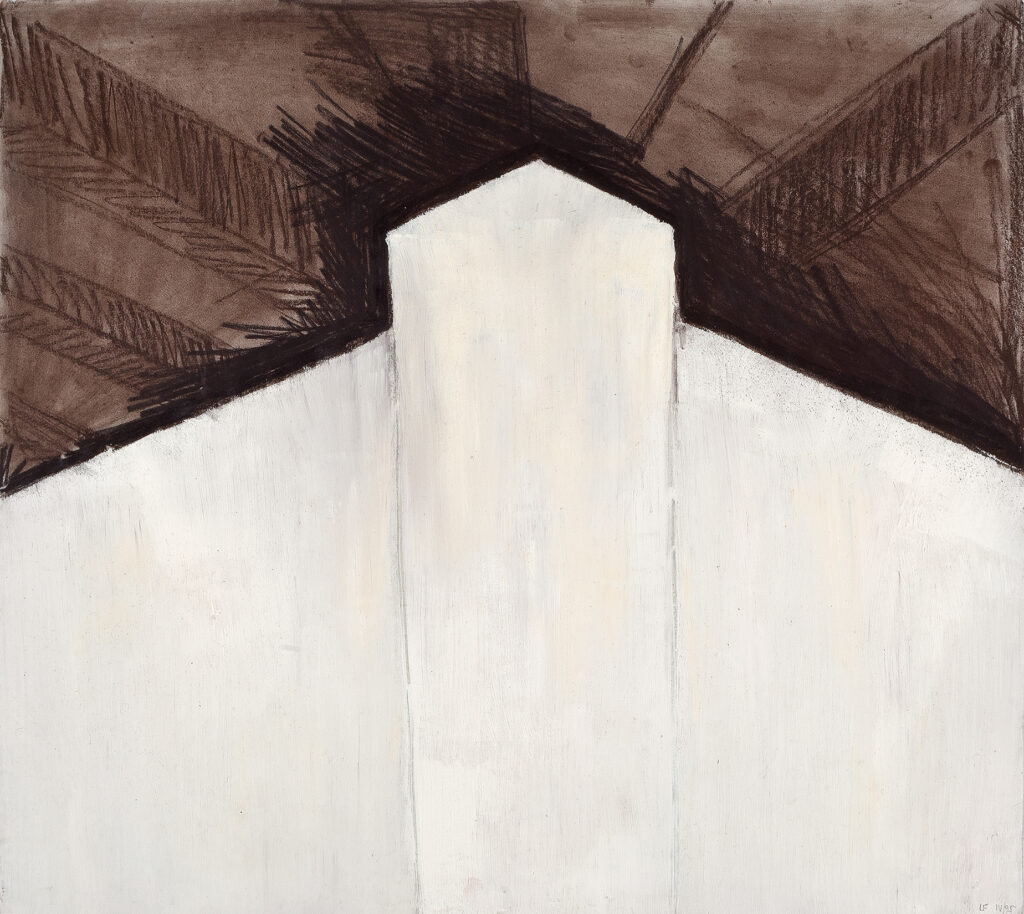
Inside out I 05 1995 / 65 x 59 cm / condensed charcoal, chalk on paper
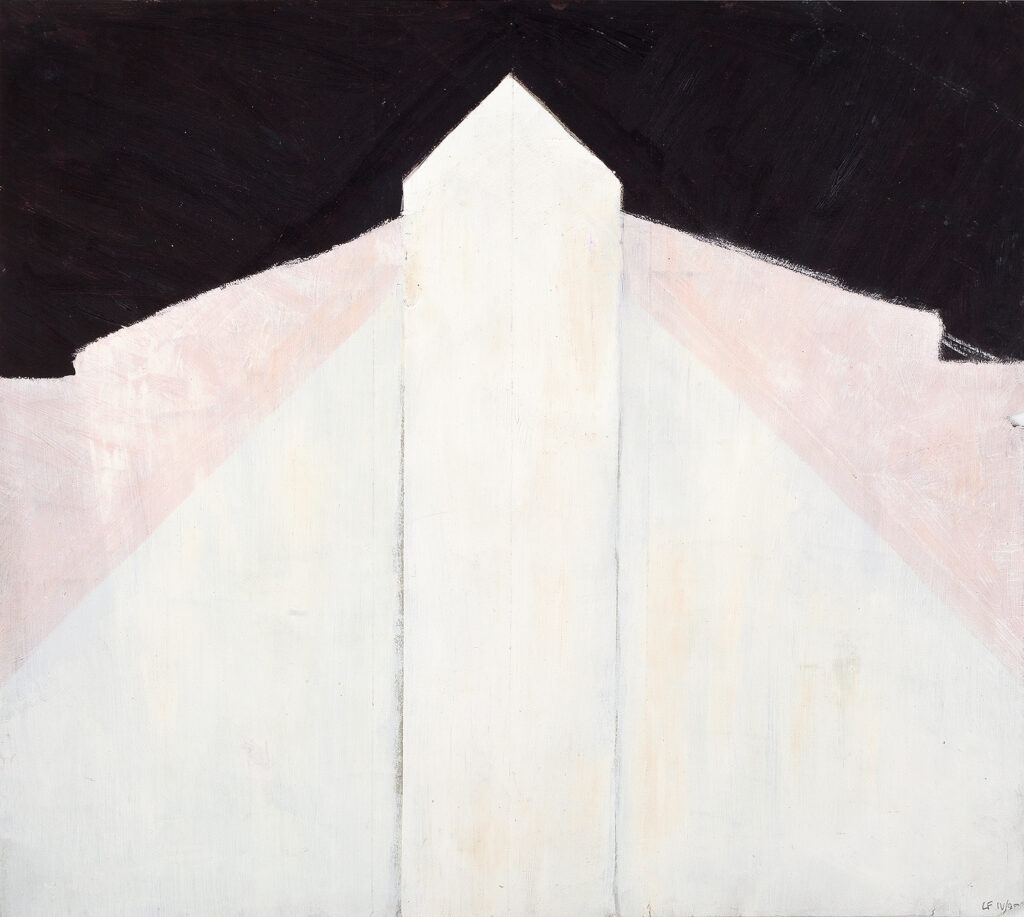
Inside out II 04 1995 / 59 x 65 cm / chalk, oil on paper

Five Towers 04 1995 / 59 x 65 cm / oil on paper
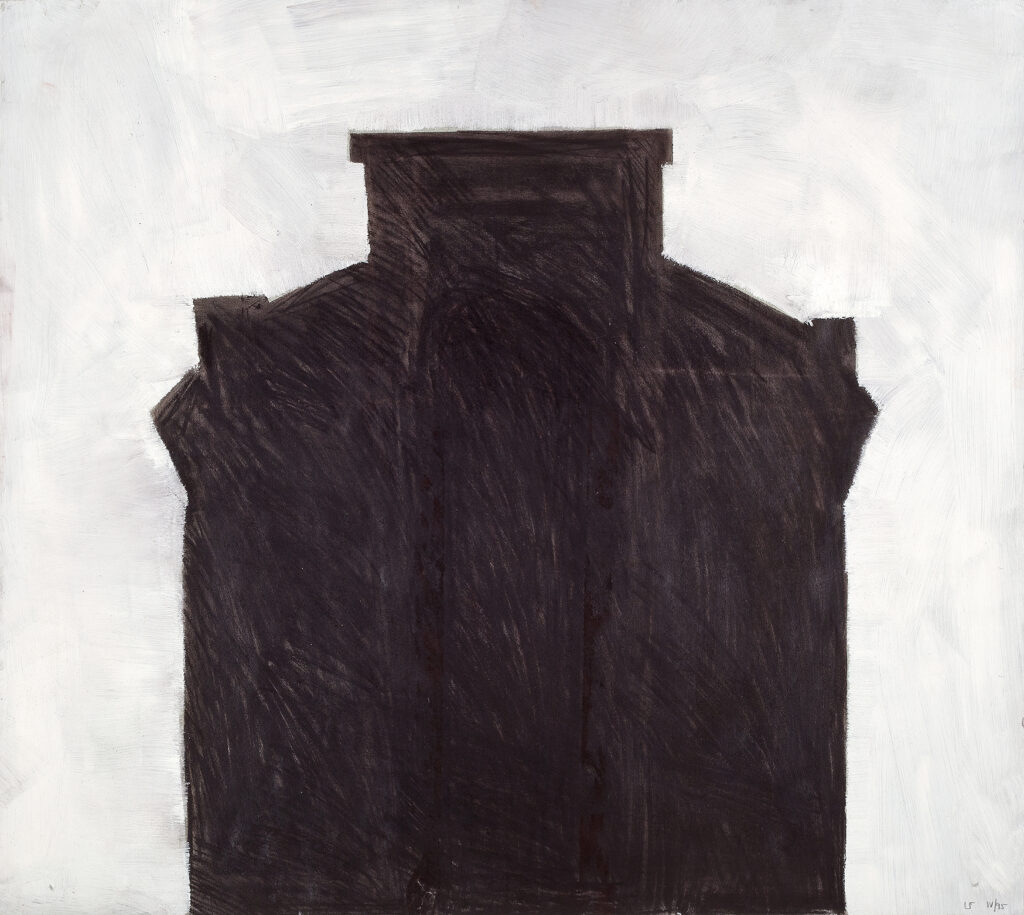
House 04 1995 / 59 x 65 cm / condensed charcoal, oil on paper

House white I 04 1995 59 x 65 cm / condensed charcoal, oil on paper
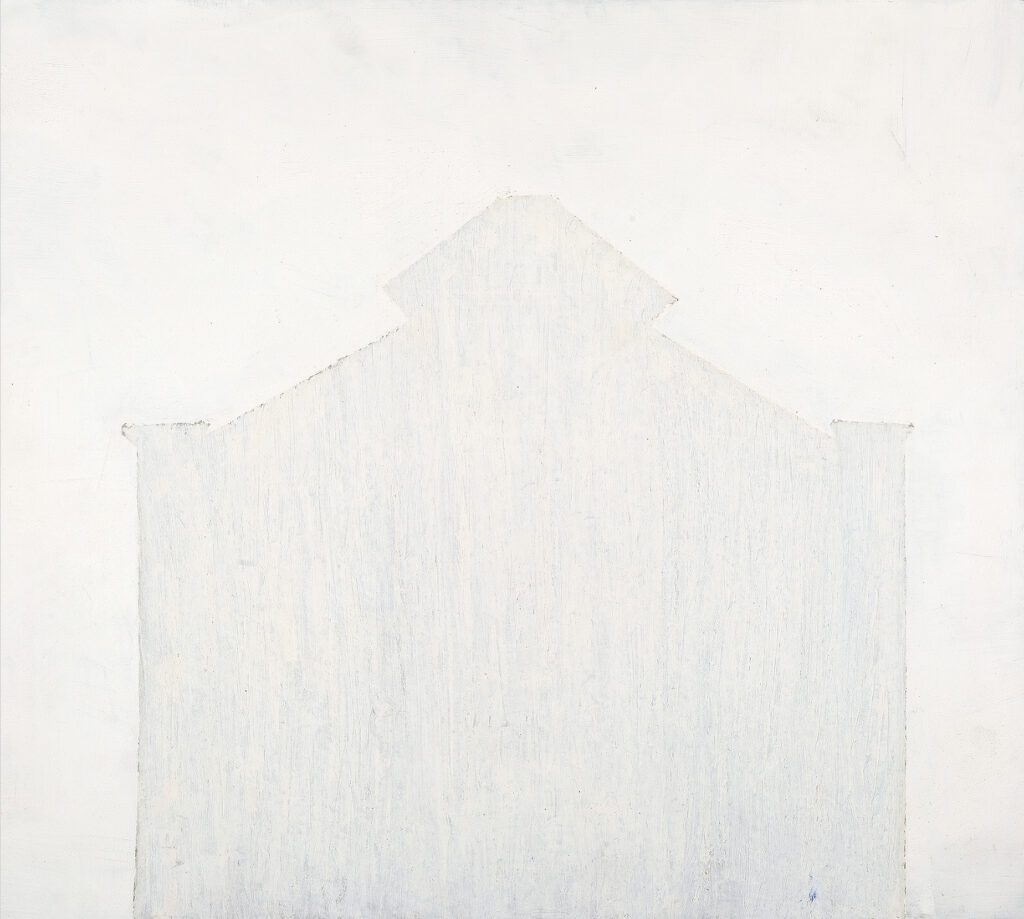
House white II 04 1995 59 x 65 cm / condensed charcoal, oil on paper
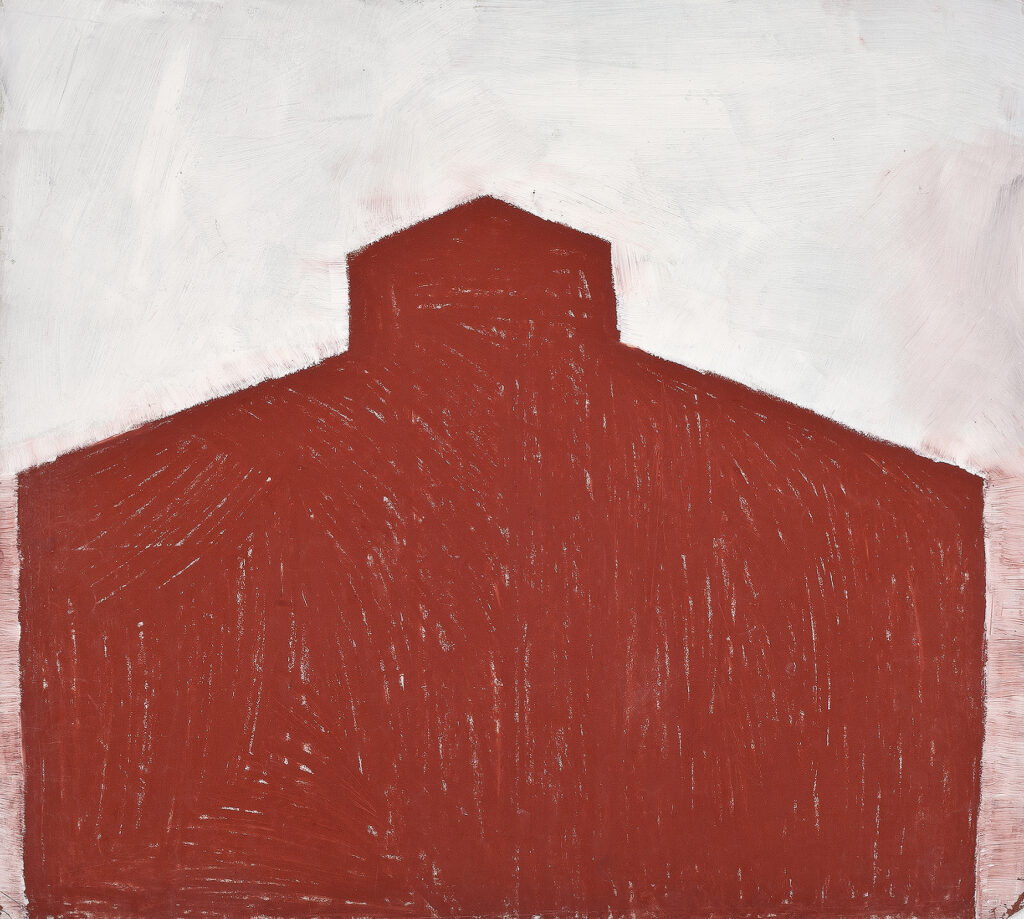
House red 04 1995 / 59 x 65 cm / wax crayon, oil on paper
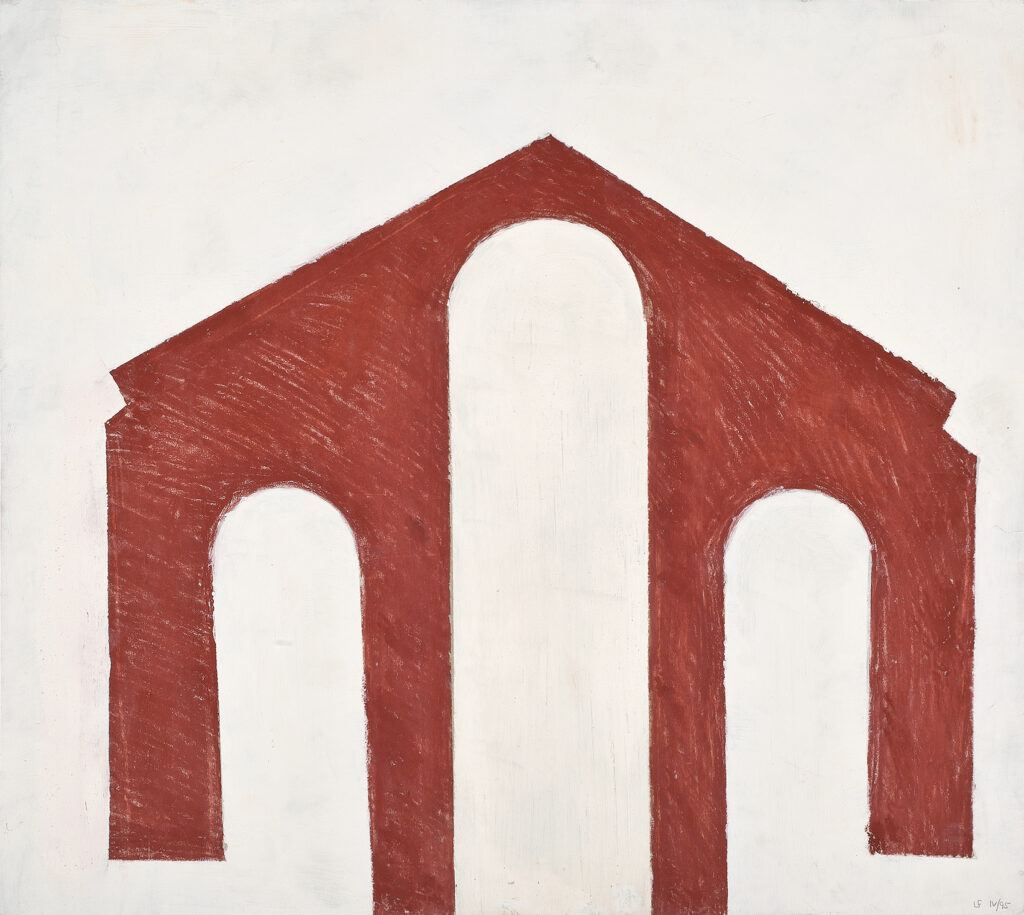
Dreiklang 05 1995 / 65 x 59 cm / condensed charcoal, chalk on paper
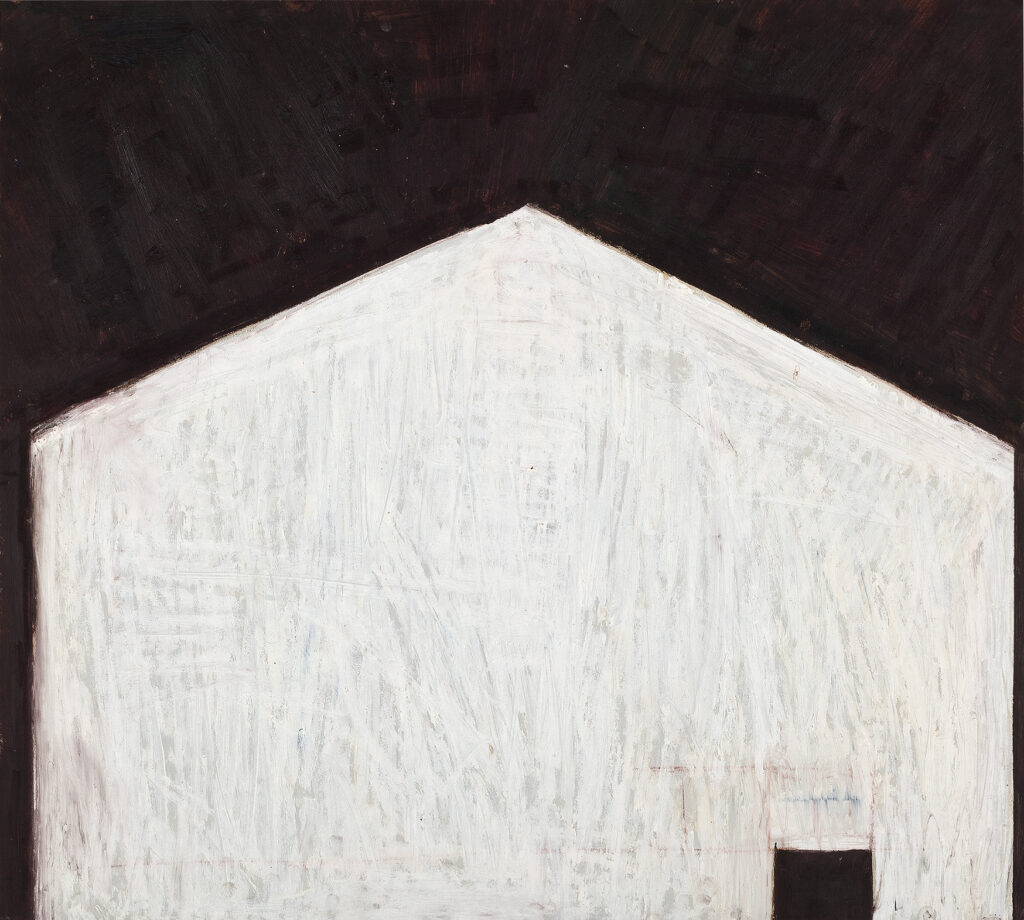
White house black door 04 1995 / 59 x 65 cm / Wax crayon, oil on paper

Lighthouse 05 1995 / 65 x 59 cm / condensed charcoal, oil on paper

Pavillion 05 1995 / 65 x 59 cm / condensed charcoal, oil on paper
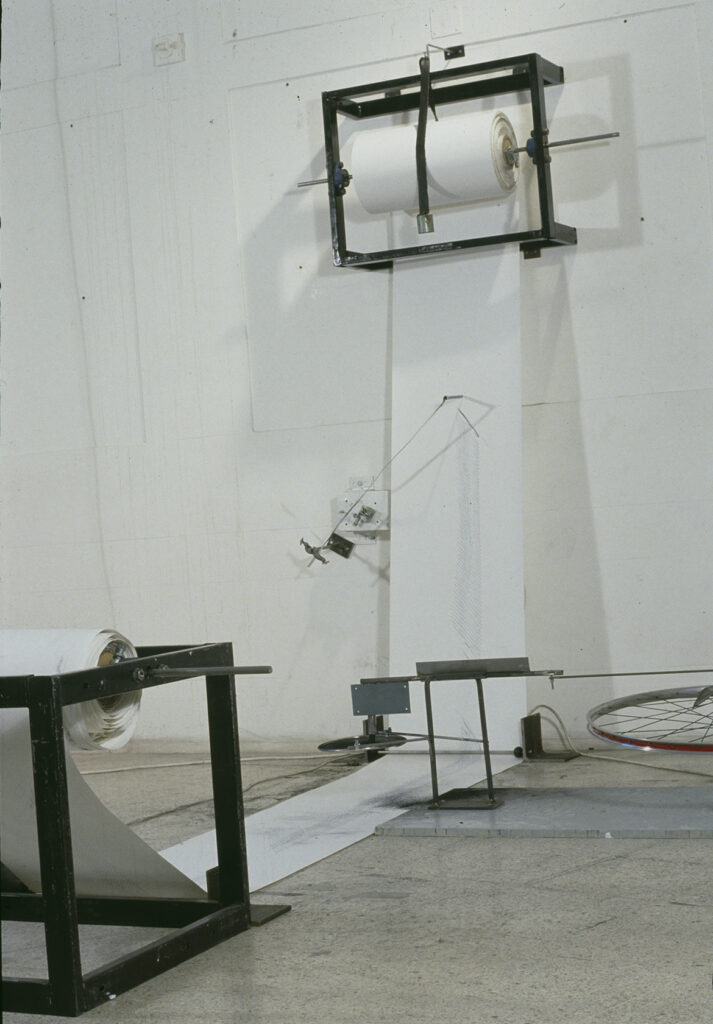
Drawing Machine 06 1993 / various parts and dimensions / stainless steel, electric motor, metal rods
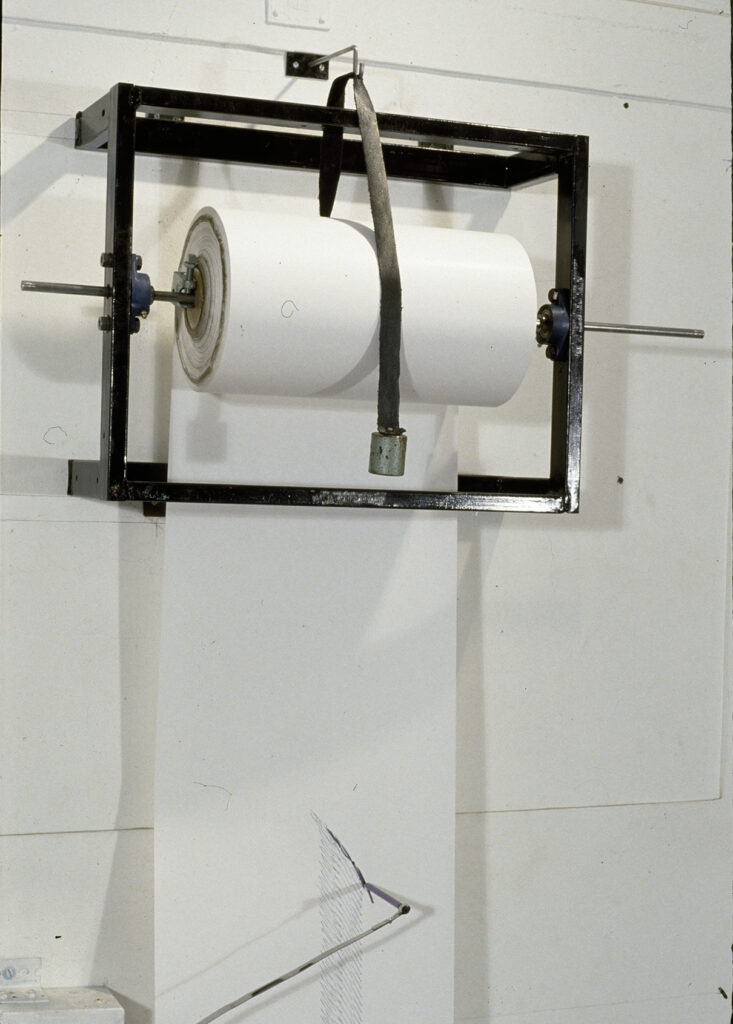
Detail

Detail

Detail
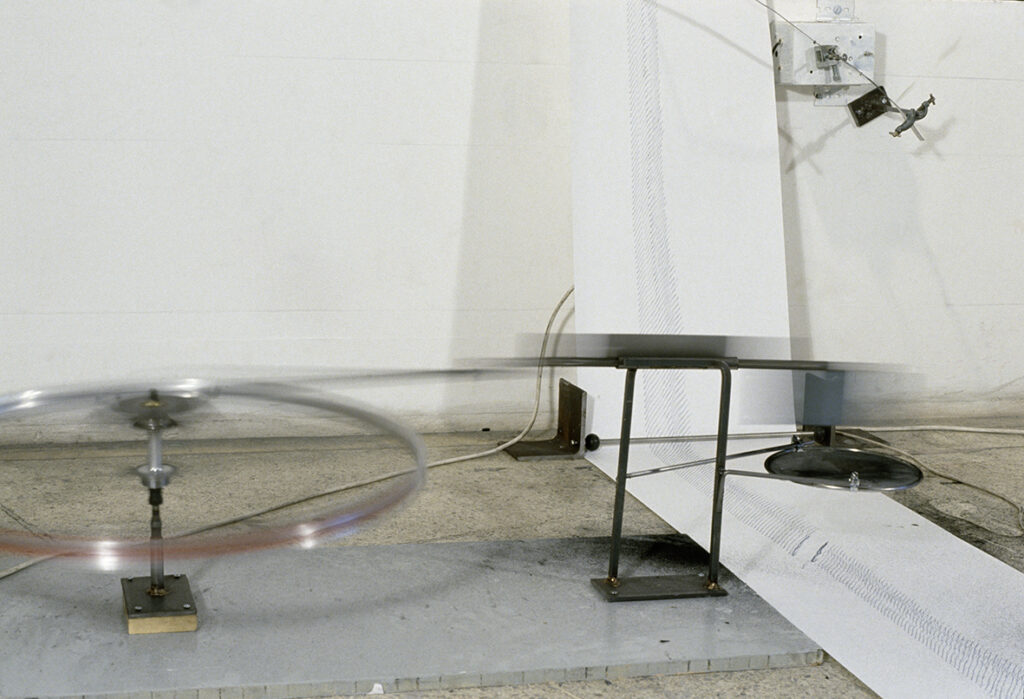
Detail
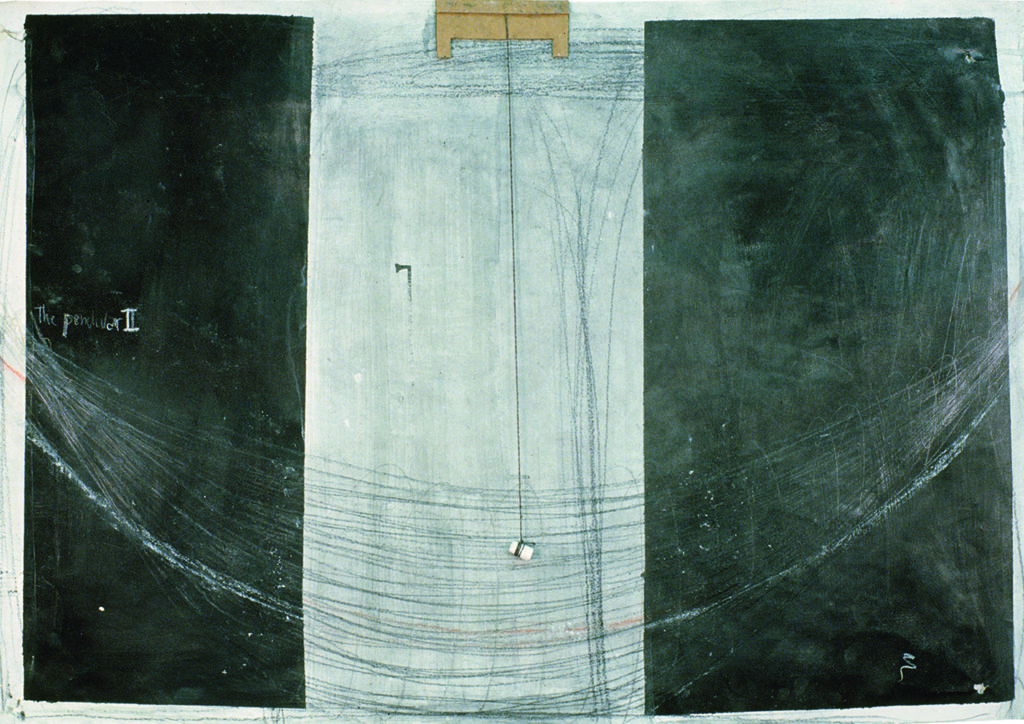
Pendular 02 1992 / 70 x 50 cm / Blackboard paint, chalk, graphite, string, cardboard on paper
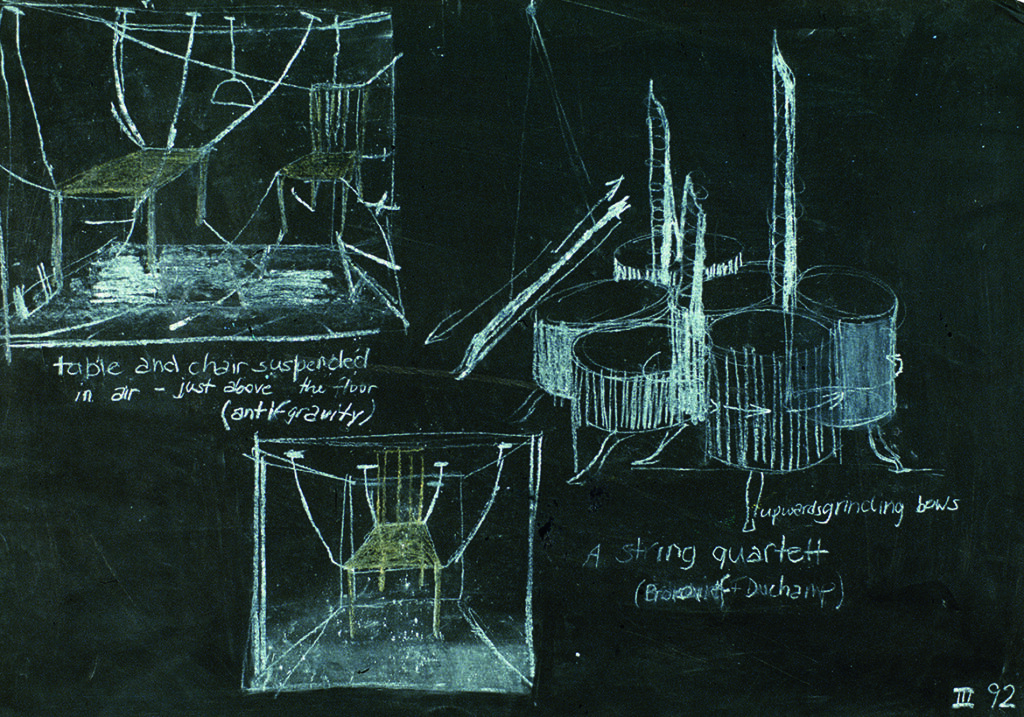
A String Quartet 03 1992 / 70 x 50 cm / blackboard paint, chalk on paper
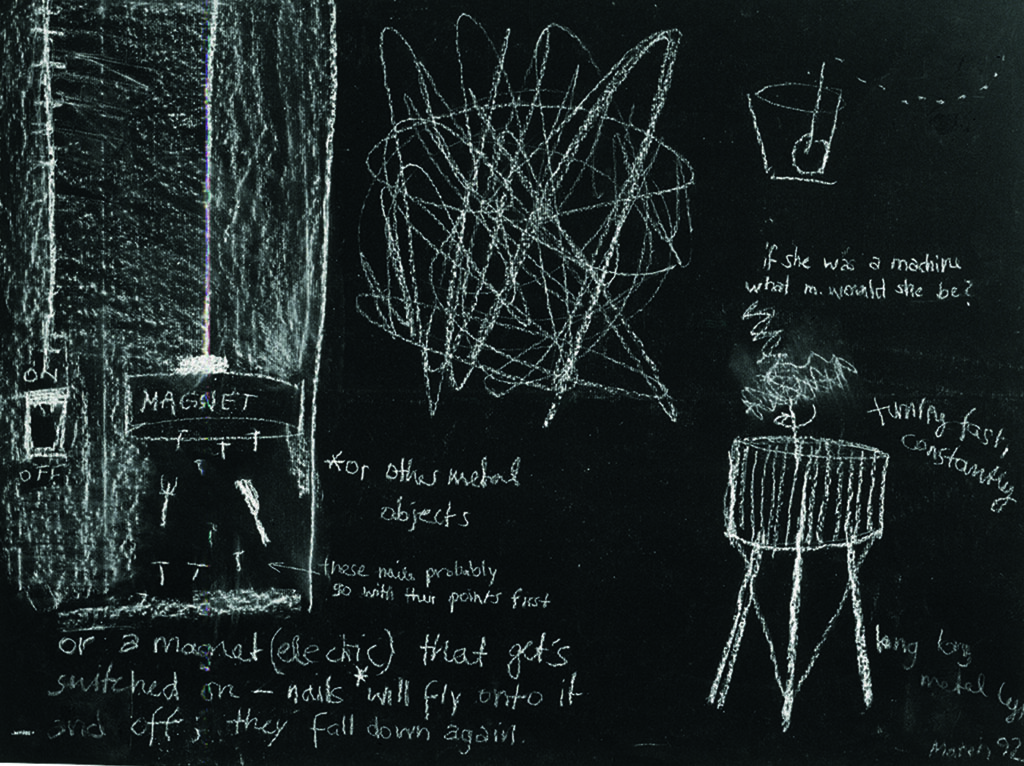
Ohne Titel (Magnet) 03 1992 / 70 x 50 cm / blackboard paint, chalk on paper

Scraping 03 1993 / 70 x 50 cm / graphite, oil, acrylic on paper

